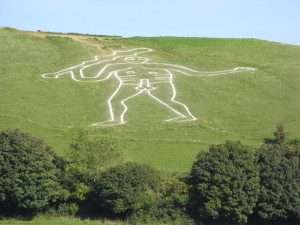
'Up Yours'? or something deeper. 'Left' arm for a 'snake'?
The Cerne Abbas Giant, mentioned in the same book, [J. Michell]..the stone age equivalent of the same. Proof...Cerne, a direct link to 'Cernunnos' and Abbas, a link to the word abbey and abba. Both an indirect link to the word 'father', i.e.,higher of the lower. Question. If the 'giant' represents 'lower', what within landscape symbolism would represent 'higher'? Think about it, in relation to a 'development,' as well as 'flat tops'[keys]. Explained within.
As well as Mr Lethbridges research on Gog Magog, in his book of the same, i.e.,pagan equivalent of higher/lower. In 'its' most primitive form. [ Explained elsewhere]. Or Mr Z. Sitchin's book, 'The 12th Planet'. Understanding this subject explains why the word 'Nefilim'[Giant] and Mr Sitchins interpretation of the same...'those who were cast down', are; to all intent and purpose; one of the same thing. I.e., a link to 'the fall' symbolism, and that link to 'lower within the higher'.
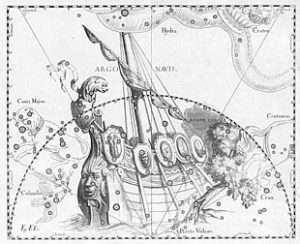
Argo = three aspects to it: "It is said that “union makes force”, and one understands by this the alliance of individual wills with a view to achieving a common aim. It is the formula for the quantitative increase of force. With respect to qualitative force, it would be appropriate to say that “unity is force”, because one is strong only in so far as there is unity of spirit, soul and body." And/or: 'The King and the Emperor ' by Rebbe Nachman.
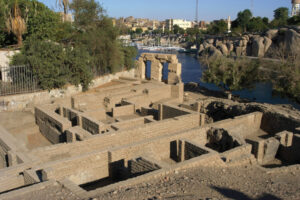
Three boulders began the temple construction through many generations. Avebury?
Side note: "The small island of Salamis, home of the Great Aias, physically the largest warrior at Troy, was linked to Argo Navis, the largest constellation in Homer's day, but since divided into three." AND/OR " only the second strongest warrior - represented with Canopus - the 2nd brightest star in the heavens. The brightest star {Sirius} allocated to Achilles the ''warrior without equal''. ['Homer's Secret Iliad'].
"Sirius is sometimes called the 'Sun behind the sun', indicating that while the star we call the Sun is related to our physical center of Self in our Solar Plexus and the expression of our Selves within the physical earth, Sirius represents a more hidden center." [From the book by W. Berg].
Question. Fantasists?
"Who were the Gog and Magog people? This question is connected with the question, who was Dhu al Qarnayn? ''Lord of two Qarns'' [horns]. Or the ''Lord of two epochs'' [i.e.,the tail end of something - and the beginning of something else]. Answer found elsewhere, as well as Sura eighteen of the Quran translated by Yusuf Ali.
And/or: ''Pandora is one of the earliest synpotic accounts of alchemy, and it may be the first that was written in German....The author was the physician Hieronymus Reusner who was a student of Paracelsus...The chief value of Pandora lies in the series of the eighteen symbolical pictures at the end of the volume.'' [Page 144 'Alchemical Studies' / C.G. Jung].


Ayumu Hirano - the corkscrew 'spiral' king.
"The number 18, which appears in pre-Columbian measures of time, has a certain importance in the West. This may be explained by the connection to the circular number 360, or possibly with an astral number, since eclipses of the sun and moon recur in the same sequence after 18 years. It is not surprising that 18 plays a role in the Cabala, for its numerical number corresponds to the word for living [hay], as well as the name David...In medieval Christianity exegesis it is sometimes explained as the sum of 10 + 8, which is taken to mean the fulfillment of the Law through grace. This interpretation was derived from Luke 13:11, where it is told that Jesus healed a woman who had a spirit of infirmity for 18 years, [those numbers 13:11 also imply something. This readers input]. Elsewhere, the number was taken as the product of 3x6, which represents faith in the Trinity coordinated with pious works. Islamic tradition knows the 18 consonants of the introductory formula Bismi'llahi'r - rahmani'r - rahim [''in the name of god the all merciful, the all compassionate'']. Perhaps the common idea that there are 18000 worlds is derived from the number of the blessed formula by which every act has to begin. For the Mevlevi, the Sufi order of the Whirling Dervishers, 18 is one of the central numbers..." [Extract from 'The Mystery of Numbers'. Mentioned elsewhere].
"One can escape the prison of the eclipse, only by turning to the moral consciousness of the transcendent self..." [Extract from the book by Tomberg]. Try Part 4.
Moon and Sun. As a means...?
Side note: ''Before eating Nikola Tesla - 'the father of electricity' - polished each piece of cutlery with eighteen napkins''. [QI Elves].
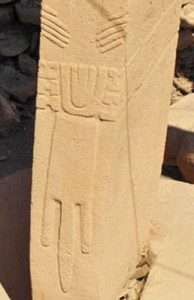
''Then one day she dares to enter the synagogue when he is teaching. She watches Jesus approach a woman crippled for 18 years. He puts his hand on the woman’s stooped back and immediately she straightens up {'right angle'?}. Surprise, delight, and anger ripple through the onlookers. The synagogue leaders challenge the morality of his healing on the Sabbath. With an unpretentious authority Jesus holds his ground, exclaiming that it was only right that this woman, bound by Satan, be set free on the Sabbath day (Luke 13:10-17).'' [Novena: 'Nine Days With Mary Magdalene' / Magdala/Israel / 2022].
“If I drive out demons by the finger of God, then the kingdom of God has come upon you.” [Luke 11:20].
''Transforming fingers''?
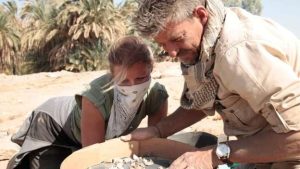
Among other 'discoveries' found at Gebel el Silsila is the engraving of an Egyptian physician performing his duties - which are inscribed within a 'right angled' segment that was hewn out from a 'circular' boulder/rock. AND/OR: When Jesus heard it, He said unto them, “They that are WHOLE have no need of the physician, but they that are sick. I came not to call the righteous, but sinners to repentance.” {Mark 2:17}. 'Metanoia' to enlarge. ALL FOUR SIDES? And/or: "So Christian paideia has survived to this day, but primary among the more ascetic members of the monastic movement {Desert Fathers?}, the rigors of whose methods {asceticism did not always imply hardship in the way it does now} have helped to discredit it with the general public. Gospel teachings about the 'strait gate' and 'narrow way' refer in their simplest sense to the difficult choice that must be taken at this point, where we must go beyond the point which we can see; beyond what we can control. This choice is well described in the Gospel verse that says: 'And he went a little further, and fell on his face, and prayed saying, O my father, if it be possible, let this CUP pass from me: nevertheless not as i will, but as thou wilt'. {same} 'PLACE OF ROWING'?
A working example: ''The way of 'marriage' seems fraught with....all consuming passion. More often than not, the hungry inner self has been eclipsed by the outer personality....Within these eclipsed areas - where our needs, wants and beliefs remain secret, even to ourselves - lies ones shadow....Two halfs never created a whole but only another half so long as the shadow remains eclipsed.'' [Pages 84/85/104 'Dreams of Isis: A Womans Spiritual Sojourn' / N. Ellis].
''Called by astronomers the First Point of Aries, this junction where the sun crosses the equator in its northward journey marks zero point in the measurement of right ascension which can be conceptualized as celestial longitude.'' [Page 117 'The Orion Zone' / G. A. David].
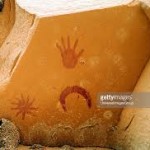 Side note: And/or {something to ponder on}: "And it was not only during the darkest time of the year - when the nights are at their longest - but it was also under the sign of 'virgin intelligence' eclipsed by human terrestrial intelligence that the nativity of Jesus Christ took place...Do not be scandalised, dear Unknown friend, by the fact that you find yourself confronted with the rosary prayer in the Hermetic meditation on the 18th Arcanum of the Tarot - the Arcanum which teaches how to surmount 'eclipsed lunar intelligence'. Esotericism is not a collection of extraordinary and unknown things, but rather it is above all a less ordinary and less known way of seeing ordinary and known things - of seeing their profundity." [Pages 499/516 'Letter 18, The Moon, within the book 'Meditations on the Tarot'].
Side note: And/or {something to ponder on}: "And it was not only during the darkest time of the year - when the nights are at their longest - but it was also under the sign of 'virgin intelligence' eclipsed by human terrestrial intelligence that the nativity of Jesus Christ took place...Do not be scandalised, dear Unknown friend, by the fact that you find yourself confronted with the rosary prayer in the Hermetic meditation on the 18th Arcanum of the Tarot - the Arcanum which teaches how to surmount 'eclipsed lunar intelligence'. Esotericism is not a collection of extraordinary and unknown things, but rather it is above all a less ordinary and less known way of seeing ordinary and known things - of seeing their profundity." [Pages 499/516 'Letter 18, The Moon, within the book 'Meditations on the Tarot'].
Question. ''Surmount'' in relation to an 'overhang'?
N.B. ''Prayer'' is only one method of 'overcoming' that obstacle. A Study program does the same. If ONLY in determining a mind-set.
Side note: The author of the book 'The Death of Gods in Ancient Egypt' {J. Sellers} - believes that the eclipse {of the sun ONLY} was used along with precession as part of their religion. Even though there is no written evidence of it. Indeed they did - and not just solar ones. An ''eclipse'' is a natural feature of this world - the world that we all live in - and is used {especially by the ancients - before the written word came into common use - } to 'describe' something internal. That external quantity is used to 'see' something of an inner quality.
Try Her-Bak to take it further. And/or 3:6 etc.
"When you pray and study, let {my words} not forsake you''. [Paraphrase of Proverbs 4:21. Taken from the book 'Meditation and Kabbalah].
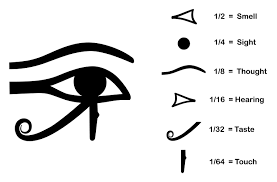
A studious eye?
A working example: ''One book opens another: the philosopher tells us truly. There is no understanding of the Art without long and anxious study of those texts in which the 'angelic' keys to our Philosophy are concealed. However, to the uninitiated eye, the bogus recipes of some imbecile puffer can appear as wise as the works of the Bridlington Canon {i.e., Ripley}. [Page 55 'Mercurius' / P. Harpur].
Question. Hocus pocus or a genuine mind set?
Side note: Speculation about what that 'star' could have been - around the time of the 'birth' of Christ: ''There was a lunar eclipse one month before 'Passover' in the year Herod died {4BC}." {'Sky at Night' / Xmas edition}.
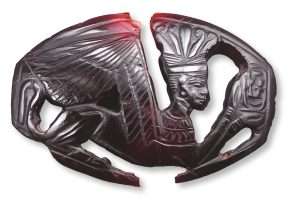
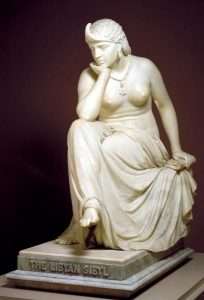
Sphinx is to 'fire' as Sibyl is to 'Soul'.
''Paschal full moon. The paschal full moon is the ecclesiastical full moon of the northern spring and is used in the determination of the date of Easter. The name "paschal" is derived from "Pascha", a transliteration of the Aramaic word meaning Passover.''
Side note: "Eastertide (also known as Eastertime or the Easter season) or Paschaltide (also known as Paschaltime or the Paschal season) is a festal season in the liturgical year of Christianity that focuses on celebrating the Resurrection of Jesus Christ. Preceded by Lent, it begins on Easter Sunday, which initiates Easter Week in Western Christianity, and Bright Week in Eastern Christianity.
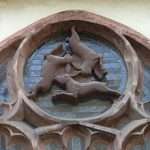
Man in the moon?
There are several Eastertide customs across the Christian world, including flowering the cross,[1] sunrise services, the wearing of Easter bonnets by women,[2] exclaiming the Paschal greeting, clipping the church,[3] and decorating Easter eggs, a symbol of the empty tomb {?}.
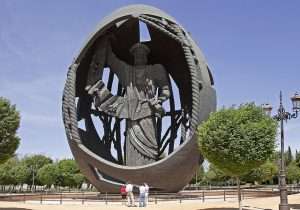
''The Birth of the New Man.'' 'Egg/Incarnation' to enlarge
Additional Eastertide traditions include egg hunting, eating special Easter foods and watching Easter parades.[7][8] The Easter lily, a symbol of the resurrection in Christianity,[9][10] traditionally decorates the chancel area of churches on this day and for the rest of Eastertide.[11]
Traditionally lasting 40 days to commemorate the time the resurrected Jesus remained on earth before his Ascension, in some western churches Eastertide lasts 50 days to conclude on the day of Pentecost or Whitsunday."
It falls on the seventh Sunday after Easter and commemorates the descent of the Holy Spirit upon Jesus’ disciples (as described in Acts 2)......
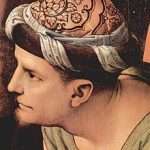

Milky white?
The name is a contraction of "White Sunday", attested in "the Holy Ghost, whom thou didst send on Whit-sunday"[11] in the Old English homilies, and parallel to the mention of hwitmonedei in the early 13th-century Ancrene Riwle.[12] Walter William Skeat noted that the Anglo-Saxon word also appears in Icelandic hvitasunnu-dagr, but that in English the feast was called Pentecoste until after the Norman Conquest, when white (hwitte) began to be confused with wit or understanding.[13] According to one interpretation, the name derives from the white garments worn by catechumens, those expecting to be baptised on that Sunday.[14] Moreover, in England white vestments, rather than the more usual red, were traditional for the day and its octave.[citation needed] A different tradition is that of the young women of the parish all coming to church or chapel in new white dresses on that day.....
Whit had been the occasion for many varied forms of celebration, and was of significant cultural importance. It was a custom for children to receive a new set of clothes, even among the poorest families, a tradition which continued well into the 20th century.[6][7]
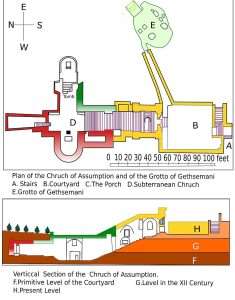

Division.
And/or: "In C. A. Gaskell's Classic Myth's, we note that the Three Fates {Clotho, Lachesis and Atrophos} were the spinners of the thread of human destiny. They were provided with SHEARS, with which to cut off when they pleased, and, according to Hesiod, were the daughters of the night. Clotho held the distaff, Lachesis spun the thread, and Atrophos cut it off when it was ended....We are informed that the Fates dwelt in the deep abyss of Demogorgon, and with UNwearied fingers drew out the threads of life...Gemini is the branching-off month or period of the year...It has to do, in utero, with the branching off of the nerves from the head, to form the body. The distaff refers to the base of the brain, where seventyfive percent of the nerves of the head concentrate and cross, appearing to wind upon themselves {'PEG'?}....The Three Fates are therefore concerned with the three decans of Gemini. Clotho, the youngest, is allocated the first decan - holder of the distaff. Lachesis spins and draws out the thread, while Atrophos DIVIDES it so that it may form the great nerve branch in either legs....In some mythological pictures {and/or hieroglyphs/correspondences} - the thread is represented as first appearing at the FEET of Jove {'footstool'?} and his heavenly spouse...The etymology of the word 'shear' corresponds to "the parting or fork of the human body" {'Y'?} - hence the limbs. An archaic interpretation of shear is to make an incision or cleft...
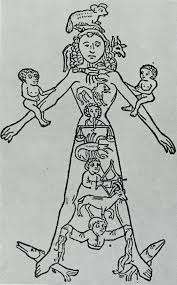
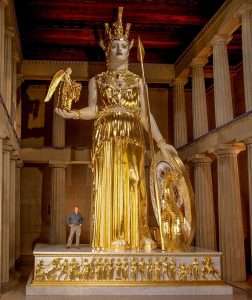
Chryselephantine statues were built around a wooden frame with thin carved slabs of ivory attached, representing the flesh, and sheets of gold leaf representing the garments, armour, hair, and other details. In some cases, glass paste, glass, and precious and semi-precious stones were used for detail such as eyes, jewellery, and weaponry.
And/or: Here is a mystery connected with the line 'I am a shining tear of the sun', because Deorgreine, 'tear of the Sun', is the name of Niamh of the Golden Hair, the lovely goddess mentioned in the myth of Laegaire mac Crimthainne. Celestial Hercules when he passes into the month F, the month of Bran's alder, becomes a maiden. This recalls the stories of such sun-heroes as Achilles', Hercules and Dionysus who lived for a time disguised as girls in the women's quarters of a palace and plied the distaff. It also explains the 'I have been a maiden', in a series corresponding with the Amergin cycle, ascribed to Empedocles, the fifthcentury B.C. mystical philosopher. The sense is that the Sun is still under female tutelage for half of this month—Cretan boys not yet old enough to bear arms were called Scotioi, members of the women's quarters—then, like Achilles, he is given arms and flies off royally like a griffon or hawk to its nest. {'White Goddess' / R. Graves}.
'Dazzling'?
Side note: Meritaten, also spelled Merytaten, Meritaton or Meryetaten (Ancient Egyptian: mrii.t-itn)[1] (14th century BC), was an ancient Egyptian royal woman of the Eighteenth Dynasty of Egypt. Her name means "She who is beloved of Aten"; Aten being the sun-deity whom her father, Pharaoh Akhenaten, worshipped. She held several titles, performing official roles for her father and becoming the Great Royal Wife to Pharaoh Smenkhkare, who may have been a brother or son of Akhenaten. Meritaten also may have served as pharaoh in her own right under the name Ankhkheperure Neferneferuaten.[2]
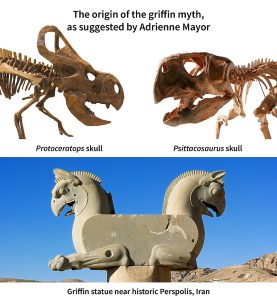
The Dzungarian Gate, also known as the Altai Gap, is a geographically and historically significant mountain pass between Central Asia and China.[1] It has been described as the "one and only gateway in the mountain-wall which stretches from China to Afghanistan, over a distance of three thousand miles [4,800 km]."[2] Given its association with details in a story related by Herodotus, it has been linked to the location of legendary Hyperborea.... In his Histories, Herodotus relates travelers' reports of a land in the northeast where griffins guard gold and where the North Wind issues from a mountain cave. { Hyperborea....}
Pliny the Elder (1st century) was the first to explicitly state that griffins were winged and long eared. But Apollonius of Tyana wrote that griffins did not have true bird wings, but only membranous webbed feet that only gave them capability of short-distanced flight. Writers after Aelian (3rd century AD) did not add new material to griffin lore, except for the later lore that griffins deposited agate stone among the eggs in their nest.
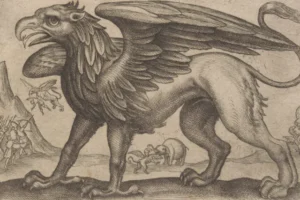 Pliny placed the griffins in Æthiopia, and Ctesias (5th century BC) in greater India. Scholars have observed that legends about the gold-digging ants of India may have contaminated griffin lore.
Pliny placed the griffins in Æthiopia, and Ctesias (5th century BC) in greater India. Scholars have observed that legends about the gold-digging ants of India may have contaminated griffin lore.
In the Christian era, Isidore of Seville (7th century AD) wrote that griffins were a great enemy of horses. This notion may have readily developed from the tradition that horseback-riding Arimaspians raided the griffin gold....The derivation of this word remains uncertain. It could be related to the Greek word γρυπός (grypos), meaning 'curved', or 'hooked'. Greek γρύφ (gryph) from γρύφ 'hook-nosed' is suggested.[5]
It could also have been an Anatolian loan word derived from a Semitic language; compare the Hebrew word for cherub כרוב kərúv.[6][7]
And/or: "But why the Dog/Roebuck/Lapwing? The author goes on to explain by the objective process that the 'Dog' represents ''Guard the Secret'' / The Roebuck = ''Hide the Secret'' / The Lapwing = ''Disguise the Secret''. All in relation to deciphering the Battle of the Trees. All in relation to: ''My thesis is that the language of poetic myth anciently current in the Mediterranean and Northern Europe was a ' magical' language bound up with popular religious ceremonies in honour of the moon goddess, or muse, some of them dating from the Old Stone Age, and that this remains the language of TRUE poetry....'' [ Foreword to the book 'The White Goddess' / R, Graves].
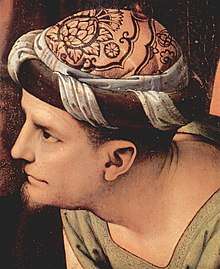
Bald innkeeper?
Continued: This brings us to our physiological allocation, and to the consideration of those parts assigned by the ancients to Gemini, the bronchial tubes and lungs, the shoulders, arms and hands. Some astrologers include the nerves, which is correct if one considers their basic formation as fibers, for other salts must be present in order that they may respond to either sensory or motor impulses. The sensory nerves must be studied under Aries, the motor under Leo. All nerves are essentially filaments. To the above list I add the skin and glands, especially, but it must be remembered that all flesh is constituted of fibers or filaments, so there is very little of the body which does not have flesh filaments for its basis. These constitute man's garment.

Shepherd Kings?
Referring to the interpretation of June from the Latin word meaning joint or joining, we must bear in mind the fact that the nerves and bronchial tubes constitute that part of the body which first branches off, after the formation of the cerebrum, cord and cerebellum.
The bronchi are the branches which convey air to the lung cells which we may term the twigs and leaves. Without lungs there would be no marriage in Cana of Galilee, no turning of the water of life into wine. For here is where oxygen, spirit or prana, combines with the blood for the arterial system, producing a combination of earth, air, fire and water of which so very, very little is really known.....The word Cana means reeds in Hebrew, while Galilee means circle. Their combination clearly refers to the lungs and their function of combining air and blood, which is the Water of Life. It becomes the wine of life when Spirit is added. {'The Zodiac and the Salts of Salvation'}.
Side note: A papyrus chair found in the tomb of Tutankhamun. {Lost Treasures of Egypt / S2 EP1}.

An innocent women abroad.
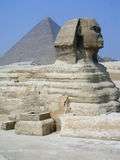
''Red king."
Continued: ''However, we all know that white must have its twin or balancer in shadow. This is the menstrual rhythm of the black goddesses - the new moon. The value of this rhythm in the cosmic sense is Necessity - pathologising and wounding in psyche and substance. Here is the raw, open and unpredictable Dionysian current, the Romantic in culture. In alchemical lore this is the black of the dark moon and eclipsed moon {hidden or concealed light of the sun}. The hidden masculine rises on the outer feminine as recognition by the woman of the inner husband, other lover, inner-child or Red King: the animus....Here is the inspiration of death {daath?} as a teacher, but not of morbidity, for the potential 'child' that is as yet unborn - is reborn in an INNER-SENSE {in innocence}, as a deepening to fresh values.....'' [Page 254 'Fruits of the Moon Tree' / A. Bleakley].
And/or ''Conjunction {triple} of Jupiter and Saturn {7BC} - 23rd September."

Dresden {Saxony} Germany. Rooster on top. Rooster also on top of Notra Dame roof. 'Forest of oaks'.
"Saturn is the furthest planet that can be seen with the naked eye."
Question. Does that give clews as to the construction of such monuments in Egypt in relation their most noteworthy of all 'high priests' - IMHOTEP?
''At the start of the 17th century the world was still fraught with wonders and nothing seemed impossible. In December 1603 there was a conjunction of Saturn and Jupiter, the hour hands of the cosmic clock which usher in new epochs and crumbles old orders. New stars suddenly appeared in the constellations of the Serpent and the Swan, and fears and hopes were rife throughout Europe. In England the long reign of the Tudors came to an end....'' ['Robert Fludd' / J. Godwin].
Jupiter/Saturn December 2020 ?
Hapton Court with maze {labyrinth?} in the middle of a u-turn of the Thames river {S/W}.
Henry the 8th and William of 'Orange' {conjunction?}.
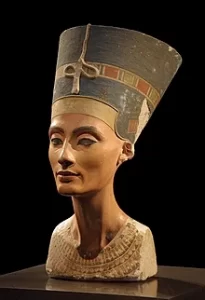
''Tower''?
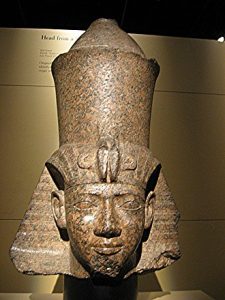 Side note: The crown jewels consists of over 0nehunderd and forty objects {140} - including a spoon and walking stick and in 1671 Thomas Blood attempted to steal them. Been in the Tower since the 1600s. Used in the coronation of British monarchs. ['Lightening' / BBC2 /S2 E27].
Side note: The crown jewels consists of over 0nehunderd and forty objects {140} - including a spoon and walking stick and in 1671 Thomas Blood attempted to steal them. Been in the Tower since the 1600s. Used in the coronation of British monarchs. ['Lightening' / BBC2 /S2 E27].
''There are 3 teaspoons in one tablespoon.''
Continued: A {working} example: {i.e., something hinted at}: "Strange to tell, but I did not enter the cave; in fact, I never chose to enter it at all during those three days. Why is still uncertain...But whatever the case, I decided to set up camp on the far western edge of the cave mouth - an ideal location where the path broadened out, and was protected somewhat by an overhang. The old apple tree was long gone, yet faint ghost-like traces of it could be seen on the ground where a stump once was." ['Lost Books of Merlin' / D. Monroe].
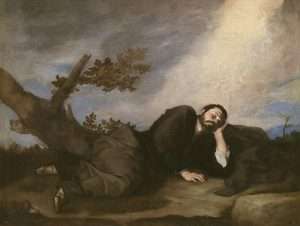
'Stump'? New growth? Oak?
Try ''Seahenge'' and/or ''overhang'' {i.e., what 'position' is generally associated with it}?
N.B. Chaco Canyon {S/W} - with overhang and images. Enlarged elsewhere.
And/or: ''At Hatshepsut’s mortuary temple on the Nile, a withered ancient tree stump defies the unrelenting Egyptian sun, still standing as a testimony to the female royal’s influence and political prowess.
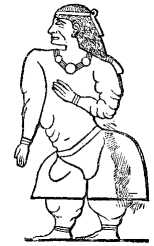
'Fat' of the land.
Supposedly, this myrrh tree dates back to one of the many expeditions commissioned by Hatshepsut some 3,500 years ago. According to the narrative, the tree was brought back from one of the monarch’s seafaring delegations to Punt, which is described as a land on the Red Sea (most likely present-day Somalia and other parts of the Horn of Africa). 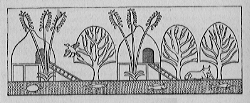 The myrrh was then planted next to the grand mortuary temple of Hatshepsut, also called Djeser-Djeseru, which translates to “Holy of Holies.”
The myrrh was then planted next to the grand mortuary temple of Hatshepsut, also called Djeser-Djeseru, which translates to “Holy of Holies.”
Side note: “Ash Wednesday is the much higher value and deserves the full measure of our devotion,” he said. “I ask with all respect that we maintain the unique importance of Ash Wednesday. If you would like to wine and dine your Valentine, please do so on the Tuesday before February 13 is Mardi Gras, ‘Fat Tuesday,’ a perfect day to feast and celebrate!”
'Thirteen'.
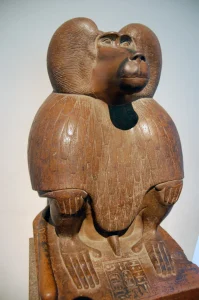

"A pregnant pause (or silence) is a pause or silence that is laden with meaning or significance." N.B. 'Navel' = middle of human form.
Continued: "An interdisciplinary project involving biologists, Egyptologists, and anthropologists has discovered evidence that may pinpoint the actual location of the trading region of Punt, based on the genetic analysis of an ancient mummified baboon discovered in the ‘Valley of the Monkeys’ in 1905. A previous American study (in 2020) using stable isotopes (chemical signatures found in the teeth of animals) identified the Horn of Africa as the region from which ancient baboons originated. The new research, led by the University of Konstanz in Germany, used genetic analysis to compare the animal specimen to the genetic diversity of baboons living across the African continent, as well as to samples from 100- to 150 year-old specimens from museum collections. Early texts mention that baboons were imported into Egypt from Punt, with the last known expeditions taking place there during the Late Period, which matches the date of the mummified baboon. The team was able to pinpoint the baboon’s origin to the coastal port of ancient Adulis in Eritrea, which was known as a centre for the import of primates during the Graeco-Roman Period. The researchers suggest that Punt and Adulis could be the same geographical location, with the name having changed over thousands of years." ['The Past'].
Dawn?
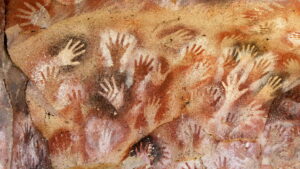
Found in Borneo. Oldest known to date. "Purple around 20,000 years old. The red ones 40,000 years." ['Expedition with Steve Backshall' / S1 EP6]. All negatve imprints But a 'positive' one found elsewhere.
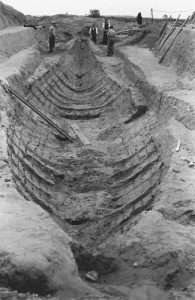
Negative imprint?
Continued: Come back to it later, has one does in any subject. Only put in to show the extent and [depth?] of this subjects material base - if only for this reader - over countless generations; and multiple authors, i.e.,as one example: "Morris dance - {Wikipedia} - The name is first recorded in the mid-15th century as Morisk dance, moreys daunce, morisse daunce, i.e. "Moorish dance". Enlarged elsewhere.
"Today's travellers passing through Winster in Derbyshire may enjoy the unexpected sight of a man dressed as a woman from a centuries old tradition. So old, in fact, that nobody knows where it came from - Morris dancing..." [Britain's Ancient Tracks'. Narrated by T. Robinson. Series 2. Episode 3]. Other clues elsewhere.
''Who guides the keel that plows the deep''. Enlarged elsewhere.
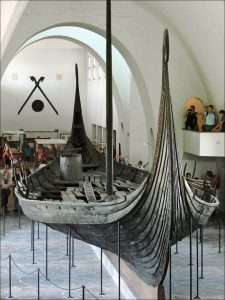
Crescent shape?
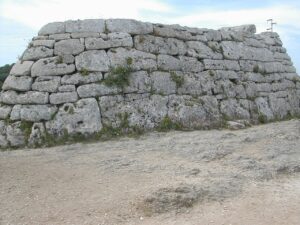
Mastaba? like the one used by Menkaure's son.
And/or: A naveta is a form of megalithic chamber tomb unique to the Balearic island of Menorca. They date to the early Bronze Age. They have two vertical and two corbelled walls giving them the form of an upturned boat, from which the navetas take their name.[clarification needed]
The largest example is the Naveta d'Es Tudons which is around 4m high, 14m long and 6.4m wide.
The first author who wrote about these structures was Juan Ramis in his book Celtic antiquities on the island of Menorca, which was edited in 1818, it being the first book in the Spanish language entirely devoted to prehistory.
Side note: ''Like other members of the Clematis genus, old man's beard or traveller's joy climbs (or scrambles ) over other plants using its leaf stalks (petioles) and flower stalks. The leaves are not unlike the familiar garden forms of Clematis. The leaf stalks entwine around any convenient support / structure in their vicinity and then lignify (become woody).''
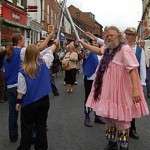
'Plough Monday' dance by the Royal Liberty Morris. Try ''plough''.

Hatshepsut with 'beard'. A balance? ANIMUS?
Continued: {from a different perspective}: "For shamans, this state of balance between the feminine and masculine, magnetic and dynamic, yin and yang aspects of themselves is of supreme importance. Many shamans have believed that to be a truly excellent shaman, one must bring together these polarities in harmony and balance. Historically, there are many accounts of shamans cross-dressing...There are accounts of this ritualized merging into the opposite sex among Native American shamans from the Arapaho, Cheyenne, and Ute tribes as well as etc, etc,...This is not caused by a cross-cultural disorder, but is done purposely as a practice to attain balance...an internal unity that brings together the male and female aspects within themselves into a sacred marriage..." ['Secrets of Shamanism'].
Try ''Marriage'' / ''Dynamic/static'' ''feast of fools'' to see 'it' in its broader {universal?} context.
A beginning of something {''unfold''} = 'child' link?
And/or: Static in relation to: S/W / ''Under {'in'?} the Horizon'' / and Nadir. And Dynamic in relation to: S/E / ''Above {'of'?} the Horizon'' / and Zenith. Enlarged throughout.
A working example: "God is dynamic. Evolution is a subjective, human term for our experience of his dynamism." [Page 141 'The Sword in the Sun'].
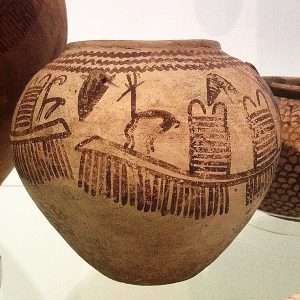
A leap across a gap?
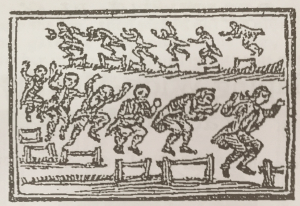
''Twelve-_Lords_a_Leaping.''
From a different perspective: "This much is the basic pattern, which can be enacted by one individual, or by a group. The physical movement is essential, and the transformative power does not awaken fully without it. It may be done as a dance to drumming and music, or as a simple processional movement. Traditionally it is accompanied by spinning and leaping. Many ritual dances from folk tradition, particularly those preserving death and resurrection symbolism, use this type of pattern....Celtic saints for example, were renowned for leaping…." 'The Way of Merlin' / R. Stewart. Italics, this readers].
Question. A leap of faith or that intuitive one?
ALL as a means....?
As is:'' A drum of hareskin…'' {Page 193 - Douglas Monroe}.
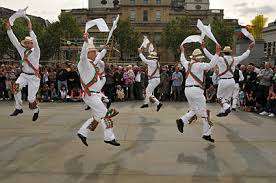
A leap of something - all in unison?
And/or: "Moriscos (Spanish: [mo'?iskos], Catalan: [mu'?iskus], [mo'?iskos]; Portuguese: mouriscos [mo(w)'?i?ku?], [mo(w)'?iskus]; meaning "Moorish") were former Muslims who converted or were coerced into converting to Christianity, after Spain finally outlawed the open practice of Islam by its sizeable Muslim population (termed Mudejar) in the early 16th century...The Inquisition was aimed mostly at Jews and Muslims who had overtly converted to Christianity but were thought to be practicing their faiths secretly. They were respectively called marranos and moriscos. However, in 1567 King Philip II directed Moriscos to give up their Arabic names and traditional dress, and prohibited the use of Arabic. In reaction, there was a Morisco uprising in the Alpujarras from 1568 to 1571. In the years from 1609 to 1614, the government expelled Moriscos. The historian Henri Lapeyre estimated that this affected 300,000 out of an estimated total of 8 million inhabitants.
According to L. P. Harvey, the two different meanings of the word 'morisco' have resulted in mistakes where modern scholars misread historical text containing morisco in the older meaning as having the newer meaning. In the early years after the forced conversions, the Christians used the terms ''New Christians'', ''New converts'', or ''New Christians , converted from being Moors''. [Wiki].
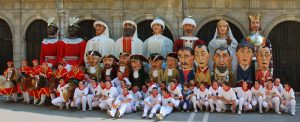
All from Spain. Recognise any?
The Western {Christian?} equivalent of its Eastern counterpart {Dervishers?}. Try this page and/or Part 5 to 'see' if you agree or disagree.
Proving the validity of {say} a study exercise as opposed to that first impressionable one.
'Mans Search for Meaning' / Viktor Frankl.
And/or {as a means...}: "One can escape the prison of the eclipse, only by turning to the moral consciousness of the transcendent self..." [Extract from the book by Tomberg]. Try Part 4.
''Zero'' ? As a means to begin something. The start of something.
And/or: ''We may never know the full story of what communications there were between the secret mystics of the East and those of the West. However, two points of contact certainly did exist in medieval times. One was the Moorish kingdom in Spain, which lasted from A. D. 711 until 1492. The scholarship of the Moorish doctors was far in advance of that of most of Europe. They gave us the Arabic number signs - a great advance upon the clumsy Roman numerals; and many terms in astronomy and chemistry derived from Arabic. So are the astrological terms 'zenith' and 'nadir'. It was natural that men of such comparatively advanced scientific learning should be accused of 'sorcery'. However, the Moors also had a considerable interest in occult philosophy, alchemy, astrology, and 'magic' generally. The city of Toledo in Spain especially so....'' ['An ABC of Witchcraft: Past and Present' / Doreen Valiente].
Side note: Toledo, the place where Juan De Yepes Y Alvarez {St. John of the Cross} wrote his best known work - while in imprisonment - ''Dark Night of the Soul.'' Other possible 'keys' = Born 24th {'twentyfour'} June. Ordained at twentyfive + 25 chapters in Part II of the above book. 'Fourteen' in the first part. Beatified in 1675 {'seventyfive'}, canonized in 1726 {'twentysix'} and became a doctor of the church in 1926. Belonged to a Carmelite order that became known as 'shoeless'. His persecution ended in 1578 after which: ''He wrote the majority of his works - most of which remained UNFINISHED - during the next 'nine' years.'' [Intro. to above book. Translated by E. A. peers].
To be 'finished' by the reader?
N.B. Sphinx Temple also unfinished.
Socrates to enlarge.
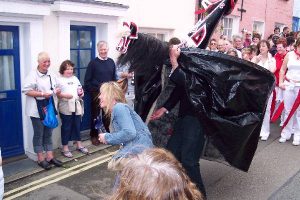
The mythic Hobby - Horse.
Continued: ''There are two rival horses and their fiercely loyal bands of supporters at Padstow: the Old 'Oss is decorated with white and red, and its supporters wear red scarves {'scarf'} to show their allegiance; the Blue Ribbon 'Oss (or "Peace 'Oss") is decorated with white and blue and its supporters follow suit. A "Teaser" waving a padded club dances in front of each 'Oss, accompanied, as they dance through the narrow streets, by a lively band of melodeons, accordions and drums playing Padstow's traditional May Song. The 'Osses sometimes capture young women beneath the skirt of the hobby horse; often they emerge smeared with black.'' [Wiki].
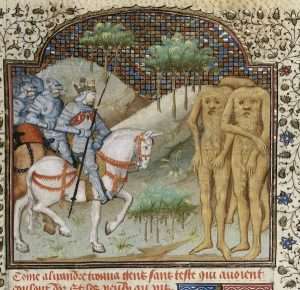 AND/OR: The horse is a universal symbol of the Mother. This again is an objective symbol for the Unconscious, the animal life, since it is from thence that consciousness is born. Again, the horse in astrological symbolism corresponds to the zodiacal sign Sagittarius which represents aspiration and spiritual yearning. Associated with this idea there is the Chaldean Oracle: Also there is the Vision of the fire-flashing courser of Light, or also a child borne aloft on the shoulders of the celestial steed, fiery, or clothed with Gold, or naked, or shooting with the bow shafts of Light, and standing on the shoulders of the Horse. But if thy meditation prolongeth itself thou shalt unite all these Symbols in the form of a Lion. Nearly all animals, from the psychological viewpoint, indicate libido or instinct, the type and size of animal indicating the degree of its domesticity. Speed in running is the chief characteristic of the horse. Its tendency when frightened to bolt with the bit between its teeth is another. These are fairly descriptive symbols of the primitive instinctive principle inhering within each one of us. ['The Philosophers Stone' / I. Regardie].
AND/OR: The horse is a universal symbol of the Mother. This again is an objective symbol for the Unconscious, the animal life, since it is from thence that consciousness is born. Again, the horse in astrological symbolism corresponds to the zodiacal sign Sagittarius which represents aspiration and spiritual yearning. Associated with this idea there is the Chaldean Oracle: Also there is the Vision of the fire-flashing courser of Light, or also a child borne aloft on the shoulders of the celestial steed, fiery, or clothed with Gold, or naked, or shooting with the bow shafts of Light, and standing on the shoulders of the Horse. But if thy meditation prolongeth itself thou shalt unite all these Symbols in the form of a Lion. Nearly all animals, from the psychological viewpoint, indicate libido or instinct, the type and size of animal indicating the degree of its domesticity. Speed in running is the chief characteristic of the horse. Its tendency when frightened to bolt with the bit between its teeth is another. These are fairly descriptive symbols of the primitive instinctive principle inhering within each one of us. ['The Philosophers Stone' / I. Regardie].
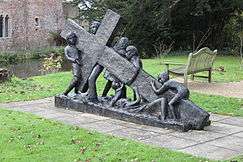
Childs play?
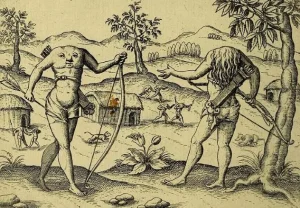 Every year, in preparation for the first of May (unless this falls on a Sunday, in which case the festival takes place on Monday 2nd), Padstow's narrow streets and ancient harbour are extravagantly decorated with flowers, flags and greenery {especially young sycamores}, the focus of which is a tall and colourful May Pole. What follows is a grand procession, usually attended by thousands, in which two groups of dancers, accompanied by drums, triangles and marching accordion players, make their way through the town, one of each team dressed in a stylized recreation of a horse and wearing a striking and faintly terrifying mask. These are the Old and Blue Ribbon Osses, both of whom have stables from which they emerge in the morning and to which they return at night....Led by teaser and trailed by crowds of followers dressed in white with red and blue sashes and a number of junior Osses operated by children, the two main Osses pretend to try to catch maidens as they pass through the narrow streets. This bizarre dance continues all day long until, at midnight, the townsfolk join together to sing Padstow's unique 'May Song';
Every year, in preparation for the first of May (unless this falls on a Sunday, in which case the festival takes place on Monday 2nd), Padstow's narrow streets and ancient harbour are extravagantly decorated with flowers, flags and greenery {especially young sycamores}, the focus of which is a tall and colourful May Pole. What follows is a grand procession, usually attended by thousands, in which two groups of dancers, accompanied by drums, triangles and marching accordion players, make their way through the town, one of each team dressed in a stylized recreation of a horse and wearing a striking and faintly terrifying mask. These are the Old and Blue Ribbon Osses, both of whom have stables from which they emerge in the morning and to which they return at night....Led by teaser and trailed by crowds of followers dressed in white with red and blue sashes and a number of junior Osses operated by children, the two main Osses pretend to try to catch maidens as they pass through the narrow streets. This bizarre dance continues all day long until, at midnight, the townsfolk join together to sing Padstow's unique 'May Song';
Try 'Dark Aphrodite' / 'Black Madonna' to get into that universal mindset.
"When the individual is born again, the blue star is born with it. When the star exploded, my cycle of coming and going had ended." Coincidence or a meaningful one? Enlarged elsewhere.
Martin Lunn to enlarge.
Continued: ''Zero'' ? As a means to begin something. The start of something.
A {working?} example: "Venus is called the planet of 'love', by those who do not know about the mysteries,'' he had said. This starting us out on a long journey in search of arcane images. We knew that the esoteric Venus was the planet of inner light, and that love itself is an expression of this phosphorescence. His concluding sentence on that day had puzzled us however: "After an eclipse of Venus, the soul must become a wanderer for a while. 'Venus' is the inner flame; she finds it hard to bear the darkness of eclipse.'' We had not understood then, but now we did, for we were living through such an eclipse..." ['The Zelator'].
A side step: N.B. 13th King of Copan {'Holy' Kings} - whose name = 'Eighteen Are The Images of the God' - nicknamed 18 Rabbit. Hare link? Try ''13'' to add or detract from - while recalling what ''18'' represents.
 Side note: ''Before eating Nikola Tesla - 'the father of electricity' - polished each piece of cutlery with eighteen napkins''. [QI Elves].
Side note: ''Before eating Nikola Tesla - 'the father of electricity' - polished each piece of cutlery with eighteen napkins''. [QI Elves].
"Analogy of same. Different time; different author..."Formally it may be said, my whole being was possessed by egoism. All my manifestations and experiences flowed from my vanity......and from then on there gradually arose in me that ''something'' which has brought the whole of me to the unshakable conviction that, apart from the vanities of life, there exists a ''something else'' which must be the aim and ideal of every more or less thinking man, and that it is only this something else which may make a man really happy and give him real values, instead of the illusory ''goods'' with which in ordinary life he is always and in everything full." [Chapter 10 'Meetings with Remarkable Men'. Mentioned elsewhere].
Recall the same word {i.e., "something" - in the 'Help' section}.
Eastern equivalent..."The ego principle = ahamkara = ''i do,'' is the root cause of dualism [i.e.,higher/lower etc.,] or the seeming separation between man and his 'creator'. Ahamkara brings human beings under the sway of 'maya' {cosmic delusion'}, by which the subject 'ego' falsely appears as object..." Hence the link to objectivity - benefit of. Especially when its related to that ''internal'' stuff. See it? i.e.,.
"To remove the veil of maya is to uncover the secret of creation." [Both extracts from the book 'Autobiography of a Yogi' ].
'On Having No Head: Zen and the Rediscovery of the Obvious' / D. E. Harding.
"...the anima appears in 'her' proper positive role - that is, as a mediator between the ego and the self." ['Man and his Symbols' / C. Jung].
Side note: The TITLE ''Pharaoh'' came into use at the inauguration of Hatshepsut {'Great House'}.
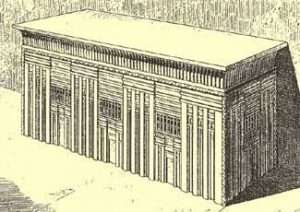
Recesses = 'shadows'? 'Gap' to enlarge.
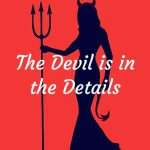
Shekhinah to enlarge.
And/or: {as a working example}: ''The Torah is situated between two houses, one recondite and on high, the other more accessible. The one on high is the 'Great Voice' referred to in the verse: 'a great voice which did not cease' {Deut. v, 22}. This voice is in the recesses and is not heard or revealed, and when it issues from the throat {Taurus?} it utters the aspirate without sound and it 'flows' on without ceasing, though it is so tenuous as to be inaudible. From this issues the Torah which is the 'voice' of Jacob....This 'Great Voice' which cannot be heard is a house to the supernal Wisdom {the female is always called a ''house''}, and the articulation we have mentioned is a ''house'' to the voice of Jacob, which is the Torah, and therefore the Torah commences with the letter beth, which is, as it were, a 'house' to it.'' [Page 295 'Meditations on the Tarot'].
Swan to enlarge.
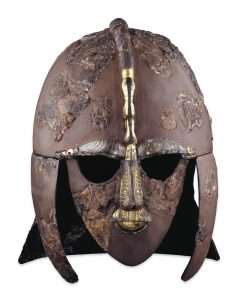
Winged or flightless as a means....?
Continued: "Ken, crystals are little more than rocks. I began to explain how crystals are actually alive and conscious something that i realize is outside of normal consciousness but not outside of science. I showed him the periodic table of the elements...how carbon, the 6th element, is associated with all organic chemistry and everything that is normally considered to be alive. But directly below it, one octave below, is the element of silicon, the primary element of quartz Acrystal and 80% of the crust of the earth." ['Serpent of Light' - mentioned elsewhere].
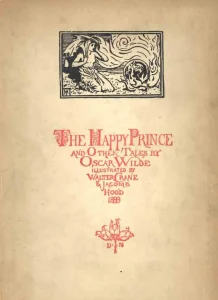
“The Happy Prince” is a short story by Oscar Wilde, part of his collection of short stories titled The Happy Prince and Other Tales, published in May 1888. Other short stories in this collection are “The Happy Prince,” “The Nightingale and the Rose,” “The Selfish Giant,” “The Devoted Friend,” and “The Remarkable Rocket.” {i.e., 'five' in total}.
The story revolves around a magnificent statue covered in finery that stands guard over a city rife with injustice and inequity. Formerly a prince who lived a lavish but ignorant life, he is now frozen and can only bear witness to the problems of the city’s citizens.'' Medusa to enlarge.
A working example: ''Her name is Emma Marshall, and she wrote Crystal Diamonds at the Hot Wells, published in 1888. It all about the theft of a brooch at the Hot Wells. And this was my first discovery of how important Bristol Diamonds were to the Hot Wells Spa.'' ['Meet the Author: Melanie King on Spa's' / Mirthy ].
On the shoulders of giants?
''Bristol Diamonds are quartz crystals found in geodes and geological rock formations which occur in dolomitic conglomerate in the Avon Gorge in Bristol, England. Their origin lies in geological processes of the Triassic period, about 250 to 200 million years ago.
The Bristol Diamonds became popular novelties for visitors to the spa at Hotwells, Bristol, during the eighteenth and nineteenth centuries. Diarist John Evelyn and travel writer Celia Fiennes were amongst those who described them. In popular culture they became a synonym for something bright but worthless.''
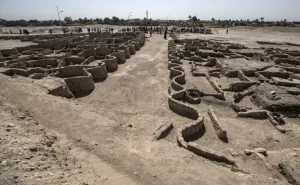
''The signs Gemini and Virgo are alloted to Mercury. This association accounts for Virgo sometimes represented with the caduceus.''
Continued: ''After some eight or nine circulations {cycles?} all the signs are that the brightness of Sol is opening up the matter. As fast as the dragon reconstitutes itself below, so Sol's shining rays thrust down between its grey-green scales {'carapace'?}, causing it to writhe and seethe. The death is liable to be a slow and painful one - but how could the seperation of mercury and sulphur be otherwise? The thought of the Nigredo {shadow aspect} already forms at the back of my mind. I must try to concentrate {meditation?} on the Albedo {anima} beyond.'' [Page 125 ''Separation'' from the book 'Mercurius' ].
''It's not just a character from the X-Men movies: Quicksilver is the alternative name for the metal Mercury. Mercury, atomic number 80 {'eighty'} on the periodic table, is a heavy, silvery-white liquid metal.''
A working example: Directly underneath the Temple of the Feathered Serpent { Quetzalcoatl} within the Teotihuacan complex - at the end of a LONG TUNNEL, the length of a football field - is found {among other objects} Two women with one man {'child'?}, a rubber ball and liquid mercury.'' ['Expedition Unknown: Lost Mexican City' S3 EP1].
"A monk who had meditated long in search of Illumination finally received a great flash of insight. Rushing to his 'roshi' {Zen master}, the monk cried out, 'I have it! I have it! That rock there is inside my head.' "You must have a big head," the master replied, ''to hold a rock that size." [Extract from the book 'The Cosmic Trigger'. Mentioned elsewhere].
'Philosophers Stone'.
"Imagination is a monastery and i am its monk." {John Keats, from a letter to Percy Bysshe Shelly, August 1820}. Try ''house'' and/or ''temple,'' for alternative 'viewpoints'.
"The chief training schools of western Druids, was on Anglesey, also called Mona or Muineadh in proto-Welsh, which means Island of Teaching.....The word has roots to the Straight of Menai as well as the word Monastery - a dwelling place for priests. [Douglas Monroe].
Try ''cattle'' - to take subject material further. Therefore the understanding of a mindset.

'A leap into the VOID? ' Yves Klein - who had a fascination with the colour blue. Synchronistic? Question. Aqueous Blue?
That final link to a 'potential'...a potential, that once made aware of, could lead to a 'reversal of fortune',i.e.,'higher within the lower'. Andrew Sinclair does the same, but now in relation to the 'Grail' story...' The Discovery of the Grail. ' The word 'giant' mentioned in relation to the British isles. Find it it you want to understand your own county's symbolism in relation to the whole. Woodhenge in relation to Stonehenge,[macro]. Sarsen stones in relation to those 'blue' ones, [micro].
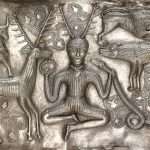 ''The name comes from the civil parish in which the site is located – Durrington, meaning "the farm of the deer people" ("doer" – deer, "ing" – people/tribe, "tun" – farm/settlement), and the large henge banks that surround it.[10] The "Dur" prefix is commonly found in this part of England; the Durotriges Celtic tribe inhabited this area before their defeat by the Romans in the mid first-century C.E. Also, Dorchester was originally known as Durnovaria, and smaller cities with related names (e.g., Durweston) and locations (e.g., Durborough Farm) are found in this region.''
''The name comes from the civil parish in which the site is located – Durrington, meaning "the farm of the deer people" ("doer" – deer, "ing" – people/tribe, "tun" – farm/settlement), and the large henge banks that surround it.[10] The "Dur" prefix is commonly found in this part of England; the Durotriges Celtic tribe inhabited this area before their defeat by the Romans in the mid first-century C.E. Also, Dorchester was originally known as Durnovaria, and smaller cities with related names (e.g., Durweston) and locations (e.g., Durborough Farm) are found in this region.''
''Forest'' to enlarge.
''Mountains low. Valleys high''?
Durobrivian?
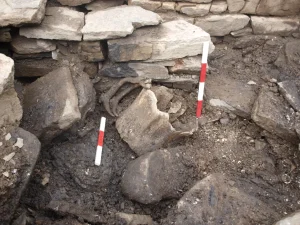
Bucket made from the spine of a whale. Inside three newborn lambs and the jaw bone of a woman. Either side of which two right sided reindeer antlers. A quern stone pressing the bucket against the outside wall. 'Ceiling' to enlarge. "No leak at the seam"?
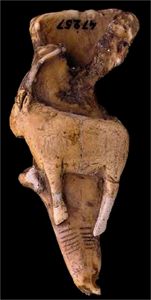
Ibex on a whale tooth.
And/or..."Long time ago, there was a race of giants that lived in Orkney; great bad tempered, blustering creatures. But they did like to come together and dance {'Pan' link}. One night they 'gathered together' on the plain between two bodies of water {'loch'} and danced in a circle. They danced and danced to the music of the fiddler. They enjoyed themselves so much they lost the 'track of time' - and before they knew what happened - the 'sun rose' and all turned to stone. There they remain to this day as the Ring of Brodgar." [ Tom Muir/ Orkney museum from the program 'Sacred Wonders of Britain' {episode 1} narrated by Neil Oliver. Emphasis, this readers].
Any boars?
A working method = Waun Mawn. Enlarged within.
Question. Cassiopeia?
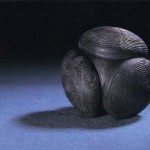
Many found N/E.
Orkney isles = N/E. The start of something. 'Giant' in relation to gross or external or 'lower' {'transcendent third' link?}. The narrator believes a spiritual 'teacher' of some description was responsible, {similar to Schonfields hypothesis. Enlarged elsewhere} i.e.,he asks questions such as..."Do you get any sense of what religion or science or magic was practiced here...OR "Is this the origin of a new religion or maybe a different way of understanding the world; its amazing that something that might have kicked off throughout Britain may have started in these Islands {Orkney}...Could an individual be behind it - a messianic figure or an inspirational spiritual leader here 4-5000 years ago..." [Same program]. Other examples enlarged elsewhere.
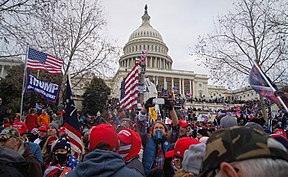
''A land is only as good as its leaders." {'The Kid Who Would be King." / 2019}.
That "...different way of understanding.'' - from the dawn of human kind {i.e.,oral tradition?} up to the present - as defined by a sole subject - not a sole individual. A leader was no doubt present. But a 'leader' does not automatically imply a 'teacher'. Yes or no?

“Most certainly, I tell you, one who doesn’t enter by the door into the sheep fold, but climbs up some other way, is a thief and a robber." 'Lambs' to enlarge.
N. B. "Adomnan, the biography of St. Columbus says that the Picts were called Orcadians."
Try ''Pict'' to see it from their perspective.
And/or: ''Etymologists usually interpret the element orc- as a Pictish tribal name meaning "young pig" or "young boar".[Notes 3][1] Speakers of Old Irish referred to the islands as Insi Orc "islands of the young pigs".[17][18] The archipelago is known as Ynysoedd Erch in modern Welsh and Arcaibh in modern Scottish Gaelic, the -aibh representing a fossilized prepositional case ending. Some earlier sources alternatively hypothesise that Orkney comes from the Latin orca, whale.[19][20] The Anglo-Saxon monk Bede refers to the islands as Orcades insulae in Ecclesiastical History of the English People.''
Side note: ''To exact the maximum payment which a person can afford is to 'squeeze them until their pips squeak'...'' ['The Chase'].
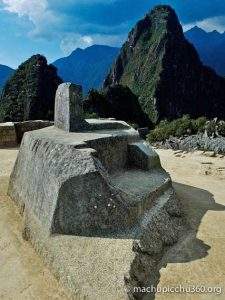
Above the clouds.
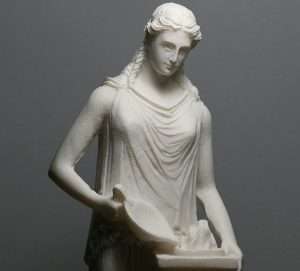
Hestia. Gravy train ? 'Station of No Station'?
A work in progress: ''Aside from the now renamed anvil, there were more concrete clues to a Pictish presence at the Knowe of Swandro. This came in the form of an archaeomagnetic date from a hearth reflecting activity 500AD and a semicircular wall dated to the 8th century, from which the team recovered hipped bone pins and pieces of composite comb. This period also contained a dramatic event, as the ROUND-house walls appear to have suddenly collapsed inwards - the articulated skeleton of a piglet found trapped between two large stones.'' [Page 26 'Current Archaeology' / March 2023].
Accidental or ritual?
'Boar' to enlarge.
Swine herder?
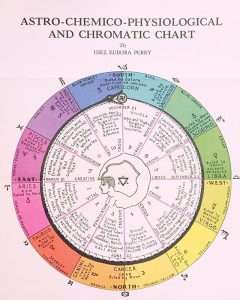
Head/Feet = Aries/Pisces. Somersault?

Reverse of a Carausius silver denarius from the Hoard, showing two clasped hands (symbolising the unity of the ruler and the army), alongside the abbreviation 'RSR'. This alludes to a line from Virgil's Eclogues - Redeunt Saturnia Regna or "The Golden Ages have returned".
''A common theme in myth associated with the boar include the pursuit of the end to tyranny, the test of great courage, the elimination of evil customs, the overthrow of old cycles and the gaining of valour. In Melanesia, the tusks of the boar are the proper adornments of chieftains and elders. They are seen as representing the crescent moon and the continuance of life after death. In Vedic and Hindu traditions Vishnu takes on the form of a boar to save the earth from chaotic waters and is the first one to plough the soil. Vajnavrahi is the goddess of the dawn in the form of a sow who is the source of all life.'' [Page 81 'The Element Encyclopedia of Magical Creatures' / J + C Matthews].
Taurus?
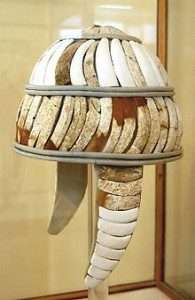
Crete related.
A {present day?} example: "The results of the work of a man who takes on himself the role of teacher do not depend on whether or not he knows exactly the origin of what he teaches, but very much depends on whether or not his ideas come in actual fact from the esoteric center and whether he himself understands and can distinguish esoteric ideas, that is, ideas of objective knowledge, from subjective, scientific, and philosophical ideas." ['In Search of the Miraculous'].
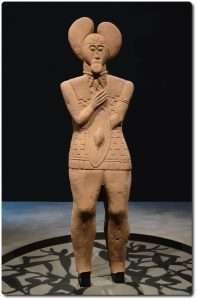
Happy or Sad? BEAN ears?
As one example: ''Feast of Fools, popular festival during the Middle Ages, held on or about January 1, particularly in France, in which a mock bishop or pope was elected, ecclesiastical ritual was parodied, and low and high officials changed places.....
Over the course of a week, the ceremonies would be led by different people in positions of power within the church. On December 26, St. Stephen’s Day, the deacons led the ceremonies. The sub-priests (or vicars) were in charge on December 27, St. John’s Day, the choirboys on December 28, Holy Innocents’ Day, and the sub-deacons on the first of January, the Feast of the Circumcision.[5] There is some disagreement on whether the term Feast of Fools was originally used to refer to the collection of days[5] or specifically the celebrations taking place on the first of January.[6] The word "fool" is used as a synonym for humble, as was common in the 11th century, rather than the modern use that treats it as another term for clown or jester.....
The Feast of the Epiphany and twelfth night festivities which fell in early January. This celebration of the visitation of the magi was, like the other customs, incorporated in the Feast of Fools. Another popular belief roots the King of the Bean tradition in the Saturnalia of ancient Rome.''
'Happy hour'?
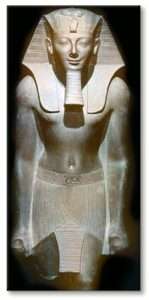
 Happy is one of the seven dwarfs in Disney’s 1937 animated feature film Snow White and the Seven Dwarfs. He gets his name from his jovial and optimistic demeanor. Most often seen with a cheery smile, he is partial to parties, food, and dancing—all of which he is eager to share with the other dwarfs1. Interestingly, Happy was the only dwarf who introduced himself to the Disney Princess, Snow White; the rest were tongue-tied....
Happy is one of the seven dwarfs in Disney’s 1937 animated feature film Snow White and the Seven Dwarfs. He gets his name from his jovial and optimistic demeanor. Most often seen with a cheery smile, he is partial to parties, food, and dancing—all of which he is eager to share with the other dwarfs1. Interestingly, Happy was the only dwarf who introduced himself to the Disney Princess, Snow White; the rest were tongue-tied....
Happy introduces himself, while Snow White guesses the other dwarfs names.{'Pawn Stars' / S18 EP21}.
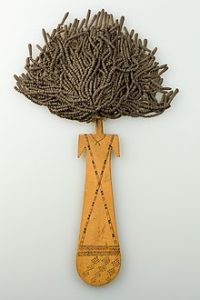 From a different perspective: .....and an oddly shaped half moon/boat with a prominent eye. Next comes an angry sun face with bulging spiral eyes, dumbbell-shaped mouth, and prominent chin. Sixteen large spikes and sixteen smaller spikes inside a containing outer circle surround the face.
From a different perspective: .....and an oddly shaped half moon/boat with a prominent eye. Next comes an angry sun face with bulging spiral eyes, dumbbell-shaped mouth, and prominent chin. Sixteen large spikes and sixteen smaller spikes inside a containing outer circle surround the face. 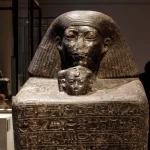 The sun circle itself is surrounded by four stars, placed in the corners of the rectangle and tilted so that their diagonal axes cut through the center point of the sun face. The final image is an oval that fills the entire space of the side and contains a cross with four A’s in it. The A’s are unusual for having a sharply angled crossbar rather than the usual horizontal one....
The sun circle itself is surrounded by four stars, placed in the corners of the rectangle and tilted so that their diagonal axes cut through the center point of the sun face. The final image is an oval that fills the entire space of the side and contains a cross with four A’s in it. The A’s are unusual for having a sharply angled crossbar rather than the usual horizontal one....
Side note: In geometry, a diagonal is a line segment joining two vertices of a polygon or polyhedron, when those vertices are not on the same edge. Informally, any sloping line is called diagonal. The word diagonal derives from the ancient Greek διαγώνιος diagonios,[1] "from corner to corner" (from διά- dia-, "through", "across" and γωνία gonia, "corner", related to gony "knee"); it was used by both Strabo[2] and Euclid[3] to refer to a line connecting two vertices of a rhombus or cuboid,[4] and later adopted into Latin as diagonus ("slanting line").

The phrase “hot on the heels” means in close pursuit of someone or something, or immediately after some event1. It originates from hunting terminology, where the “on the heels” part refers to a hunter’s literal closeness behind their quarry. The word “hot” alludes to the warmth of an active living creature, as opposed to the cold of a corpse or the unconsciousness of being “out cold”. When hounds are close to their prey, they are said to be “in hot pursuit.”
 Continued: At first glance, the sun face is indeed a devouring sun as Boucher tells us. Its design is vaguely Mesoamerican, suggesting Aztec or Incan calendrical sun disks. None of our sources draws any attention to this obvious fact. While the angry sun does suggest a catastrophe motif, the more obvious Tarot image for this face is The Sun, trump 19. This card is attributed to Leo, and the Hebrew letter resh, the R of the Lallemant mansion’s enigmatic credence, is its Hebrew letter. Its simple meaning of “completion of a cycle” points to its basic meaning on the monument. The sun will complete a great cycle, perhaps even the great cycle, the monument implies. The sun face is opposite the eight-rayed star, and, as Boucher suggests, there is a numerical connection between them (see fig. 11.9). The star’s rays grow by a geometric progression on the sun face, doubling or crossing from 8 to 16 to 32. Mevryl’s idea of the sun behind the sun is suggestive, for it makes the star asymbol of Sirius. We are given no clue concerning the four stars surrounding the sun. Mevryl does have a few ideas on the stars, including the possibility that they are the inner and outer planets.!
Continued: At first glance, the sun face is indeed a devouring sun as Boucher tells us. Its design is vaguely Mesoamerican, suggesting Aztec or Incan calendrical sun disks. None of our sources draws any attention to this obvious fact. While the angry sun does suggest a catastrophe motif, the more obvious Tarot image for this face is The Sun, trump 19. This card is attributed to Leo, and the Hebrew letter resh, the R of the Lallemant mansion’s enigmatic credence, is its Hebrew letter. Its simple meaning of “completion of a cycle” points to its basic meaning on the monument. The sun will complete a great cycle, perhaps even the great cycle, the monument implies. The sun face is opposite the eight-rayed star, and, as Boucher suggests, there is a numerical connection between them (see fig. 11.9). The star’s rays grow by a geometric progression on the sun face, doubling or crossing from 8 to 16 to 32. Mevryl’s idea of the sun behind the sun is suggestive, for it makes the star asymbol of Sirius. We are given no clue concerning the four stars surrounding the sun. Mevryl does have a few ideas on the stars, including the possibility that they are the inner and outer planets.!
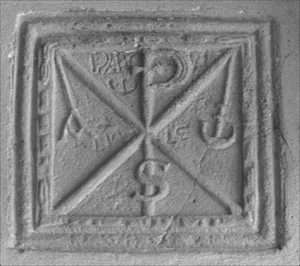
Hung / hang to enlarge.
If we think of Fulcanelli’s image of the dragon’s mouth, the center of the galaxy, spewing out flame and light, then the star might just relate to an eruption from the galactic center. Coupled with the angry sun face, this might also be a clue to the “double cataclysm.” The starlike disturbance from the center of the galaxy might trigger a reaction in our own sun, hence Fulcanelli’s insistence on a “double” catastrophe....
The event, which gave Abram his insight into the nature of time, which was the window of the letter heh needed to spell Abraham, was his covenant with God. At this event, we are told in Genesis, a fiery torch passed through the alignment of sacrifices from the northwest to the southeast, an alignment preserved to this day by the location of the Black Stone in the cube or Kaaba of Mecca. This line from the northwest to the southeast corner is the galactic axis, of course. Abraham’s covenant represents a shift from the High God of the El to a new hidden god controlling the temporal quality of the galactic axis and its alignments. This God, unlike the placid and benign El, could become angry and dispense judgment and destruction. ['The Mysteries of the Great Cross at Hendaye'].
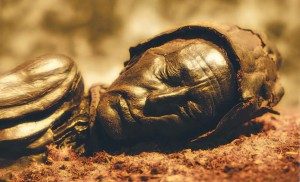
The same question asked to the MANY bodies found in bogs. Enlarged throughout. Try ''marshes/fenland'' to begin with.
Refresher: "The Agnisuryans respond to the sound. The waters ebb and flow. Let the 'magician' guard himself from drowning, at the point where land and water meet. The midway spot, which is neither dry nor wet, must provide the standing place whereon his feet are set. When water, land and air meet there is the place for 'magic' to be wrought."
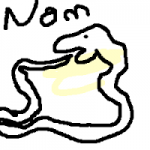
As part of that ''true poetry''. Others found throughout.
A working example: "On a rough, windy January day in the late thirteenth century, Lady de Mowbray, accompanied by her groom, rode along an uneven, muddy track near the village of Haxey, in Lincolnshire. Suddenly a fierce gust of wind caught her large silk hood and whisked it across a nearby field...............
......................................
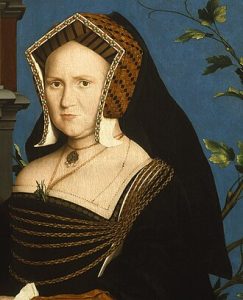
A gable hood, English hood or gable headdress is an English woman's headdress of c. 1500–1550, so called because its pointed shape resembles the architectural feature of the same name. The contemporary French hood was rounded in outline and unlike the gable hood, less conservative, displaying the frontal part of the wearer's hair....The gable hood was originally a simple pointed hood with decorated side panels called lappets and a veil at the back. Over time, it became a complex construction stiffened with buckram, having a box-shaped back and two tube-shaped hanging veils at 90-degree angles. The hanging veils and lappets could be pinned up in a variety of ways to make complex headdresses.
Generally, the gable hood consisted of four parts: the paste, lappets, veil, and decorative jewels (for the most aristocratic only).
Not far off, thirteen men working on the land saw what had happened, and they all began to run after the hood, each striving for the honour of recovering it. As the hood hopped and swirled its way over the field, the men jostled and tumbled after it until, eventually, the strongest of them managed to catch it. But, although the captor was strong, he was too shy to hand the hood back personally to Lady Mowbray, so he gave it to one of his colleagues to return. Lady Mowbray had so enjoyed watching the chase that she promised to give each man a piece of land (her husband owned most of the parish of Haxey) if they could invent a game based on it. The game was to be played annually on 6th January.
Epiphany (/əˈpɪfəni/ ə-PIF-ə-nee), or Eid al-Ghitas (Arabic: عيد الغِطاس),[4] also known as "Theophany" in Eastern Christian tradition,[5] is a Christian feast day commemorating the visit of the Magi, the baptism of Jesus, and the wedding at Cana.[6]
In Western Christianity, the feast commemorates principally (but not solely) the visit of the Magi to the Christ Child, and thus Jesus Christ's physical manifestation to the Gentiles.[7][8] It is sometimes called Three Kings' Day, and in some traditions celebrated as Little Christmas.[9] Moreover, the feast of the Epiphany, in some denominations, also initiates the liturgical season of Epiphanytide.

''Bridge'' on her left or right? As a means....?
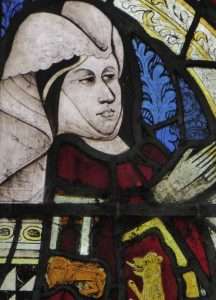
Hooded Women: Lady de Mowbray.
Continued: "She christened the men ‘Plough Boggins’, and to the man who handed her the hood she gave the title ‘My Lord’, but to the shy silent stalwart who actually caught it she bestowed the name of ‘Fool’. She further decreed that, for the game, the players should wear red jackets, all except the Fool, who should wear a harlequin costume. Today, the ‘Haxey Hood Game’ represents one of the most elaborate revivals of the many ancient games played in England, although some people doubt whether Lady Mowbray and her wayward hood represent the true origin of the event. Another theory is that the game represents the survival of an ancient Celtic hilltop ceremony involving sun-worship and human sacrifice. The pagan practice of ‘purifying’ the sacrificial victims by ceremonial smoking is retained in a modified form in the modern re-enactment. Christian teachings opposed such barbaric practices and, as with other pagan festivals, they were eventually modified and incorporated into revised ceremonies.
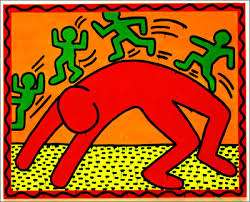
Bridge over troubled waters?
Historians refer to the fact that right up to the period 1627-31, when the fens were drained, Haxey, in the Isle of Axholme, with its innumerable dykes, marshes and bogs, was virtually cut off from the rest of the country, and its inhabitants were regarded as savages. In such an area, old festivals would have flourished. Today’s ceremony follows very closely the ancient rules of the game. The ‘Lord’ is a permanent official, recognised for his knowledge of the game, and his eleven ‘Boggins’ are chosen at a meeting held on St. John’s Eve (26th December) at which time plans are made for the coming festivities. At midday on 6th January, work in the village comes to a halt, and soon a crowd assembles on Haxey Church Green."
'Twentysix'.
11TH hour in relation to an ephiphany.
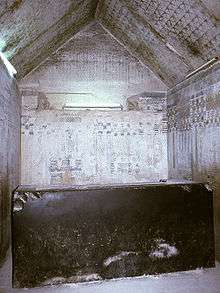
A working example: The Lutheran church {having as its facade the same form as above} is now a boxing gym. "This has just done my head in because everything always comes full circle but never in such a poetic way as this. I feel so joyful, I couldn't have been more delighted by this whole thing." Sue Perkins' episode of Who Do You Think You Are / BBC2. "Theme" to enlarge.

Happy or sad?
From a different perspective: ''My thesis is that the language of poetic myth anciently current in the Mediterranean and Northern Europe was a' magical' language bound up with popular religious ceremonies in honour of the moon goddess, or muse, some of them dating from the Old Stone Age, and that this remains the language of TRUE poetry....but it is only fair to warn the reader that this remains a very difficult book, as well as a very queer one {'peculiar'?}, to be avoided by anyone with a distracted, tired or rigidly scientific mind...." [Forward to the book 'The White Goddess' / R. Graves].
Side note: Why a 'serpent'? Crawls on belly {horizontal?} but can strike in the vertical? Can be found in both salt and fresh water? Sheds its skin? etc.
Is there any other animal that is closer to the earths surface - that seems to hug/embrace it?
'Zigzag' movement?
All as a means...?
Try ''poison/antidote''.
Working example {?}: ''Helsinki is the only Nordic European capital city that begins with the letter 'H'...'' ['The Chase'].
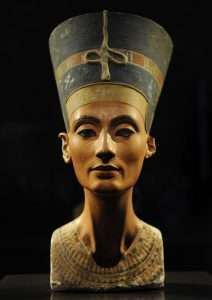
'Stretched neck'?
''According to a theory presented in the 1630s, at the time of Swedish colonisation of coastal areas of Finland, colonists from Hälsingland in central Sweden had arrived at what is now known as the Vantaa River and called it Helsingå ("Helsinge River"), which gave rise to the names of Helsinge village and church in the 1300s.[24] This theory is questionable, because dialect research suggests that the settlers arrived from Uppland and nearby areas.[25] Others have proposed the name as having been derived from the Swedish word helsing, an archaic form of the word hals (neck), referring to the narrowest part of a river, the rapids.[26] Other Scandinavian cities at similar geographic locations were given similar names at the time, e.g. Helsingør in Denmark and Helsingborg in Sweden.
When a town was founded in Forsby village (later known as Koskela) in 1548, it was named Helsinge fors, "Helsinge rapids". The name refers to the Vanhankaupunginkoski rapids at the mouth of the river.[27] The town was commonly known as Helsinge or Helsing, from which the contemporary Finnish name arose.''
'H'elen?
Refresher: "The children of Seth [Set] first possessed that peculiar sort of wisdom, which is concerned with the heavenly bodies",[chapter five.' The Sirius Mystery'],
Brought up to date...That ''oral tradition'' in relation to: "But when we go back further in history, before Christianity, it becomes even more difficult to decipher what people believed in. The belief of our pre-historic ancestors are mysteries. They didn't write anything down - so we are left to turn to archeology for some clues..." [Alice Roberts 'Digging For Britain'].

Try that one.

"Roots" of what tree?
"Didn't write anything down'' in relation to {as ONE example only: "Josephus, born at Jerusalem in 37AD., was the greatest historian of the Jews in that period. Philo was the greatest Jewish philosopher of that period. Both men had personal knowledge of the ancient Essenes. Both scholars make clear that the Essenian roots are incredibly ancient. Josephus declares that the Essenes have existed ''from time immorial'' and ''countless generations''. Philo agrees, calling the Essenes ''the most ancient of all the initiates'' with a ''teaching perpetuated through an immense space of ages''. Continued elsewhere.
Question. A ''teaching'' of what?
Try Dead Sea Scrolls as one example.
And/or: ''The Tabernacle of the Temple Square is in the state capital of Salt Lake City.''
''The largest public square in Europe is part of the British museum in the CAPITAL city of London.''
''Vatican'' to see it from a different perspective. That ''duality'' one.
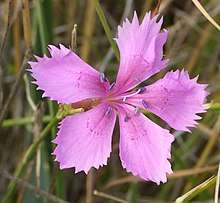
Coincidence? Fire and water as a means....
''The British Museum is a public museum dedicated to human history, art and culture located in the Bloomsbury area of London. Its permanent collection of eight million works is among the largest and most comprehensive in existence. It documents the story of human culture from its beginnings to the present.''
''But why does the Boibel-Loth contain so many approximations to Biblical 'names', taken from Genesis and Exodus, which in Christian times had lost their religious importance: Lot, Telmen, Jachin, Hur, Caleb, Ne-esthan - all names concerned with Sinai, Southern Judaea and the Edomite Dead Sea region. This is the region that the Essene communities were settled from about 150 BC - 132 AD.....They appear to be an offshoot of the Therapeutae, or healers, an ascetic sect settled by Lake Mareotis in Egypt.....They believed in the Western Paradise.....in the return of pure souls to the Sun...." [Page 144/9 'The White Goddess'].
Sinai = the middle of a 'journey'.
Scorpion king?
'The Prophetic Vision of Merlin: Prediction, Psychic Transformation, and the Foundation of the Grail Legends in an Ancient Set of 'Visionary' Verses' / R. Stewart. As a means....?
REFRESHER: "....the words 'idea', 'wisdom' and 'vision' ALL originate from the common Indo-European root which means ''to see''. An idea is an insight, an inner flash of illumination that can result in 'wisdom'." [From the book 'Alexandria' / Vol 3 ].

'Herne the Hunter'. Question. To many lagers? OR Spirit or soul - as a means? Try ''stag'' and/or ''deer'' - while recalling what ''forests'' represent.
A {working?} example - in the present time: Dry stone 'tower' {Broch} decommissioned {filled in} - that resembles a mound of stones {primordial?}. Discovered South Ronaldsay. Lower jaw of a human {'teeth'} together with whale bone {'cup' shaped}, and surrounding it Red deer antlers were eventually discovered. {'Digging for Britain']. All enlarged elsewhere.
Question. Male or female antlers?
Try ''map''. And/or Neil Oliver.
Side note: ''Son of Man, set thy face against Gog, the land of Magog, the chief prince of Meshech and Tubal, and prophesy against him. And say: Thus says god, 'behold i am against thee O Gog, and i will turn ye back, and put hooks into thy jaws, and i will bring thee forth, and all thine army, horses, and horseman, all of them clothed with all sorts of armour....all handling swords {therefore 'fire' link}: Persia, Ethiopia and Libya with them....'' [Ezekiel 38: taken from the book 'GogMagog' / T. Lethbridge].
And/or: "The parts of the body with which this sign {'Taurus'} - allocates are the ears, face around the lower jaw, cerebellum, neck, throat, liver and gall bladder." ['The Zodiac and the Salts of Salvation' / Inez Perry].
Something hinted at: "Once during those last eerie, in-between moments of waiting, I thought I 'fancied' seeing a great pair of antlers move silently against the sky line and then vanish. ''So it was only a 'deer'...!" I said to myself, as if scolding a silly child....But I then saw those antlers again...''Listen to me...listen!'' it said in a low voice. 'The gateway of your soul lies in an ancient forest.' Then it was gone.'' [Page 389 of the book by Douglas Monroe. Chapter entitled 'Beyond Word and Deed'].
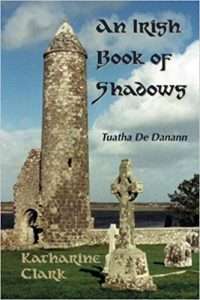
An Irish Broch? = 'Tower'? Question. What does the pointy 'bit' represent? Did any ''Broch's'' have any?
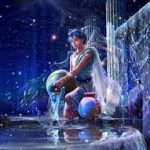 Side note: "What is music? What is Poetry? What is mythology? All questions on which no opinion is possible unless one already has a real feeling for these things. That is natural and obvious enough. Not so, however, our feeling in the case of the last named. Only the greatest creations of mythology proper could hope to make clear to modern man that here he is face to face with a 'phenomenon' which in ''profundity, permanence, and universality is comparable with nature herself''. If we want to promote a real knowledge of mythology, we must not appeal at the outset to theoretical considerations and judgements {not even to Schelling's, from whom the quotation in praise of mythology comes}. Neither should we talk over much of ''sources'' {instead} - the water must be fetched and drunk fresh from the spring if it is to flow through us and quicken {'distillation'?} our hidden mythological talents. But here too there's many a slip between the CUP AND THE LIP {jaw/teeth?}. True mythology has become so completely alien to us that before the tasting of it we would do well to consider our attitude towards it. We have lost our immediate feeling for the great realities of the 'spirit'...." ['Science of Mythology: Essays on the Myth of the Divine Child' C.G. Jung and C. Kerenyi. Emphasis/parenthesis, this readers].
Side note: "What is music? What is Poetry? What is mythology? All questions on which no opinion is possible unless one already has a real feeling for these things. That is natural and obvious enough. Not so, however, our feeling in the case of the last named. Only the greatest creations of mythology proper could hope to make clear to modern man that here he is face to face with a 'phenomenon' which in ''profundity, permanence, and universality is comparable with nature herself''. If we want to promote a real knowledge of mythology, we must not appeal at the outset to theoretical considerations and judgements {not even to Schelling's, from whom the quotation in praise of mythology comes}. Neither should we talk over much of ''sources'' {instead} - the water must be fetched and drunk fresh from the spring if it is to flow through us and quicken {'distillation'?} our hidden mythological talents. But here too there's many a slip between the CUP AND THE LIP {jaw/teeth?}. True mythology has become so completely alien to us that before the tasting of it we would do well to consider our attitude towards it. We have lost our immediate feeling for the great realities of the 'spirit'...." ['Science of Mythology: Essays on the Myth of the Divine Child' C.G. Jung and C. Kerenyi. Emphasis/parenthesis, this readers].
Cup = 'Vase'?
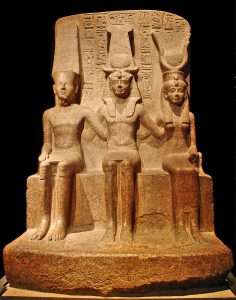
Arms in the form of a 'W'. [Ramses with Amun-Ra and Mut].
Reindeer?
Many 'W' and 'M' carvings found in same cave system. ['Ancient Unexplained Files'].
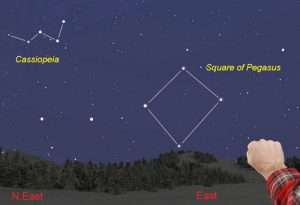 Elsewhere N. Oliver talks about the oldest carvings of a horse on ''horse bone'' within these Islands. These Islands that ONLY became an ISLAND after a massive tsunami from the NORTH gave depth to those sea channels {6000 years ago?}. Prior to that MARSH lands defined these islands from Europe S/E. The Greeks called this ISland Hyperborea {beyond the north wind}.
Elsewhere N. Oliver talks about the oldest carvings of a horse on ''horse bone'' within these Islands. These Islands that ONLY became an ISLAND after a massive tsunami from the NORTH gave depth to those sea channels {6000 years ago?}. Prior to that MARSH lands defined these islands from Europe S/E. The Greeks called this ISland Hyperborea {beyond the north wind}.
'Rock' in relation to ''deer''. 'Bone' in relation to ''horse''. Anything? Define subject material to get into a mind set. Start with wet/dry.

''Error runs down a plane while truth has to laboriously climb uphill''
And/or: "This sculpture known as the Swimming Reindeer, was created at least 13,000 years ago...Its carved from the tip of a mammoth tusk and shows a male and female reindeer with their heads raised and legs extended. The depiction is remarkable in its naturalism...The fragility of the connection between the two halves shows that it was not a practical object but rather a masterpiece of figurative art. Its significance to the people who created it remains a mystery to archaeologists. For me, it is one of the many things which tell me the Reindeer Goddess was important to humankind from back into very ancient times. " ['Elen of the Ways: Shaman Pathways' / E. Sentier].
Don't forget those first impressions. Try ''horn'' and/or ''elephant''.
Question. 'Swimming' in a sea or river?
Question 2. Recall the 'head' of Gemini relative to the extended 'paws' of the Sphinx.
Side note: ''You can become a great player through adversity.'' {'Finding Jack Charlton' / BBC 2}.
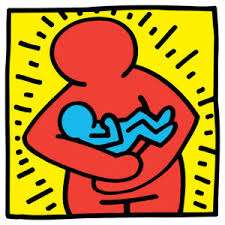
''At the cross her ''station keeping'' stood the mournful mother weeping - close to Jesus to the last. Briused, derided, cursed, defiled; she beheld her tender child; all the scourges rent.'' [10th 'Station of the Cross' / Magdala / Day 45 'Easter Week' / Kathleen Nichols].

To many lagers?
They call me the 'connecting animal' because i connect people, animals, and even stones with one another if i enter them. I am your fate or the 'objective I.' When i appear, I redeem you from the meaningless hazards of life. The 'fire' burning inside me burns in the whole of nature. If a man loses it, he becomes egocentric, lonely, disorientated and weak." ['Man and his Symbols'. Mentioned elsewhere].
Think about all the above relative to that ''bit''.
Spirit INTO Soul? {''midnight sun''?}.
Geocentric?
Rhodes Island ? Gebel el-Silsila?
Sekhmet?
'On Having No Head: Zen and the Rediscovery of the Obvious' / D. E. Harding.
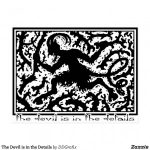
Pan ?
Something hinted at: "Once during those last eerie, in-between moments of waiting, I thought I 'fancied' seeing a great pair of antlers move silently against the sky line and then vanish. ''So it was only a 'deer'...!" I said to myself, as if scolding a silly child....But I then saw those antlers again...''Listen to me...listen!'' it said in a low voice. 'The gateway of your soul lies in an ancient forest.' Then it was gone.'' [Page 389 of the book by Douglas Monroe. Chapter entitled 'Beyond Word and Deed'].
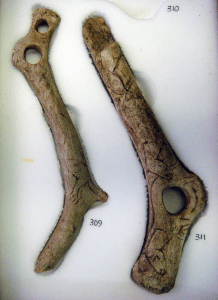
"Upper paleolithic reindeer antler tools with figurative art." Knee, heel or elbow?
Side note: The narrator Neil Oliver {'World of Stonehenge' / Part 1 } - talks about what man thought about in the religious sense 10,000 years ago in reference to deer antlers which are described as the remnants of a possible Mesolithic religion. ''Could have been a disguise more than likely ceremonial / ritual. When the person wore this he became something else, something more than a man. A transformation took place....becoming a red deer stag {or doe?} or maybe a hybrid...they were so much a part of nature, living within it, enveloped by it, and depending upon it not just in a practical everyday sense but in a profoundly magical and spiritual way as well. But as we know nature can be a very cruel mistress.''
Understand subject material {in its broader sense} to add to that very intuitive analysis.
Question. Male or female antlers?
Question. What {symbol/archetype?} would represent the 'female' element mentioned in the later stages of that final sentence?

A ''New City'' found near Karnak - serpentine boundaries. ONE large fish found within it.
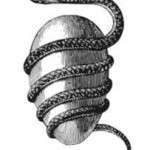
Inner/outer. A beginning or end?
''I am the wind that blows across the sea; I am the wave of the deep; I am the roar of the ocean; I am the stag of seven battles; I am the hawk on the cliff; I am the ray of sunlight; I am the greenest of plants; I am a wild boar; I am a salmon in a river; I am a lake on a plain; I am the word of knowledge; I am the point of a spear; I am the lure beyond the ends of the earth; I can shift my shape like a god.'' ['The Song of Amergin' / Ancient Irish Text].
Duration 'Six' minutes.
Side note: The name for the elbow in Latin is cubitus, and so the word cubital is used in some elbow-related terms, as in cubital nodes for example.
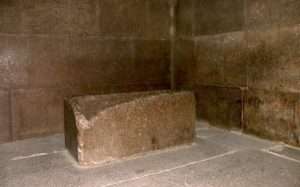
Beginning or end?
And/or: Og's destruction is told in Psalms 135:11 and 136:20 as one of many great victories for the nation of Israel, and the Book of Amos 2:9 may refer to Og as "the Amorite" whose height was like the height of the cedars and whose strength was like that of the oaks. The text states that he was the last giant of the Rephaites. His stature made him sleep on an iron bed,[1] which was about 9 cubits in length....
In Deuteronomy 3:11, and later in the book of Numbers and Joshua, Og is called the last of the Rephaim. Rephaim is a Hebrew word for giants. Deuteronomy 3:11 declares that his "bedstead" (translated in some texts as "sarcophagus") of iron is "nine cubits in length and four cubits in width", which is 13.5 by 6 feet (4.1 by 1.8 m) according to the standard cubit of a man.

Wallace Monument: The National Wallace Monument (generally known as the Wallace Monument) is a 67 m (220 ft) tower on the shoulder of the Abbey Craig, a hilltop overlooking Stirling in Scotland.[1] It commemorates Sir William Wallace, a 13th- and 14th-century Scottish hero.[2] National Wallace Monument and Ochil Hills in autumn The tower is open to the public for an admission fee. Visitors approach by foot from the base of the crag on which it stands. On entry there are 246 steps to the final observation platform, with three exhibition rooms within the body of the tower. The tower is not accessible to disabled visitors.[2]
The Book of Numbers, Chapter 21, and Deuteronomy, Chapter 3.
'Twentyone'?
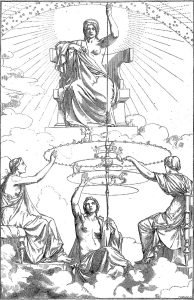
In ancient Greek religion, Ananke (/əˈnæŋkiː/; Ancient Greek: Ἀνάγκη), from the common noun ἀνάγκη ("force, constraint, necessity"), is the Orphic personification of inevitability, compulsion, and necessity. She is customarily depicted as holding a spindle. One of the Greek primordial deities, the births of Ananke and her brother and consort, Chronos (the personification of time, not to be confused with the Titan Cronus), were thought to mark the division between the eon of Chaos and the beginning of the cosmos.
Continued: As seen from a different perspective {can you 'see' it?}: "Who among you has transformed darkness {i.e.,something unknown} - into light {i.e.,a known 'quality'} bitterness into sweetness....Who among you waited each day for the light that shines when the 'King' visits the Doe? For it is at this time that the Glory is increased and he is called 'King' over all the kings of the 'world'...." ['Meditation and Kabbalah' / A. Kaplan].
And/or: ''It is not my intention to enter more closely into the relations between the Paracelsan Melusines and the mercurial serpent. I only wish to point out the alchemical prototypes that may have had an influence on Paracelsus, and to suggest that the longing of Melusina for a soul and for redemption has a parallel in that kingly substance which is 'hidden in the sea' {urchin'?}, and cries out for deliverence. Of this filius regius Michael Maier says: 'He lives and calls from the depths: Who shall deliver me from the waters and lead me to dry land?' {'forests'?}. Even though this cry be heard of many, very few take it upon themselves...to seek the 'king' {'spirit'? i.e., mercurius}...'' [Page 145 'Alchemical Studies' / C. G. Jung].
Spirit/Soul. Fire/Water {which and why?}...as a means....
''In 1517 the Ottomans took control of Palestine, leaving a deep footprint there. Pilgrims visiting Jerusalem today can still contemplate the city walls that Suleiman the Magnificent restored around the Old City.
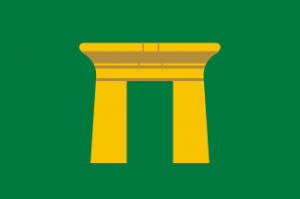
Something 'new'?
At this time, pilgrimages were still rare, but the Franciscans, who lived there, wrote down what they saw. One of them was Fr. Francesco Quaresmio (1583-1650), an enthusiast of the Holy Land. After spending several years there, and even taking over the Custody of the Holy Land for a few months, he left us a detailed description in his book Terrae Sanctae Elucidatio. Fr. Quaresmio writes that Mary Magdalene’s castle was called Magdalum, and “some claim that they saw her house.” For this author, the name Magdalum indicated “the towers and magnificent walls with which the castle was equipped”—in Aramaic, magdala means tower or fortress. And he adds: “This is why St. Jerome said that Mary was rightly called ‘Magdalene’, that is, ‘the one of the tower’, because of her singular faith and unwavering courage.”
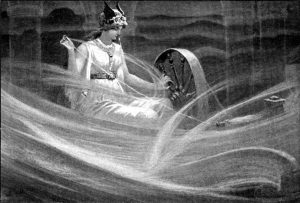
Whilst often thought of in terms of a stern woman, Ananke is also often depicted in serpent form, and it was said that the serpentine coils of Ananke and Chronos crushed the egg of creation to bring order to the cosmos and then encircled the universe, directing the passage of the heavens and the forward motion of time.
With most surviving ancient sources following the Hesiod genealogy of the gods it is perhaps not surprising that Ananke is rarely mentioned in surviving sources, although her name is used occasionally in Prometheus Bound (Aeschylus) and the Argonautica (Apollonius Rhodius). The Greek traveller and writer Pausanias would also state that in Corinth there was a temple dedicated to Ananke and Bia.
Fr. Quaresmio’s writing is interesting for several reasons, but I would like to underline just one: the symbolic interpretation of the Magdalene’s name. She was not only called this because she was originally from Magdala, but because she had a faith and love like a “magdala”, like a fortress. The Magdalene is like the holy city of Jerusalem, about which Isaiah sang: “We have a strong city; God makes salvation its walls and ramparts.”
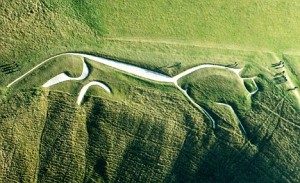 Mark Tully explores bitterness in all its forms - as a taste and emotion: 'With bitter herbs they shall eat': At Passover bitter herbs are eaten as a reminder of the bitterness of slavery. In the present day represented with horse - radish. [Radio 4. 18/11/18].
Mark Tully explores bitterness in all its forms - as a taste and emotion: 'With bitter herbs they shall eat': At Passover bitter herbs are eaten as a reminder of the bitterness of slavery. In the present day represented with horse - radish. [Radio 4. 18/11/18].
Side note: ''Animated adventures of characters in a herb garden, such as Sir Basil and Lady Rosemary, Bayleaf the gardener, Sage the owl, Dill the dog and Parsley the lion.''
The herb Basil {of the mint family} - is derived from the Greek for 'royal' or 'kingly'....Basilica also connected.
''The Latin word basilica derives from Ancient Greek: βασιλική στοά, romanized: basilikḗ stoá, lit. 'royal stoa'. The first known basilica—the Basilica Porcia in the Roman Forum—was constructed in 184 BC by Marcus Porcius Cato (the Elder).[2] After the construction of Cato the Elder's basilica, the term came to be applied to any large covered hall, whether it was used for domestic purposes, was a commercial space, a military structure, or religious building.''
And/or: ''Ashura, also known as Yawm Ashura is the tenth day of Muharram, the first month in the Islamic calendar {'Aries'?}. For Sunni Muslims, Ashura marks the day that Moses and the Israelites were saved from Pharaoh by God creating a path in the Sea. For Shia Muslims, it marks the day that Husayn ibn Ali, the grandson of the Islamic prophet Muhammad, was martyred in the Battle of Karbala. Ashura is a major holy day and occasion for pilgrimage in Shia Islam, as well as a recommended but non-obligatory day of fasting in Sunni Islam.'' [Internet].
Wet/Dry?
''In the Old Testament - in the Book of Ruth - Naomi; Ruth's mother in law, leaves Moab where she has lost her husband and two sons. She and Ruth goes to her home town Bethlehem where the barley harvest {'sweet'?} was beginning.. There she tells the people who greet her to call her Mara - which means bitter. Then Ruth marries Boaz owner of the barley and they have a son who becomes the grandson of King David. The women including Naomi celebrate the birth of this 'son' - for Naomi the bitterness has now changed into sweetness." Same radio program.
Higher/lower? Try ''bitter/sweeter'' as a means...?

County flag of Rutland. 'Acorns and horseshoes'? 'Seven' HIDDEN spaces?
And/or: The origin of the name of the county is unclear. In a 1909 edition of Notes and Queries Harriot Tabor suggested "that the name should be Ruthland, and that there is a part of Essex called the Ruth, and that the ancient holders of it were called Ruthlanders, since altered to Rutland";[3] however, responses suggest "that Rutland, as a name, was earlier than the Norman Conquest. Its first mention, as "Roteland", occurs in the will of Edward the Confessor; in Domesday it is "the King's soc of Roteland", not being then a shire; and in the reign of John it was assigned as a dowry to Queen Isabella.[4]
The northwestern part of the county was recorded as Rutland, a detached part of Nottinghamshire, in Domesday Book; the south-eastern part as the wapentake of Wicelsea in Northamptonshire. It was first mentioned as a separate county in 1159, but as late as the 14th century it was referred to as the 'Soke of Rutland'. Rutlandshire is an archaic and rarely used alternative name.

The most ancient of Sea dragons.
Rutland may be from Old English hryþr or hrythr "cattle" and land "land", as a record from 1128 as Ritelanede shows. However, A Dictionary of British Place-Names by A D Mills gives an alternative etymology, "Rota's land", from the Old English (Anglo-Saxon) personal name and land land.[5] It is from the alternative interpretation of red land that the traditional nickname for a male person from Rutland, a "Raddle Man", derives.'' [Wiki].
Continued: "Jewish Rabbis asserted that the tribe of Naphtali adopted this sign as their banner emblem: ''Naphtali as if a hind let loose'' - as if Capricorn were a deer, or antelope {desert one?} - others ascribed it to Benjamin, or to Reuben; but Aquarius more fitly represented the latter." [Notes on Capricorn within the book 'Star Names and Their Meaning']. Try ''pennant'' / ''banner'' and/or ''Gemini'' . As a means...?
And/or: "In Bible alchemy, Libra represents Reuben, the first son of Jacob. Reuben means Vision of the Sun. In the symbolism of the New Testament, Libra corresponds to the disciple Peter. Peter is derived from Petra, a stone or mineral." [Page 35 'The Zodiac and the Salts of Salvation'].
Petra of South Jordan?
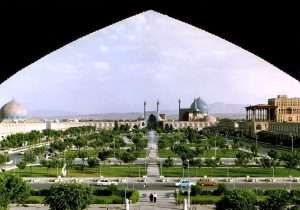
Charbagh gardens being 'overlooked' from a window.
Working example: ''Moses built an altar and NAMED it 'The Lord is my Banner': 'his hand upon me is the Banner of the Lord.' {Exodus 17: 8-16]. And/or: ''He has taken me into his banquet hall. His Banner OVER me is love {Song of Songs 2:verse 4]. And/or: ''The soul that drinks of god through understanding drinks the wisdom and science of god; through WILL, it drinks a sweet love and through memory, it drinks the pleasures and delights of the world {St. John of the Cross}'' [Pilgrimage: Lent / Day 'eleven' / Magdala / 2023].
'Chevrons'?
''So lets not forget how important water it is for our own hearts - so that this water can flow forth and enlighten any darkened aspect of ones being.''
'living water'.
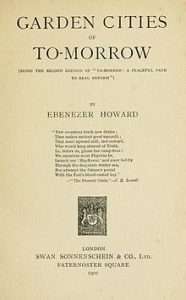

From a different perspective: Austral Islands paddle: ''Ritual vessels, used in some form of dance. But we dont know. And that is what i find personally really mysterious about these.'' ['Antiques Roadshow' / S46 EP8]. 'OARS' to enlarge. 'Place of Rowing'?
Side note: ''The Austral Islands are the southernmost group of islands in French Polynesia {S/W}, and such paddles were traded with Europeans who visited the islands on whaling ships during the first half of the century; it has been conjectured that they developed from earlier ceremonial paddles. The paddle is highly decorated, with crisply-carved repeating triangular motifs including ‘toothed suns’, which comprise concentric circles surrounded by ‘niho’ or triangular teeth, a feature prominent in Austral Islands carving. Indeed, many such paddles would have been carved using sharks’ teeth. The pommel at the top of the shaft is encircled by stylised figures wearing alternating headdresses {'eight' in total}....'' ['Tennants Auctioneers'].
'Lozenge' also used as part of the description.
Continued: ''Charbagh or Chahar Bagh (Persian: چھارباغ, romanized: chahār bāgh, Hindi: चारबाग़ chārbāgh, Urdu: چار باغ chār bāgh, meaning "four gardens" in Persian) is a Persian and Indo-Persian quadrilateral garden layout based on the four gardens of Paradise mentioned in the Quran. The quadrilateral garden is divided by walkways or flowing water into four smaller parts.[1] They are found in countries throughout Western Asia and South Asia, including Iran and India.[2]
''The Chahrbagh-e Abbasi (or Charbagh Avenue) in Isfahan, Iran, built by Shah Abbas the Great in 1596, and the garden of the Taj Mahal in India are the most famous examples of this style. In the Charbagh at the Taj Mahal, each of the four parts contains sixteen flower beds.''
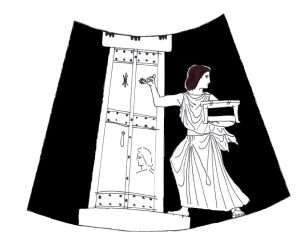
'Key' to enlarge.
And/or: Hero and Leander is the Greek myth relating the story of Hero (Ancient Greek: Ἡρώ, Hērṓ; [hɛː.rɔ̌ː]), a priestess of Aphrodite (Venus in Roman mythology) who dwelt in a tower in Sestos on the European side of the Hellespont, and Leander (Ancient Greek: Λέανδρος, Léandros), a young man from Abydos on the opposite side of the strait. Leander fell in love with Hero and would swim every night across the Hellespont to spend time with her. Hero would light a lamp at the top of her tower to guide his way.

Beginning or end? Khafre to enlarge.
Succumbing to Leander's soft words and to his argument that Aphrodite, as the goddess of love and sex, would scorn the worship of a virgin, Hero succumbed to his charms and they made love. Their secret love affair lasted through a warm summer. They had agreed to part during winter and resume in the spring due to the nature of the waters. One stormy winter night, Leander saw the torch at the top of Hero's tower. The strong winter wind blew out Hero's light and Leander lost his way and drowned. When Hero saw his dead body, she threw herself over the edge of the tower to her death to be with him.
Their bodies washed up on shore together in an embrace and they were buried in a lover's tomb on the shore.''
Gebel el Silsila to enlarge.

'Heart' shape?
Something closer to the 'mark' {key}: ''In Bible alchemy, Pisces represents Naphtali, the sixth son of Jacob, and means ''wrestling's of God.'' In the symbolism of the New Testament, Pisces corresponds to the disciple Philip. The birth of Benjamin is given in that wonderful allegory, the 35th {'thirtyfive'} chapter of Genesis. Benjamin is, therefore, the '13th' { 'thirteen'} child of Jacob.'' [Page 43 'The Zodiac and the Salts of Salvation' / Inez Perry].
Side note 2: "The blessed name, YHVH, which is the mystery of the Middle Pillar, is called Atah {THOU}. This is the mystery of all of gods banners and appellations. He clothes Himself in them all, and prides Himself in them, this being the mystery of the word Atah. This mystery teaches that everything in the universe and every Merkava {'chariot'} was created through permutations of..." [Page 135 'Meditation and Kabbalah' / A. Kaplan].
Question. Atah in relation to the Aten? ''Seat of First Occasion''?
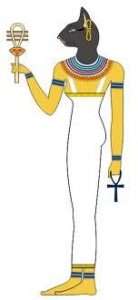
Keys to the 'Car'?
Understanding the above in relation to the word ''middle'' gives possible clues to a final resting place. That final 64th one.
And/or: ''The goddess Bast is invoked to inspire in us the sensual beauty that feeds our passion to create. Our renewed heart, the ab, is the seat of consciousness; it houses the essential desire that fuels the creative process....and in these Mysteries as Wholeness - that create the birth canal through which our souls purpose incarnates as it takes form on Earth.....That is why it is called the 'Fall'. It is the Fall into incarnation.....Falling is just another side of rising.'' [Page 104 'Shamanic Mysteries of Egypt' / N. Scully + L. S. Wolf].
Recall information on Uas {'Was'} sceptre. 'Rising' only?
From a different perspective: {with something extra?}: ''This concept of Celli Wig, a seat of government and therefore symbolic of the central recess of Arthurs soul, raises the whole question of the significance of the topographical description insisted on throughout this myth. That a 'boar hunt' should range from the west of Ireland, across the Irish Channel, to West Wales, thence to South Wales as far as the river Severn, and now be threatening Cornwall, clearly indicates some psychic concept.'' [Page 163 'A Celtic Quest' / J. Layard].
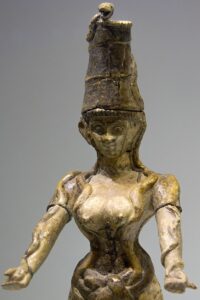
From a different perspective: Snake goddess of Knossos. 'Peak' hat?
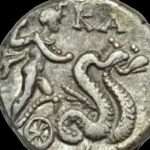
In a different form: Charioteer?
And/or: ''Wadjet, The Great cobra serpent goddess, is ancient. She is closely associated with Nekhbet-Mother-Mut. She was a fierce protector of children {'Tut'?}, and later of pharaoh's. From her position on the living uraeus crown, she spits fire at 'pharaoh's enemies....She spirals her way into our lives, opening and clearing the chakra centers with her kundalini {or life force} energy.'' [Card 16 'The Anubis Oracle' / N. Scully and L. Wolf].
N.B. Only Alfred was known as ''The Great''.
16 stela's around Amarna?
Coincidence or a meaningful one?
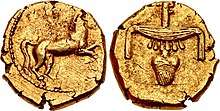
Costly?
''The full ancient Egyptian royal titulary consisted of up to five names meant to symbolise the power and might of the pharaoh:
- Horus name — the oldest form of a pharaoh's name, often enclosed in a serekh, a sort of "heraldic crest" representing a palace facade.
- Nebty name — the "Two Ladies", the heraldic goddesses Nekhbet and Wadjet, representing Upper and Lower Egypt respectively.
- Gold name — gold was strongly associated with eternity, but the meaning of this title is disputed.
- Throne name — (prenomen) the first of the two names written in a cartouche.
- Personal name — (nomen) the name given at birth, often the name by which a pharaoh is known today.
The full titulary was announced at the coronation, when a pharaoh officially became king.''
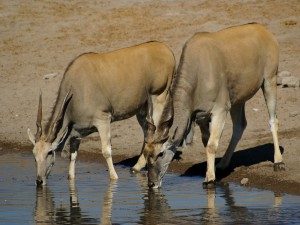
''Antelope are more deer like than other bovids." {wiki}. Question. Male or female?
Continued: South American {Indian} equivalent?..."So we were on the road again. Ahead of us lay the long, mesmerizing ride to Page, Arizona, to the upper reaches of the Grand Canyon. Here we would create our final ceremony. But first, we would spend the afternoon and early evening at a unique natural cathedral known as Antelope Canyon, where we would meet with Davlin, a Navajo shaman whose fierce protectiveness of his people would provide us with our last test of faith...Antelope Canyon is so sacred to the Navajo that visitors are allowed in only when accompanied by Native guides...Back outside as we were getting ready to be driven back, Davlin pointed up at a snake shape on the wall of Antelope Canyon's entrance and began to tell us about it. He illustrated each detail of what he was saying by pointing up at the snake's shape, moving his finger along the forty-foot formation.'' ['Serpent of Light Beyond 2012'].
Side note: Gazelle rather than Antelope? i.e., attributes of 'beauty' / 'grace' / 'swiftness' and ''unlike any other bovid- ''jumps into the air on all four legs {simultaneously} before fleeing'' [Wiki].
Stotting?
'Prancing Pony Inn' {Lord of the Rings}.
"The origins of the term "pony" {'little'?} can be traced back to the early 19th century in Britain. During that time, horse racing was a popular sport, and the term "pony" was commonly used to refer to a sum of twentyfive pounds."
# 'Carrying'?
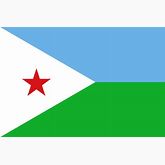
'Flag' of Djibouti - within the Horn of Africa. The tail end of something?
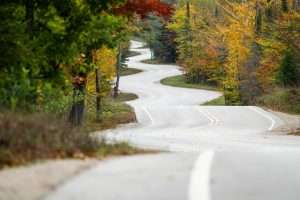
Every summer, thousands of tourists flock to Wisconsin’s Door County peninsula. Businesses shuttered throughout the winter and spring reopen to sell food and souvenirs as people explore the county’s cherry orchards and state parks. At Northport, at the tip of the peninsula, ferries run between the mainland and Washington Island, crossing a channel French sailors nicknamed Porte des Morts or “Death’s Door” for the large number of shipwrecks swept up in the currents.
But right before arriving at Death’s Door, travelers are thrown for a curve—or fifteen to be more specific. An unusually twisty stretch of Highway 'fortytwo', built in the early 1930s, has baffled visitors for decades. Who designed this surreal stretch of road? All clues would seem to point to the well-known Danish-American landscape architect Jens Jensen, so much so that locals have even nicknamed it, “Jensen’s Road.” And while Jensen did plenty for Door County, from founding a local school to helping layout parks, it turns out the story of Highway 42 is as full of twists as the road itself. {'Atlas Obscura'}.
And/or: {something hinted at}: "Draco, the Dragon can be associated with the snake...in mythology it was the snake snatched by Minerva from the 'giants' and whirled {'spiral'?} to the sky...It was the tempter of Eve in the Garden....But the Dragon would seem to be the most probable as the ancient possessor of the pole star {'Hippo'. Egyptian equivalent?} - then, as ours now is, the most important in the heavens; while this translation of the original is specially appropriate for such a winding figure....Renan saw a connection to the Book of Job to the ''crooked serpent'' {Moses 'crooked' staff?}....The Reverend Doctor Albert Barnes renders it ''fleeing''....but the revised version has ''swift'' - a very unsuitable epithet for Draco's slow motion, yet applicable enough to the more southern Hydra....Referring to Draco's change of position in respect of the pole from the effect of precession....the downfall of the dragon whose ''tail drew the third part of the stars of heaven''....and the conclusion of that verse {i.e.,Revelation 12:4} ''did cast them to the earth'' - would show a possible reference to meteor's. ['Star Names and Their Meaning' under Draco].
Blake to enlarge.
''Transcendent third''? And/or internal volume of sarcophagus relative to external in relation to ''flesh eater''.
Recall the ancient Lion {Asad} that covered a ''third of the heavens''.
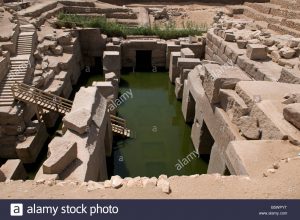
Osirion at Abydos. 'Flower' head found inscribed. Above/below the 'clouds'?
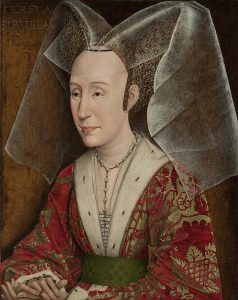
''Tall, two-horned and flowing''? {see below}.
''The core of the Osirian Mysteries began midmonth and lasted ten days from the 12th to the 21st....Two temples were the major centers : Abydos in Upper Egypt commenerated his death, while Busiris in Lower Egypt celebrated his resurrection during winter solstice rights....Isis and sister mourned the dead Osiris, following a burial sledge {pallet?} to the grave....Other priestesses carried winnowing baskets that contained the seed gathered from the LAST harvest of the PREVIOUS year. It was said that such 'baskets' containd the limbs of Osiris which had been gathered by the sisters....High priests from each of the 'fortytwo' nomes carried the canopic JARS that contained the relics of OSIRIS that were ''gathered into a single body''. On the 12th day of the month, two black cows were YOKED together to a plough made of tamarisk and a ploughshare of black copper....The 12th day of the month was also the time at which the Orionid meteor showers occured, which we still see in mid October - this resembles scattered seed falling from the body of the Orion constellation, which is the sahu, or light body of Osiris.'' [Page 292/3 'Imagining the World Into Existence'].
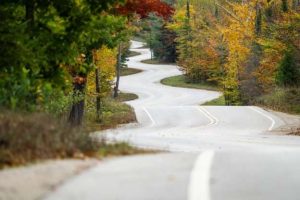
State Trunk Highway 42 (often called Highway 42, STH-42 or WIS 42) is a state highway in the U.S. state of Wisconsin. It runs for 135 miles (217 km) north–south in northeast Wisconsin from Sheboygan to the ferry dock in Northport. Much of the highway is part of the Lake Michigan Circle Tour from the eastern junction with U.S. Highway 10 (US 10) in Manitowoc to its junction with WIS 57 in Sister Bay. WIS 42 parallels I-43 from Sheboygan to Manitowoc, and parallels WIS 57 throughout much of the route, particularly from Manitowoc to Sturgeon Bay, meeting the northern terminus of WIS 57 in Sister Bay. 'Thirtyfive'?
A working example: ''Excuse me. That man in the corner, who is he?''
''He's one of them rangers. Dangerous folk they are, wondering the wilds. His real name i've never heard, but around here he's known as Strider'' ['Lord of the Rings' / 55mins].
Refresher: ''Every summer, thousands of tourists flock to Wisconsin’s Door County peninsula. Businesses shuttered throughout the winter and spring reopen to sell food and souvenirs as people explore the county’s cherry orchards and state parks. At Northport, at the tip of the peninsula, ferries run between the mainland and Washington Island, crossing a channel French sailors nicknamed Porte des Morts or “Death’s Door” for the large number of shipwrecks swept up in the currents.
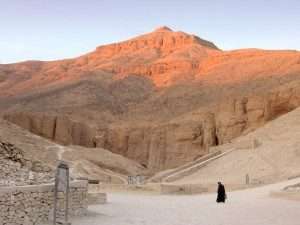
'She who loves silence'. Rested on the seventh?
But right before arriving at Death’s Door, travelers are thrown for a curve—or fifteen to be more specific. An unusually twisty stretch of Highway 42, built in the early 1930s, has baffled visitors for decades. Who designed this surreal stretch of road? All clues would seem to point to the well-known Danish-American landscape architect Jens Jensen, so much so that locals have even nicknamed it, “Jensen’s Road.” And while Jensen did plenty for Door County, from founding a local school to helping layout parks, it turns out the story of Highway fortytwo is as full of twists as the road itself.''
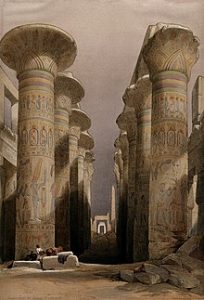
The middle ground.
Side note: "Forty-two is often interchangeable with 40, for 6 weeks of 7 days are often regarded, like the 40 days, as a time of preparation or waiting. Medieval Christian theologians pointed out
that there were 42 stations that the Children of Israel had to pass between Egypt and Sinai, and that this sequence appears again in the incarnation of Christ in the forty-second generation after Abraham. Or else they might speak of the 6 connected with human acts multiplied by the 7 of resting, which is the sabbath, and see this as an allusion to the church in this world, living in hope of eternal peace. Forty-two is also the number of judgment, however, for the Egyptian Book of the Dead speaks of 42 judges who will examine the dead; it also enumerates 42 sins. In the Old Testament one reads that 42 boys were torn to pieces by bears because they had ridiculed the prophet Elisha (2 Kings 2:23-24), and Jehu kills 42 brothers of Ahaziah (2 Kings 9: 27)." {'Mystery of Numbers' / A. Schimmel}.

] Flat top {'platform'}. Question. Who first witnessed the 'resurrection'?
And/or: I was re-reading all the HP books in preparation for Hogwarts Legacy and in the 8th Chapter of "Philosopher's Stone", this was the brief description given to staircases and doors leading from one place to the other...
 "There were a 142 staircases at Hogwarts, wide sweeping ones, narrow rickety ones, some that lead somewhere different on a Friday, some with a vanishing step halfway up that you remember to jump {'leap'?}, then there were doors that wouldn't open unless you asked politely or tickle them exactly in the right place, and doors that weren't really doors at all but solid wall just pretending. It was also very hard to remember where anything was because it all seemed to move around alot."
"There were a 142 staircases at Hogwarts, wide sweeping ones, narrow rickety ones, some that lead somewhere different on a Friday, some with a vanishing step halfway up that you remember to jump {'leap'?}, then there were doors that wouldn't open unless you asked politely or tickle them exactly in the right place, and doors that weren't really doors at all but solid wall just pretending. It was also very hard to remember where anything was because it all seemed to move around alot."
Since the devs mentioned that it'd be a FULLY realized Hogwarts, do you think that much attention to detail will be given to the castle?

'The Greatness of Mexico'. The 'base' of which was buried in the ground. Water feature for headgear?
Side note: ''Further north, women were great shamans. In Iceland the priestess was called Spakona, from the word spa, which meant to prophesy. She conducted rites of sacred song and sat upon a raised platform, which symbolised her ability to see beyond the ordinary. It was said that Odin himself consulted a seeress seeking to know his destiny.'' [Page 140 'The Book of Shadows' / P. Curott].
''Iceland is home to the worlds oldest parliament.'' ['The Chase' / 2018].
And/or: Iceland is a European country with 130 active and inactive volcano's.''
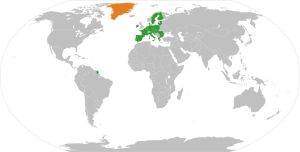 ''Iceland is closely connected to other European countries in a historical, political, and a cultural sense. Although Iceland is not a member of the European Union (EU), its relation to the EU is mainly based on the EEA Agreement, which came into effect in 1994. Iceland is an island, a European country, located midway between North America and mainland Europe. It lies just below the Arctic Circle between sixtyfour and 66 degrees north. The capital is Reykjavik. It is the northernmost capital in the world and is located exactly halfway between New York and Moscow. Iceland, Liechtenstein and Norway are the only countries in the EEA that are not in the EU. The EU Common Fisheries Policy is an important reason why Greenland, Norway and Iceland stay outside the EU.''
''Iceland is closely connected to other European countries in a historical, political, and a cultural sense. Although Iceland is not a member of the European Union (EU), its relation to the EU is mainly based on the EEA Agreement, which came into effect in 1994. Iceland is an island, a European country, located midway between North America and mainland Europe. It lies just below the Arctic Circle between sixtyfour and 66 degrees north. The capital is Reykjavik. It is the northernmost capital in the world and is located exactly halfway between New York and Moscow. Iceland, Liechtenstein and Norway are the only countries in the EEA that are not in the EU. The EU Common Fisheries Policy is an important reason why Greenland, Norway and Iceland stay outside the EU.''
''A character from Christmas folklore called Yule Lad is believed to leave sweets or rotting potatoes in the shoes of Icelandic children.'' ['Impossible' / S6 EP31].
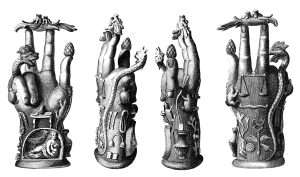
The hand of Sabazios. Thumb = pinecone?
''A shoe mender, shoe repairer, a shoe-maker, one who hand-crafts shoes. In modern day, a cobbler is a master craftsman, an artisan. A cobbler is a patcher and a stitcher and a shiner and a cordwainer and a girdler and glover and a thonger and ultimately—a smile maker.''

Sharps and Flats.
A working example: ''Very few Huastec statues have been found in their archaeological context, as most have been looted. Those that have been found in situ have been discovered on top of large platform mounds....They left behind no writing....The Huastec region was so multiethnic and multilinqual that it didn't make sense to convey ideas via text, but rather to convey common ideologies and narratives through imagery alone {'hieroglyph'?}....La Grandeza de Mexico statue was almost seven feet tall, but measures just three inches from front to back {'eye of the needle'?}...She wears a long skirt down to her ankles and a loincloth with 'three knots'. Around her neck an oval pendant made of a limpet shell. Most striking is her headdress, which is tall, two tufted, and flowing....The Huastec network extended to the Maya region....They may have even made forays as far as the S/E U.S.A {Hopi's?}. '' [Page 38 'Archaeology' / March/April 2022].
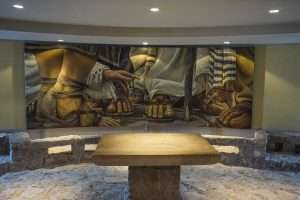
Galilee/Dead sea as a means....? Hemline? Best foot forward?
Salt water as opposed {to say} fresh water?
Universal mind set?
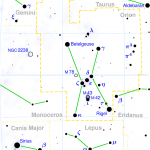 Continued: Ram headed Sphinx found at Gebel el-Silsila {'headless'} - Left insitu since carved. On its 'right' rump {'thigh'?} can be seen in 'painted' form a hippo and a reference to Amenhotep III, year 34. On its left rump {in a later program} an inscription {'brand' name?} can be seen in the form of an hour glass {or figure of 'eight'?} -One triangle pointing up MEETING another triangle pointing down {'fire/water'?}. A mention is made of a gap purposely left UNDER the Sphinx ready for a ''sledge'' to be placed.....A 'little' sphinx found. ['Lost Treasures of Egypt'].
Continued: Ram headed Sphinx found at Gebel el-Silsila {'headless'} - Left insitu since carved. On its 'right' rump {'thigh'?} can be seen in 'painted' form a hippo and a reference to Amenhotep III, year 34. On its left rump {in a later program} an inscription {'brand' name?} can be seen in the form of an hour glass {or figure of 'eight'?} -One triangle pointing up MEETING another triangle pointing down {'fire/water'?}. A mention is made of a gap purposely left UNDER the Sphinx ready for a ''sledge'' to be placed.....A 'little' sphinx found. ['Lost Treasures of Egypt'].
Little/Large.

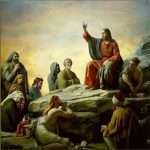 And/or: [Day 6: Peter's House in Caphernaum: Healing a Paralytic / Kathleen Nicols]. BACKGROUND = Octagonal space { ''8th day''} with 'three' entrances - peacock in the 'middle' {''new life''}. ''In Mark, Chapter 2, a paralyzed 'child' is brought to Jesus - carried on a pallet by four persons {unconscious act?}. Couldn't get through the 'door' {gateway?} so ''lowered down'' through the 'roof' {attic/loft?}: 'Rise up, take your pallet and go home' And/or: ''In Dantes lowest level of hell, it is so cold that one feels paralyzed, unable to move. In fact at the bottom of hell is a picture of satan stuck in ice - shedding tears. The moral of the story is where are we frozen? where are we paralized? {'floodwaters'?}''
And/or: [Day 6: Peter's House in Caphernaum: Healing a Paralytic / Kathleen Nicols]. BACKGROUND = Octagonal space { ''8th day''} with 'three' entrances - peacock in the 'middle' {''new life''}. ''In Mark, Chapter 2, a paralyzed 'child' is brought to Jesus - carried on a pallet by four persons {unconscious act?}. Couldn't get through the 'door' {gateway?} so ''lowered down'' through the 'roof' {attic/loft?}: 'Rise up, take your pallet and go home' And/or: ''In Dantes lowest level of hell, it is so cold that one feels paralyzed, unable to move. In fact at the bottom of hell is a picture of satan stuck in ice - shedding tears. The moral of the story is where are we frozen? where are we paralized? {'floodwaters'?}''
Dionysos link? i.e., something 'foreign' carried over land on rollers? or shoulders?
'Pallets'?
''Stuck'' to enlarge.
Side note: "A typical set of taboos binding this Hercules is quoted by Sir James Frazer in his Golden Bough: they were applied to the Flamen Dialis, the successor of the Sacred King of Rome whose war-leadership passed to the twin Consuls at the foundation of the Republic.
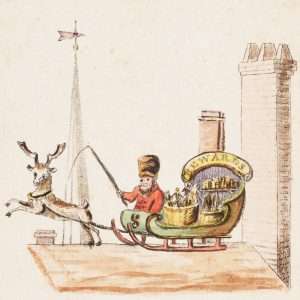
Sledge / Pallet?

Small one found under it. 'Double' to enlarge.
The Flamen Dialis might not ride or even touch a horse, nor see an army under arms, nor wear a ring which was not broken, nor have a knot in any part of his garments; no fire except a sacred one might be taken out of his house; he might not touch wheaten flour or leavened bread; he might not touch or even name a goat, a dog, raw meat, beans and ivy; he might not walk under a vine; the feet of his bed had to be daubed with mud; his hair could be cut only by a free man and with a bronze knife; and his hair and nails when cut had to be buried under a lucky tree; he might not touch a dead body nor enter a place where one was buried; he might not see work being done on holy days; he might not be uncovered in the open air; if a man in bonds were taken into his house, the captive had to be unbound and the cords had to be drawn up through a hole in the roof and so let down into the street.
Frazer should have added that the Flamen owed his position to a sacred marriage with the Flaminica: Plutarch records in his Roman Questions (50) that he could not divorce her, and had to resign his office if she died. In Ireland this Hercules was named Cenn Cruaich, 'the Lord of the Mound', but after his supersession by a more benignant sacred king was remembered as Cromm Cruaich ('the Bowed One of the Mound')." ['The White Goddess'].
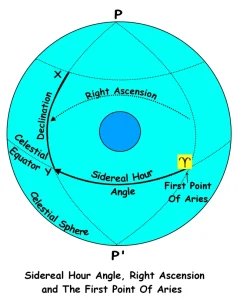
"The first point of Aries defines the ecliptic coordinate of (0°, 0°). It is on the celestial equator at both the left and right extremes of the sky chart, with the ecliptic (the orange dotted sine curve) passing through it."
Continued: Working example: ''Akhenaten's god could be accessed directly, through the open temple roof. The benben - a solar cult object {triangle/pyramid shape therefore 'fire' link i.e., 'pyr'} - associated with Ra of Heliopolis since the start of the dynastic age - offered an alternative focus of worship. Over the centuries the benben had varied in appearance from temple to temple, it might be a cone or pyramid shaped structure, an obelisk, a boulder or even a meteorite. The Amarna benben has not survived, but images in the elite tombs suggest that it was a large, round topped stela which stood on a raised platform next to a large statue of a seated Akhenaten.'' [Page 40 'Nefertiti's Face' / J. Tyldesley].
Try Static/dynamic for a different take on the same theme.
A working example: ''The American writer and critic Dorothy Parker is credited with saying that the Bloomsbury Group “lived in squares, painted in circles and loved in triangles”.
Lotus to enlarge.
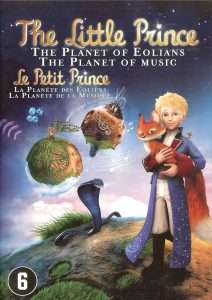 Synchronistic example: "It was early summer, and I was on the verge of turning forty. I found myself entertaining a recurring daydream of escaping from time. I would be hustling my son out the door to get him to school, or walking briskly to work on the day of a deadline, or castigating myself for being online when I should have been methodically and efficiently putting words on paper, and I would have this vision of myself as a character in a video game discovering a secret level. This vision was informed by the platform games I loved as a child – Super Mario Bros, Sonic the Hedgehog and so on – in which the character you controlled moved across the screen from left to right through a scrolling landscape, encountering obstacles and adversaries as you progressed to the end of the level. In this daydream, I would see myself pushing against a wall or lowering myself down the yawning mouth of a pipe, and thereby discovering this secret level, this hidden chamber where I could exist for a time outside of time, where the clock was not forever running down to zero." [Mark O'Connell / The Guardian].
Synchronistic example: "It was early summer, and I was on the verge of turning forty. I found myself entertaining a recurring daydream of escaping from time. I would be hustling my son out the door to get him to school, or walking briskly to work on the day of a deadline, or castigating myself for being online when I should have been methodically and efficiently putting words on paper, and I would have this vision of myself as a character in a video game discovering a secret level. This vision was informed by the platform games I loved as a child – Super Mario Bros, Sonic the Hedgehog and so on – in which the character you controlled moved across the screen from left to right through a scrolling landscape, encountering obstacles and adversaries as you progressed to the end of the level. In this daydream, I would see myself pushing against a wall or lowering myself down the yawning mouth of a pipe, and thereby discovering this secret level, this hidden chamber where I could exist for a time outside of time, where the clock was not forever running down to zero." [Mark O'Connell / The Guardian].
P.S. Seti I tunnel - the longest in the Valley of the Kings.

Papal Cap = crown of head. Small nipple? Anything?
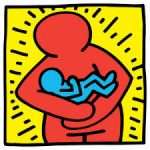 Continued: ''In Egypt the child was born upside down, falling head first into the loving arms of the midwife goddess. Osiris goes head down into this world to be reborn....It is also the position in which the dead were carried in their coffins into the tomb, their HEADS PIERCING the veil between the worlds....This death and birth image on the second shrine of Tutankhamun depicts the dark hour of inversion {Magdalene?} - BEFORE our rebirth, which according to the Book of the Dead ''will set the stars aright''.....The tricky rebirth is accomplished by focusing on the ba, the divine SOUL {Nefertiti/Nefertari?} that exists WITHIN the spiritual light {Sirius?}. That soul is not upside down. On a physical level, that fear may be linked to the thought of dying and being carried HEAD FIRST into the tomb. Metaphorically, the god Osiris fell face down {dark face as opposed to golden one?} BENEATH the horizon when the stars of Orion disappeared in the west for seventytwo days before Orion's reappearance at dawn on the opposite horizon {'Scorpion?}.'' [Page 277 same book].
Continued: ''In Egypt the child was born upside down, falling head first into the loving arms of the midwife goddess. Osiris goes head down into this world to be reborn....It is also the position in which the dead were carried in their coffins into the tomb, their HEADS PIERCING the veil between the worlds....This death and birth image on the second shrine of Tutankhamun depicts the dark hour of inversion {Magdalene?} - BEFORE our rebirth, which according to the Book of the Dead ''will set the stars aright''.....The tricky rebirth is accomplished by focusing on the ba, the divine SOUL {Nefertiti/Nefertari?} that exists WITHIN the spiritual light {Sirius?}. That soul is not upside down. On a physical level, that fear may be linked to the thought of dying and being carried HEAD FIRST into the tomb. Metaphorically, the god Osiris fell face down {dark face as opposed to golden one?} BENEATH the horizon when the stars of Orion disappeared in the west for seventytwo days before Orion's reappearance at dawn on the opposite horizon {'Scorpion?}.'' [Page 277 same book].
Refresher: In the 'UNfinished' temple of the Sphinx were found - buried in pits - three upside down statues of Khafre.

SEEN Upside down in the Southern Hemisphere.
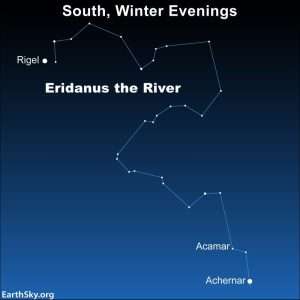
Begins at the foot of Orion.
Side note: ''At the outset of The Odyssey, with all the mashismo of solar destructive power, our hero launches a private raid on Ismarus, a Thracian town for ''extra booty''....The Ciconians, the people from the surrounding area, rally and kill six men from each ship {'twelve' ships}, a total of seventytwo...'' [Page 87 'The Hero and the Goddess' / J. Houston].
And/or: 72 days for embalment.
Continued: Question. Does the Scorpion move backwards? When?
REFRESHER: "The light of the body is the eye: if therefore thine eye be 'single', thy whole body {'temple'?} shall be filled with light", [Matthew 6:22]. Explained within.
And/or: 'The star of your BEING is rising'.
''Westward leading, still proceeding, guide us to thy perfect light.......''
 ''The star{pentagram} in Egyptian art has five appendages - which resembles a person - because the starry realm is also the realm of human souls. Upright relates to the east. Upside- down one the west....The pentagram therefore becomes a logical expression for the human light in the Duat at the moment of turnaround.'' [Page 204 'Imagining the World Into Existence' / N. Ellis].
''The star{pentagram} in Egyptian art has five appendages - which resembles a person - because the starry realm is also the realm of human souls. Upright relates to the east. Upside- down one the west....The pentagram therefore becomes a logical expression for the human light in the Duat at the moment of turnaround.'' [Page 204 'Imagining the World Into Existence' / N. Ellis].
Try 'Backward'?
Cassiopeia?
Side note: Earth Mother, Heavenly Father reversed with earth Father, heavenly Mother = serpent/white-bird link. [Page 138/158 'The Gnostic Jung' / S. Hoeller].
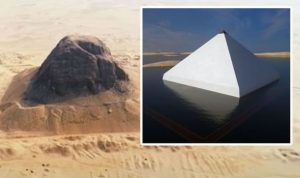
Senusret II was the fourth pharaoh of the Twelfth Dynasty of Egypt who ordered for the construction of the Pyramid of Lahun before his death. The ancient ruler took a great deal of interest in the Faiyum oasis region and began work on an extensive irrigation system from Bahr Yussef through to Lake Moeris in Middle Egypt....The site was occupied during the Middle Kingdom into the late Thirteenth Dynasty, and then again in the New Kingdom. The ancient name of the site was rꜣ-ḥn.t, literally, "Mouth (or Opening) of the Canal".
And/or: Earls /Nobles walk backwards as the Queen approaches at the State Opening of Parliament {i.e., Earl of Arundel castle - the oldest in the country}. 'Secrets of Great British Castles' / S2. E6.

Walking backwards. Seventytwo to enlarge.
And/or: ''It has long been suspected that Hathors return from Nubia in the 'Goddess in the Distance myth' is a 'solstice' return. Her role in 'turning back' the years and rebirth by day is as old as the Pyramid Texts, as the king proclaims in Utterance 405: {the legs walking backwards} - when identifying with the Eye of Re: For i am that eye of yours on the horn of Hathor, which brings back the years through me.'' [Page 77/278 'Hathors Alchemy'].
''I had already changed....like some cirada clinging to a tree root it once called home, my shell had cracked and been inalterably rent. In order to grow, to live, to survive, i had to back out of my shell.'' [Page 36 'Dreams of Isis. A Womans Spiritual Sojourn' / N. Ellis].
''Carapace''?
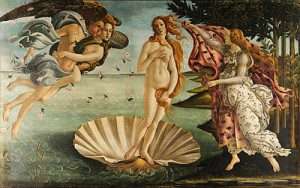 A working example: It helps to think of the secret at the core of alchemy as a very special and sophisticated variety of meme. Like a spore or a seed, the meme has a protective shell that is also attractive to appropriate hosts. In the case of the alchemy meme, that shell is the seductive allure of the transmutation of base metal into gold. Even if one absorbs the outer shell of the alchemy meme, however, there is no guarantee that the inner core will blossom and the meme become active. For that to happen, a series of shocks or initiations is required.....
A working example: It helps to think of the secret at the core of alchemy as a very special and sophisticated variety of meme. Like a spore or a seed, the meme has a protective shell that is also attractive to appropriate hosts. In the case of the alchemy meme, that shell is the seductive allure of the transmutation of base metal into gold. Even if one absorbs the outer shell of the alchemy meme, however, there is no guarantee that the inner core will blossom and the meme become active. For that to happen, a series of shocks or initiations is required.....
................................................

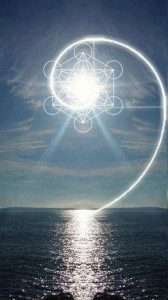
Inner / outer.
The three fiery pomegranates of the pediment, which Fulcanelli informs us “confirm the triple action of a single procedure,” are the three upper sefirot, Kether, Chokmah, and Binah. The capitals of the pillars are Chesed and Gevurah and the feet are Hod and Netzach. The center niche is Tiferet, here displaced upward and focused on the rising-sun/scallop-shell motif above the inscription. The bottom step represents the foundation of Yesod and the greenery below it symbolizes Malkuth. The three pillars of the Tree are clearly delineated. The middle pillar is curiously focused on the rising sun of Tiferet, with another larger, inner sun—“fire above the abyss,” as the I Ching puts it—rising above the ledge attributed to Daat. The ornamentation in this space suggests the geometry found on another Daat image given by Fulcanelli, that of the Planetary Metals from Notre-Dame-de-Paris.... ['The Mysteries of the Great Cross of Hendaye'].
Sycamore?
Fig?
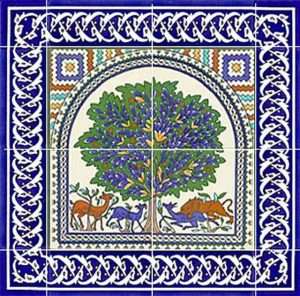
Clearly the attainment spells the eclipse of the Dragon. Where light shines no darkness can there abide. For being the basis of the instinctual life, harnessed and chained to the needs and clearly perceived ideals of the psyche, the dragon shuns the sunbeams and the daylight. No longer do its projections and compulsive automatisms haunt the light of consciousness. No longer is the personality tortured as by some foul and evil presence. Its needs and dictates, once so imperious, cease their urgency, finding their proper place within the natural economy.
AND/OR: According to one popular writer, it is a means of obtaining self-knowledge through breaking down the shell of fantasy in which the ordinary person is confined. Analysis is sometimes defined as a process the object of which is to enhance consciousness. It proceeds by making conscious those unconscious elements in the instinctual and morally compulsive life which experience demonstrates to be in conflict with or untrue to reality. The crystallization of the field of consciousness, with its consequent narrowing of the possibilities of experience, produces a species of living death. The alchemists proposed to kill death. Their object, by the psychological method of interpretation, was to disintegrate this inflexible rigidity of mind....
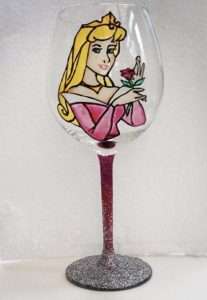
'Glass' of wine or water?
This process they call the dissolution or putrefaction. Consciousness is broken down into its component parts. From this apparently amorphous and homogenous resultant, it was their intention to reassemble the fundamental elements of consciousness on an entirely new and healthy basis. It was proposed to establish another foundation altogether, one capable of functioning in a completely regal and spiritual way. So that the divine root which, according to their theory, had become occultated and subordinated by the presumption of man’s ego, is able to manifest through a mentality which is free from the defects which characterize the average intelligence. Consciousness is to be vivified utterly and is not separated from the Unconscious by a sharp and unnatural cleavage or partition from the other levels of the psyche. Thus the contents of the one part, by a reversal of values and functions, have full access of entry into the other, and vice versa....The true furnace is a little simple shell; thou mayst easily carry it in one of thy hands. The glass is one and no more; but some philosophers have used two, and so mayst thou. As for the work itself, it is no way troublesome.... ['The Philosophers Stone'].

Moustache only?. Any 'beard'? Any in Egypt?
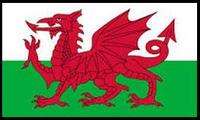
''The tongue of the Welsh dragon is the symbol of the Welsh Language Society.'' Grasping his tongue?
Side step: ''....the old dragon the guardian of the apples of Hesperides {i.e., west} - force it to fight {with 'shield and spear'}...combat of the two natures {i.e., fixed and volatile and or static/dynamic?} - the secret materials whose reciprocal destruction opens the first door to the Work. These bodies are Nicolas Flamels 'two dragons', Basil Valentines 'eagle and lion', and Philalethes and Cosmopolites 'magnet and steel'...'' [Pages 359/274 'The Dwellings of the Philosophers'].
''Steel is an alloy, principally consisting of carbon and iron.'' ['Riddiculous' / ITV].
While recalling that Minerva had a shield of female Goat skin - who became the ''wet nurse of Jupiter'' and Tutankhamun had a shield of Leopard skin - Dionysos link?
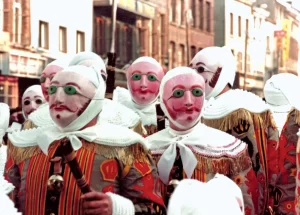
Shrove tuesday - Belgium. One of the Low Countries.
A work in progress: ''The suggestion that Nefertiti changed her role, and in so doing became invisible to us, deserves more consideration.....a theory proposed that Nefertiti transformed herself into a female king to rule alongside Akhenaten as a co-regent....Much of this evidence comes from the Tutankhamen tomb....a gilded statuette which depicts a king dressed in a kilt and white crown, standing on the back of a leopard...with ''prominent breasts and low hips''....some argue it is for a women, others for a young Tutankhamen.'' [Page 179 'Nefertiti's Face' / J. Tyldesley].
'Broad hipped'?
N.B. 'Amen' {Amun} NOT Aten.
Side note: Regent = 'Kings Mother' and ''Hereditary Princess'' link. [Pages 11/14 'Hatshepsut' / Metropolitan Museum of Art].
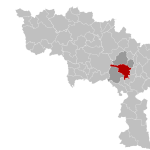
Binche in Belgium. Pointing N/W?
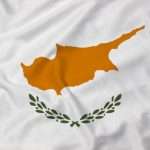
Flag of Cyprus. 'Pointing' N/E? 'Nose'?
Continued: Something extra: {something hinted at}: "YELLOW: Leo, the Lion. Leo is ruled by the Sun, whose colour is orange. Here is a seeming contradiction like that between the colour of Gemini and its ruler, Mercury. On the tree of life, too, the sphere of the sun is yellow. The thing suggested is an interchange between the mercurial and solar potencies, and this reminds us that Mercury is the ''metal'' with which alchemists work to produce the ''Stone'' which changes Saturn {lead} into gold {Sol, the sun}. [ Page 66 of the book by P. F. Case. Vol 1. From the chapter entitled: 'Correlation of Sound and Colour'].
Leo/Vigo? All as a means....?
And/or: "Arcturus, the fourth brightest star in the night sky, and the brightest star in the northern constellation Boötes, with an apparent visual magnitude of −0.05. It is an orange-coloured giant star 36.7 light-years from Earth."
Side note: ''Around 1000 Gilles, all male, some as young as three years old, wear the traditional costume of the Gille on Shrove Tuesday. The outfit features a linen suit with red, yellow, and black heraldic designs (the colours of the Belgian flag), trimmed with large white-lace cuffs and collars. The suit is stuffed with straw, giving the Gille a hunched back.[1]
Gilles also wear wooden clogs and have bells attached to their belts.[2] In the morning, they wear a wax mask of a particular design. After reaching the town hall, they remove these masks for the afternoon. During the afternoon parade, Gilles throw blood oranges to the crowd or at its members, and some wear large, white, feathered hats made of ostrich feathers. Gilles carry ramons, tied bunches of twigs that are said to ward off evil spirits, and baskets in which to carry the oranges.[1]
Zenith?
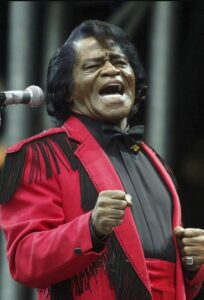
The godfather of Soul.
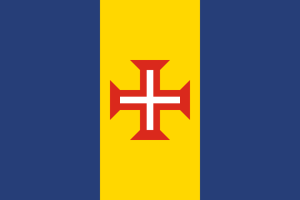
Pearl of the Atlantic.
"A Godfather cocktail is usually garnished with a twist of an orange citrus friut."
'Godmother'?
Side step: ''The War of the Oranges is given to the 1801 French and Spanish invasion of Portugal.'' ['The Chase'].
And/or: ''So Los Angeles is sometimes called The Big Orange because of the fruit that grows in that city's warm climate. The American motion picture and television industries are based in Los Angeles. So it is not surprising that it is called The Entertainment Capital of the World.''
High/low. Hot/cold. Balance between the two?
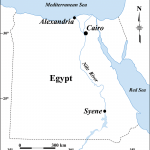
'Upward shift' = S/W?
Continued: "Walking towards the right at the bottom of picture {lowest level} are seven people with animal heads. They're called neters, and each of them has an orange, red oval above its head - called the egg of metamorphosis - a certain stage of resurrection - a biological change. They hold an image of that transition as they walk along that line {'line of sight'?} then suddenly there's a 90 degree shift upward - and now walking perpendicular to their first direction. [Pages 43 and 128 'The Ancient Secret of the Flower of Life' / Vol 1].
Embossed/Debossed?
''First, let us say that , according to the sacred language, the term philosophers stone, means the stone which bears the sign of the sun. The solar sign is characterized by its red coloration which can vary in its intensity....Composed of a multitude of small grains or crystals which were red or orange.....a power equal to 600 times the unit....'' [Page 134-136 'The Dwellings of the Philosophers' / Fulcanelli].
Something 'set in stone'. In the spiritual sense of the word - not material. 'See' it?
Side note: ''Albert Einstein's surname when translated into English is - One Stone...'' ['The Chase' / 2018].
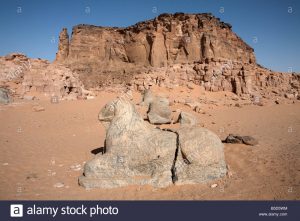
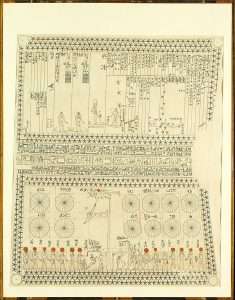
Astro ceiling in Senenmut bare tomb chamber. 'Folded'?
Hatshepsut had her tomb dug in the Valley of the Kings (KV 20) by her vizier and High Priest of Amun, Hapuseneb. She had previously had a tomb cut for herself as queen regnant under Tuthmosis II, its entrance 220 ft (72 m) up a 350-ft (91-m) cliff face in a remote valley west of the Valley of the Kings. This was found by local people in 1916 and investigated by Howard Carter in rather dangerous circumstances. The tomb had never been used and still held the sandstone sarcophagus inscribed for the queen. Carter wrote: 'as a king, it was clearly necessary for her to have her tomb in The Valley like all other kings - as a matter of fact I found it there myself in 1903 - and the present tomb was abandoned. She would have been better advised to hold to her original plan. In this secret spot her mummy would have had a reasonable chance of avoiding disturbance: in The Valley it had none. A king she would be, and a king's fate she shared.'
To understand what its real purpose is - find more info. on Hatshepsut.
 "You can follow two paths in the mountains, Her-Bak,'' said the sage. ''The first winds round it with many a twist, exploring; the slope is gentle, the ascent easy, varied, amusing. This path avoids points of danger. It never attacks the Peak {of silence?} and halts at shelters known to be safe. The other is steep {cliff?}, takes each phase of the climb without detour, skirts precipices {'overhangs'?} and reaches a summit that is only accessible to a man who can face naked sunlight and danger. Which path will you choose Her-Bak?'' [Page 89 'Her-Bak: Egyptian Initiate' / Isha Schwaller de Lubicz].
"You can follow two paths in the mountains, Her-Bak,'' said the sage. ''The first winds round it with many a twist, exploring; the slope is gentle, the ascent easy, varied, amusing. This path avoids points of danger. It never attacks the Peak {of silence?} and halts at shelters known to be safe. The other is steep {cliff?}, takes each phase of the climb without detour, skirts precipices {'overhangs'?} and reaches a summit that is only accessible to a man who can face naked sunlight and danger. Which path will you choose Her-Bak?'' [Page 89 'Her-Bak: Egyptian Initiate' / Isha Schwaller de Lubicz].
Bent pyramid? ['Blowing up History' / Sat. TV].
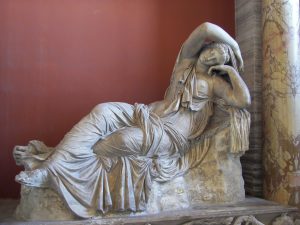 And/or: "A Latin inscription covering the entire width of the 'fireplace' can be read above the symbolic panels which were up to now the subject of our study. It is composed of 'three' words separated one from the other by two pyrogenic vases forming the following epigraph: Nascendo quotidie morimur { In being born, we die every day}….the unfortunate fate that life has in store for us....the walk to the sepulchre as the essential condition of the earthly sojourn, the coffin as the raison d'etre for the crib?....It is the only written word written the Mutus Liber....A simple examination of the inscription shows that of the three terms which contribute to form it, two are preceded by a special sign, the words quotidie and morimur. This sign, a little lozenge, was called by the Greeks Rombos {to be mistaken or go astray - to turn around}....Nascendo gives the idea of generation or production i.e., in order to generate.....The parents of the Hermetic child speak....The stone of the philosophers is born from the 'destruction' of the two bodies - the philosophers stone - or our 'mercury', its next matter - is also born from the fight....the essential operations of the art always has two principles producing a 'third' one {Son of?}, and that generation depends upon a preliminary decomposition of its agents. Further more philosophical 'mercury' itself, sole substance of the art can never yield anything unless it dies, ferments, and putrefies at the end of the first stage of the Work." [Pages 239/40 'The Dwellings of the Philosophers' / Fulcanelli].
And/or: "A Latin inscription covering the entire width of the 'fireplace' can be read above the symbolic panels which were up to now the subject of our study. It is composed of 'three' words separated one from the other by two pyrogenic vases forming the following epigraph: Nascendo quotidie morimur { In being born, we die every day}….the unfortunate fate that life has in store for us....the walk to the sepulchre as the essential condition of the earthly sojourn, the coffin as the raison d'etre for the crib?....It is the only written word written the Mutus Liber....A simple examination of the inscription shows that of the three terms which contribute to form it, two are preceded by a special sign, the words quotidie and morimur. This sign, a little lozenge, was called by the Greeks Rombos {to be mistaken or go astray - to turn around}....Nascendo gives the idea of generation or production i.e., in order to generate.....The parents of the Hermetic child speak....The stone of the philosophers is born from the 'destruction' of the two bodies - the philosophers stone - or our 'mercury', its next matter - is also born from the fight....the essential operations of the art always has two principles producing a 'third' one {Son of?}, and that generation depends upon a preliminary decomposition of its agents. Further more philosophical 'mercury' itself, sole substance of the art can never yield anything unless it dies, ferments, and putrefies at the end of the first stage of the Work." [Pages 239/40 'The Dwellings of the Philosophers' / Fulcanelli].
Side note: Mercury = moon/female/wet. Sulphur = sun/male/dry. All as a means....?

Oblique or erect?

Bird on the rump of a Celtic wolf.
Something extra to get into THAT mindset: "The ancient Egyptians distinguished the falcon from common predators and declared it ''noble'' in both flying and hunting. In its 'attack' it uses neither ruse {'trickster'?} or prudence. It rises very high through successive bursts in a straight climb without any wheeling {''skirts''?}, then hurls itself upon its prey in a sudden dive....it can attack its 'enemies' upside down....it head is flat and its beak curved...Its piercing glance is so powerful that it can stare at the sun..." [ Page 289, same book].
And/or: From the moment that instinct alone had no longer prepared the nuptial couch and an animistic sentiment, nobler and more elevated, had presided over the mysteries of Hymen, a sort of pact had been tacitly established between the young couple, from which it resulted that the stronger was pledged to protect the weaker and the weaker to remain attached to the stronger. This pact, in augmenting the welfare of the man, making him understand pleasure of which he was ignorant, increased also his labours. It was necessary that he should provide not alone for his own nourishment, but for that of his spouse, when her pregnancy had reached such an advanced stage that it did not permit her following him any more, and afterward for that of their children. Instinctive reason, another name for which is common sense or good sense, was not long in making him understand that the ordinary means, sufficient up to that time, were adequate no longer and that it was necessary to devise others. 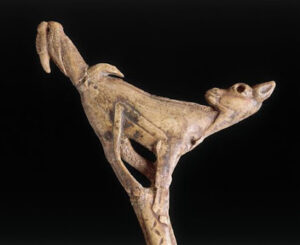
 This reason reacting upon instinct caused ruse to be born. He set traps for the game on which he lived. He invented the arrow and the boar-spear of the hunter; he discovered the art of catching more fish by means of hook and net. Necessity and practice doubled his forces and his skill. His wife, endowed with more finesse, added to a ruse greater than his, an observation more sure and a presentiment more prompt. She learned soon to set up rushes forming a kind of basket which, after having served as a cradle for her children, became the first article of furniture in her household. Spinning roughly the hair of many kinds of animals, she easily made cords, which were used to stretch the bow and to fashion nets. ‘These cords, interlaced in a certain manner, were soon changed under her fingers into coarse stuffs, and this invention appeared to her no doubt as admirable as the usage seemed to her convenient, as well for her children as for herself and her husband. These stuffs, which a rigid climate often rendered necessary, were supplanted by skins of beasts with which it was not always easy to provide themselves. {Hermetic Interpretation of the Origin of thge Social State of Man / F. d'Oliver}.
This reason reacting upon instinct caused ruse to be born. He set traps for the game on which he lived. He invented the arrow and the boar-spear of the hunter; he discovered the art of catching more fish by means of hook and net. Necessity and practice doubled his forces and his skill. His wife, endowed with more finesse, added to a ruse greater than his, an observation more sure and a presentiment more prompt. She learned soon to set up rushes forming a kind of basket which, after having served as a cradle for her children, became the first article of furniture in her household. Spinning roughly the hair of many kinds of animals, she easily made cords, which were used to stretch the bow and to fashion nets. ‘These cords, interlaced in a certain manner, were soon changed under her fingers into coarse stuffs, and this invention appeared to her no doubt as admirable as the usage seemed to her convenient, as well for her children as for herself and her husband. These stuffs, which a rigid climate often rendered necessary, were supplanted by skins of beasts with which it was not always easy to provide themselves. {Hermetic Interpretation of the Origin of thge Social State of Man / F. d'Oliver}.
Side note: "This evening Bhaduri expounded various philosophical points connected with the life of Mirabai, a medieval Rajputani princess who had abandoned her court life to seek the company of saints. One great sannyasi, Sanatana Goswami, refused to receive her because she was a woman; her reply brought him humbly to her feet. 'Tell the master,' She had said, 'that i did not know there was any Male in the universe save God; are we not all females before him?'
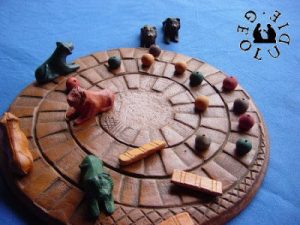
Head {inner} or tail {outer} = winner?
A working example {with something extra}: ''Lets look at the word 'Xeper'. We have seen its relationship with Thelema {'desire' i.e., in the wisdom sense of the word}, and how that Word generated the matrix {i.e., as one example - 'web'?} that produced Xeper {Cayce's Hall of Records'?}…..First encountered by E. A. Wallis....it allowed for a 'death' that had both power in the real world {'east'?} and potential for knowing the secrets of the cosmos in the next world {'west'?]….Very old in Egyptian religion....I was not the first to utter Xeper. According to mythology the first was Mehen-Pet-Tha - mentioned by 'Set' {'shadow'} in the 'The Book of Coming Forth by Night' {Duat?}. I had really looked for that name in writings about New Kingdom times: the board game of Horus and Set called Mehen was popular then.....'She who kindles celestial fire' - belonging to a 'princess' of the second dynasty - the son of Peribsen, the only pharaoh to call himself a ''Living Set'' rather than a 'Living Horus''....As a 'princess' he would have been a high priest..." [Page 168 'Overthrowing the Old Gods' / A. Crowley/Don Webb].
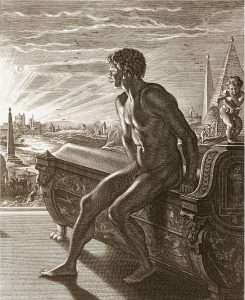
In Greek mythology, Memnon (/ˈmɛmnən/; Ancient Greek: Μέμνων means 'resolute'[1]) was a king of Aethiopia and son of Tithonus and Eos. As a warrior he was considered to be almost Achilles' equal in skill. During the Trojan War, he brought an army to Troy's defense and killed Antilochus, Nestor's son, during a fierce battle. Nestor challenged Memnon to a fight, but Memnon refused, being there was little honor in killing the aged man. Nestor then pleaded with Achilles to avenge his son's death. Despite warnings that soon after Memnon fell so too would Achilles, the two men fought. Memnon drew blood from Achilles, but Achilles drove his spear through Memnon's chest, sending the Aethiopian army running. The death of Memnon echoes that of Hector, another defender of Troy whom Achilles also killed out of revenge for a fallen comrade, Patroclus
And/or: ''The 'scarlet' woman is not merely a sex aid made flesh. 'She' or 'he' is the being who excites the sensuous and erotic force of evolution in you...." [Page 287].

A beginning or end?
Continued: ''Hatshepsut's second tomb was located at the foot of the cliffs in the eastern corner of the Valley of the Kings. The original intention seems to have been for a passage to be driven through the rock to locate the burial chamber under the sanctuary of the queen's temple on the other side of the cliffs. In the event, bad rock was struck and the tomb's plan takes a great U-turn back on itself to a burial chamber that contained two yellow quartzite sarcophagi, one inscribed for Tuthmosis I and the other for Hatshepsut as king. The queen's mummy has never been identified, although it has been suggested that a female mummy rediscovered in 1991 in KV 21 (the tomb of Hatshepsut's nurse) might have been her body.''
Yellow Sea / Red Sea ? What about 'Blue'? {'Green' language?}.
''Green'' = Lotus link? {i.e., vegetative}.
''The original star people were the Pawnee. Though some tribes held similar beliefs in later times. The Pawnee saw their ultimate home as being amongst the stars. The Pawnee used the stars as guides. From these ideas they began to build their dwellings in the shape of domes. Which was a reference to the sky. The placement of their dwellings were also aligned with stars in the sky. The centers of their dwellings were held up with poles that were marked white, yellow, red, and black as colours of the stars. White stood for Sirius, yellow for Capella, red for Antares, and black for Vega. These stars are the Four Direction Stars.''

Clearly the attainment spells the eclipse of the Dragon. Where light shines no darkness can there abide. For being the basis of the instinctual life, harnessed and chained to the needs and clearly perceived ideals of the psyche, the dragon shuns the sunbeams and the daylight. No longer do its projections and compulsive automatisms haunt the light of consciousness. No longer is the personality tortured as by some foul and evil presence. Its needs and dictates, once so imperious, cease their urgency, finding their proper place within the natural economy.
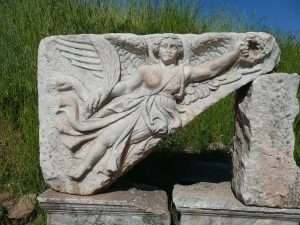
Goddess Nike.
REFRESHER: SEVEN. Is the Crown of Heaven, or the Seven Stars in the Sky. The term ‘Crown’ was usually the name for the First Sphere upon the Tree of Life, but the Crown of Shining Stars was more likely to be the Pleiades, a constellation often given mystical significance. The Goddess has a crown of seven stars which might also be the seven planets of the solar system, and the 7th Sphere is linked to Venus and Victory or Achievement. The Archangel of this Sphere is Auriel, who was said to wear a Crown bearing a precious stone that fell from Heaven, sometimes rumoured to be set in the Holy Grail. We are reminded here of the various meteoric sacred stones that are given religious significance, and of the heaven-sent metals which Miss Alford suggests inspired the sword dances mentioned above.
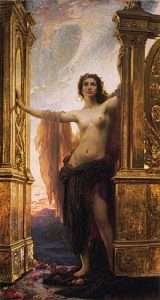
REFRESHER: "Dawn always begins in the bones." Goddess of Dawn. Gateway to the light.
The Seven Keys of Heaven of the Bristol variant, or ‘seven was the Gate of Heaven’ is usual terminology for the Seven Lower Spheres upon the Tree of Life, also represented as Seven Gates to be negotiated in one’s attempt to reach immortality. These are shown as the Druidic realms of the Other-world, which the heroes of the ‘Spoils of Annwm’ had to pass through in their search for the cauldron.
Boiled/Roasted.
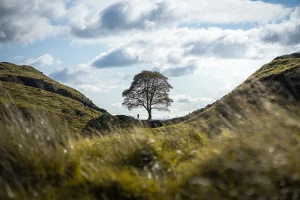
The Sycamore Gap Tree or “Robin Hood Tree” is a sycamore tree (Acer pseudoplatanus) standing next to Hadrian's Wall in Northumberland, England. The lake of Crag Lough and the village of Once Brewed are nearby, as is the Twice Brewed Pub, useful for trekkers at days end.
EIGHT. The Great Archangel, The Eight Archangels, The April Rainers, and Eight it is the Mornings’ break when all the world’s awake Oh. This last beautiful line of poetry gives us yet another surprising link out of apparent fancy which only makes sense within the cosmic interpretation of the song. The Eight Sphere, that of Glory, is linked to the Archangel Raphael. He is the Keeper of the Gates of Dawn, and his angels—the Bene Elohim—are the ‘inspirers’ who create new horizons within the intellect of mankind.
It has been suggested that eight Archangels pose a problem, but there are no less than Ten Archangels upon the Tree of Life. As Raphael is an Archangel bearing a Sword, we may be reading the common confusion between Raphael/Michael/Saint George. In representations of these figures their attributes are often exchanged. The Great Archangel is usually Michael, but the Archangel of the Eighth Sphere is properly Raphael, although the two have been juxtaposed in some Qabalistic writings. Many carvings of Michael show him with a Sword, which is incorrect, as he is traditionally the Spearor Lance-bearer. {'Where is Saint George' / B. Steward}.
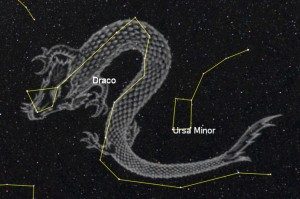
Guarding 'apple' trees?
From a different perspective: Something {purposely} hinted at: "Pliny the Elder, writing in the 1st century A.D. is perhaps the most notorious non-eye-witness of them all, relying on the testimony of others to speak of animals that even the original observers did not linger to describe too carefully. What Pliny and others have observed {or not actually witnessed} is similar to the half truths and observations that we make about all animals around us in the natural world. One of the reasons we believe animals behave in certain ways is due to our lack of patience or to the rationalist or fabulist's fall back which conveniently explains away why a thing is so. 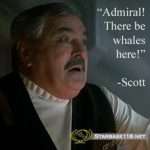 The real observer of the natural {key} world soon learns a better truth, although may still not always understand what is being witnessed. It is only recently, for example, that scientists have learned that whale-song is not just about communicating with other whales but about the practical ultrasonic mapping of coastlines and sea beds {and 'mounts'} by which whales steer their course. Yet, within our own lifetime, we have heard the most fabulist explanations of whale-song which have inspired composers...The sources of this book are varied. Where possible we have gone to the first tellers of tales as much as to the most recent accounts. Many of these early reporters lived at a time when only the known world was mapped. The 'uncharted' regions, as in many mariners maps of the sea, had {in one of its 'corners'} the image of the whale to indicate the presence of 'sea monsters'..." [From the book by J. and C. Mathews].
The real observer of the natural {key} world soon learns a better truth, although may still not always understand what is being witnessed. It is only recently, for example, that scientists have learned that whale-song is not just about communicating with other whales but about the practical ultrasonic mapping of coastlines and sea beds {and 'mounts'} by which whales steer their course. Yet, within our own lifetime, we have heard the most fabulist explanations of whale-song which have inspired composers...The sources of this book are varied. Where possible we have gone to the first tellers of tales as much as to the most recent accounts. Many of these early reporters lived at a time when only the known world was mapped. The 'uncharted' regions, as in many mariners maps of the sea, had {in one of its 'corners'} the image of the whale to indicate the presence of 'sea monsters'..." [From the book by J. and C. Mathews].
All those 'natural' qualities used as a means...?

'Back' of the head? or 'heart' of the dragon?
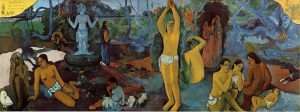
'Where Do We Come From? What Are We? Where Are We Going'? {Paul Gauguin}.
As an example: "Who am I? Where am I going? What is it all for? If these questions have been running through your head {'back of'?} lately, you have begun the ultimate quest, which in one form, is to answer questions such as these, and in another is perhaps the attainment of the Holy Grail. In many countries people ask these questions and instead of turning within - where the ultimate answers must surely lie - they turn to experts, psychoanalysts, and psychologists in the hope that other people can explain what they, the individuals , are about...It might seem daunting to have to look at and map your own feelings, but you can spend a few minutes each day thinking about how you feel....From your own secret journal you will begin to discover patterns of your own emerging. This is the beginning of the 'magical' journey of inner exploration. You are mapping an uncharted 'country' which you alone can visit totally. You can become your own expert and gradually, when you have learned to change your awareness from the immediate world to that inner one, you will be able to make long expeditions to gain new knowledge." ['Magic for the Aquarian Age' / Marian Green].
Question. How long is a 'whales' expedition and what 'patterns' do they make. Silent ones?
Remember - to understand a MINDSET. To define {internally?} what they all imply by that ''divine bit'' unlocks subject material REGARDLESS in what form it takes; whether 'ritual' {as in the above book}; or prayer ; or as a study program.

Found at Gobekli-tepe: Try ''fingers''.

Among other numbers - 'thirty' to enlarge. LONG body?
Side note: ''The statue of A'a from Rurutu is a wooden sculpture of the god A'a that was made on the Pacific island of Rurutu in the Austral archipelago....The figure is hollow, and has a removable back panel allowing access to the interior.[4] The sculpture's arms are carved in high relief; its legs are separated and slightly bent.[5] The figure has no feet or base, and it is unknown if it did when it was created....Thirty smaller figures are carved on the surface of the statue.[4] Many of these are positioned to mark features on the human body, such as the eyes, nose, and mouth, though some do not obviously correspond with any human feature.[7] The figures are carved in two distinct styles; sixteen of the figures are upright with arms over the torso, while fourteen lie spread-eagled, with arms and legs outstretched. Possibly these two distinct styles of figure are intended to represent male and female forms respectively.[8] These figures are symmetrically distributed across A'a, with the exception of those on the lower abdomen, where there is an upright figure on the right side of A'a and a splayed figure on the left. It is not clear whether this asymmetry was deliberate.''
''When A'a was brought to the LMS missionaries in 1821, 24 "small gods" were found inside its cavity.''
'Twentyfour'.
Question. Any flora within that 'hollow'?

The hand of Sabazios. Thumb = pinecone?

Mind set?
Side note: Thirty is a number connected with order and justice. In ancient Rome, a man had to reach the age of 30 to become a tribune, and according to biblical traditions, both Moses and
Jesus began their public preaching at that age. The Old Testament book of Judges ascribes to the judge Jair 30 sons who rode on 30 ass colts and had 30 cities (Judg. 10:4), while Samson promised the 30 friends at his feast that they would receive 30 robes and 30 festive garments if they could answer his riddle (Judg. 14:11-12). In the New Testament, meanwhile, Judas betrayed the lord Jesus for 30 pieces of silver.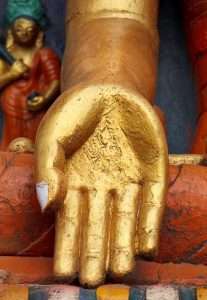 As a result some exegetes concluded that the value of any person, even a king, would be 29 dirhams or less, given that Christ's "price" was indeed not more than 30 pieces of silver. A delightful German ballad by Gottfried August Burger (d. 1794) relates this story.
As a result some exegetes concluded that the value of any person, even a king, would be 29 dirhams or less, given that Christ's "price" was indeed not more than 30 pieces of silver. A delightful German ballad by Gottfried August Burger (d. 1794) relates this story.
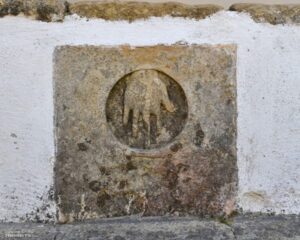
In the 'washing room' of the convent at Tomar- Portugal
Another form of exegesis was used by early medieval Christian theologians such as the Venerable Bede to explain why, in the parable of the Sower (Mt. 13: 8), the seed that fell on good soil brought forth grain "some a hundredfold, some sixty, some thirty." This was elucidated in terms of the old form of finger counting, in which the numbers 30 and 60 were expressed by certain figures made with the left hand, while 100 was a circle formed by the thumb and index finger of the right hand. 30 and sixty, belonging to the left hand, are still incomplete, but 100 is fulfilment and eternal life. ['The Mystery of Numbers'].
Sed Festival?
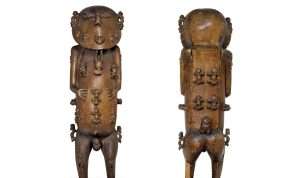
"Where no foot may tread." What does 'five' represent? {'Back' panel}. Odds/Evens to enlarge.
 ''Recent wood analysis has shown A’a was carved from sandalwood. As sandalwood is not endemic to Rurutu, it must have been traded in from a neighbouring island. The wood’s scent, which acts as an insect repellent, may have been factor in its selection....During the process of removing the wood samples, a small red feather was noticed, caught on a splinter inside the cavity. The feather was taken to the Natural History Museum, where it was identified as being from a Kuhl’s lorikeet (Vini kuhlii), now an endangered species {nectar/honey link}. Red feathers were among the most valuable and sacred materials in Polynesia, and were associated with the divine. This reveals that whatever was stored inside A’a’s hollow interior was of the highest value to islanders. Curators believe that the figure would have originally been made to hold the bones of an important ancestor; the small red feather may have been part of their wrappings....Contemporary Rurutuans explain that the exterior figures correspond to the kinship groups that make up their society, and propose a number of theories about the relationship between the figure and Christianity.''
''Recent wood analysis has shown A’a was carved from sandalwood. As sandalwood is not endemic to Rurutu, it must have been traded in from a neighbouring island. The wood’s scent, which acts as an insect repellent, may have been factor in its selection....During the process of removing the wood samples, a small red feather was noticed, caught on a splinter inside the cavity. The feather was taken to the Natural History Museum, where it was identified as being from a Kuhl’s lorikeet (Vini kuhlii), now an endangered species {nectar/honey link}. Red feathers were among the most valuable and sacred materials in Polynesia, and were associated with the divine. This reveals that whatever was stored inside A’a’s hollow interior was of the highest value to islanders. Curators believe that the figure would have originally been made to hold the bones of an important ancestor; the small red feather may have been part of their wrappings....Contemporary Rurutuans explain that the exterior figures correspond to the kinship groups that make up their society, and propose a number of theories about the relationship between the figure and Christianity.''
'Tower of the fish' to enlarge.
Sandalwood oil has a distinctive soft, warm, smooth, creamy, and milky precious-wood scent. Its quality and scent profile is greatly influenced by the age of the tree, location and the skill of the distiller. It imparts a long-lasting, woody base to perfumes from the oriental, woody, fougère, and chypre families, as well as a fixative to floral and citrus fragrances. When used in smaller proportions in a perfume, it acts as a fixative, enhancing the longevity of other, more volatile, materials in the composite. Sandalwoods are medium-sized hemiparasitic trees, and part of the same botanical family as European mistletoe. Sandalwood is indigenous to the tropical belt of the peninsular India, Malay Archipelago and northern Australia.[6][7] The main distribution is in the drier tropical regions of India and the Indonesian islands of Timor and Sumba.[8] It spread to other regions through the Incense trade route by the vast Indian and Arab mercantile networks and the Chinese maritime trade routes until the sixteenth century CE''
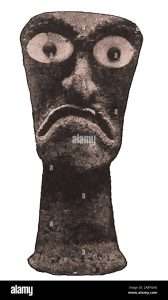
The Polynesian God of War {Kukailimoku}. Whats the remedy for mad, bad or sad?

Any feet? No firm footing? 'Cobblers' to enlarge.
And/or: if only in the micro sense of the word: {this readers opinion only?}: "The diamonds can be found even in the mud - the waters wash them clean. Nuggets of gold {philosophy} are not for you. Seek diamonds, sparkling truth, the clarity, perfection of the Word. The whirlpools of life carry you to where the diamonds are. Resonate to the perfection of the crystals. Arduous seeking is not necessary. The path is already mapped out. You have only to follow the clues." ['Truth Vibrations' by D. Icke. Includes parenthesis]. Try ''crystalliz{s}ation'' and/or ''nuggets''.
N.B. Before those first impressions reach for the ''off' switch {depending whether one is a fan of Mr Icke or not} get the overview of what such individuals do know, and do not know - relative to subject material. The above an example of information 'received' in one of his {clairvoyant?} episodes.
Side note: ''The Inca's referred to gold as the 'sweat of the sun'...'' ['Pawn Stars' / 2020].
''Sweat'' = moisture and salt.
Question. What can 'grow' from it?

A beginning or end? Among others 'Spots/Stripes' to enlarge.
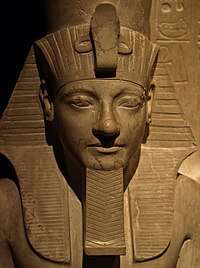
Stripes.
"Eureka" comes from the Ancient Greek word εὕρηκα heúrēka, meaning "I have found (it)", which is the first person singular perfect indicative active of the verb εὑρίσκω heurískō "I find".[1] It is closely related to heuristic, which refers to experience-based techniques for problem-solving, learning, and discovery.''
''Every dog has his day''. Try ''Herod'' for analogy on the same theme.
Extra: The Polynesian God of War - Kuka'ilimoku - also known as 'The Island Eater' or 'The Snatcher of Land' = No stable foundations? {i.e., 'chaos'}.
Sink or swim?
OR could one say 'float'?

 And/or: Saturn, as you know, is the binding, crystallizing vibration. The pair of opposites assigned to it is Dominion and Slavery, because our expression of this 'vibration' {i.e., in the ''energy'' sense of the word, i.e., recall J. Campbell's quote}, either frees or limits us, according to the point of view that we take. Limitation is the necessary condition of manifestation, because the only conceivable way that the Life-Power can enter into existence at all is by concentrating its activity at some definite point in space {'coal sacks'? 'Ostrich nest'?} - and that concentration is a self limitation. Boundaries of some kind are required for definiteness. Liberty does not consist in the removal of all conditions, in the absence of all restrictions. It is found in the understanding of the principle of limitation, and the application of that principle to the production of specific results. " [Page 51 of the book by P. F. Case. Vol 1].
And/or: Saturn, as you know, is the binding, crystallizing vibration. The pair of opposites assigned to it is Dominion and Slavery, because our expression of this 'vibration' {i.e., in the ''energy'' sense of the word, i.e., recall J. Campbell's quote}, either frees or limits us, according to the point of view that we take. Limitation is the necessary condition of manifestation, because the only conceivable way that the Life-Power can enter into existence at all is by concentrating its activity at some definite point in space {'coal sacks'? 'Ostrich nest'?} - and that concentration is a self limitation. Boundaries of some kind are required for definiteness. Liberty does not consist in the removal of all conditions, in the absence of all restrictions. It is found in the understanding of the principle of limitation, and the application of that principle to the production of specific results. " [Page 51 of the book by P. F. Case. Vol 1].
Boundaries?
Question. How would that be represented? The 'white' walls at Saqqara? {as one example}.
Continued: Those same 'sea monsters' that such characters as Apollo have to 'wrestle' with before an understanding {development?} takes place. Represented as a 'new location'. Enlarged elsewhere.

Semi-circle?
And/or: "The Greeks equated Set with the image of Typhon, The Destroyer. All of the Typhonic figures - the spotted leopard, oryx, ass, pig, boar, serpent, crocodile, turtle and in a feminine aspect {claws?}, Selqit {selket?} the scorpion - have a relationship to Set in his role as 'devourer' or divider. He represents the purely physical unindividuated rhythm of nature. These images all portray the unconscious, repetitious motion of material life, which swallows, absorbs, and elevates physical survival above all else. Thus Set, fulfills the 'Principle of Fixation', which, when allowed to proliferate in the physical world, functions as corruption." ['Sacred Tradition of Ancient Egypt']. Higher/lower?
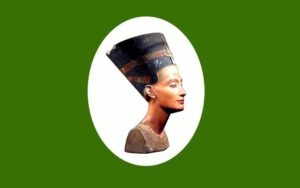
Flag of Minya.
The term "oryx" comes from the Greek word ὄρυξ, óryx, for a type of antelope. The Greek plural form is óryges, although "oryxes" has been established in English. Herodotus mentions a type of gazelle in Libya called ὄρυς, orus, probably related to the verb ὀρύσσω, orussō, or ὀρύττω, oruttō,[4] meaning "to dig". White oryxes are known to dig holes in the sand.
N.B. The Oryx making a comeback {from extinction} in Arabia.
The Oryx nome (Ancient Egyptian: 𓉇 Ma-hedj) was one of the 42 nomoi (administrative divisions, Egyptian: sepat) in ancient Egypt. The Oryx nome was the 16th nome of Upper Egypt,[1] and was named after the scimitar oryx (a type of antelope). It was located, approximately, in the territories surrounding the modern city of Minya in Middle Egypt......The city's Arabic name comes from the Coptic, rendered in as ⲧⲙⲱⲛⲏ in Bohairic and ⲧⲙⲟⲟⲛⲉ in Sahidic, which in turn came from Ancient Greek: μονή, lit. 'stopping-place, station, monastery'.[4]
![]()
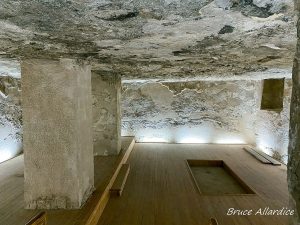
The original tomb burial chamber of Akhenaten at Amarna.
The modern city of Minya is often identified with the Ancient Egyptian settlement of Men'at Khufu based on the resemblance of two names, although this claim, proposed by Gauthier and Drew-Bear, is denied by modern Egyptology as the former has a clear Greek etymology.[4]
Minya is dubbed by the locals "Bride of Upper Egypt", in reference to its strategic location in Middle Egypt as a vital link between the north and the south of Egypt.
And/or: The scimitar oryx (Oryx dammah), also known as the scimitar-horned oryx and the Sahara oryx, is an Oryx species that was once widespread across North Africa and parts of West Africa and Central Africa.
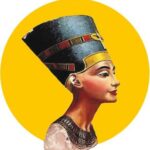
Flag of Minya Govenorate. Right eye = 'in profile'?
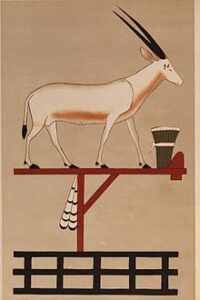
Horizon?
In 2000, it was declared extinct in the wild on the IUCN Red List, but in 2023 it was downlisted to endangered, with a reintroduced population in Chad.[1] This particular oryx is adapted to harsh desert conditions and can survive for months or even years without drinking water. A grazing animal, it derives most of its daily moisture intake from plants.
Amenemhat, often reported with his short form Ameny (Jmnjj), was an ancient Egyptian "Overlord of the Oryx nome" (the 16th nome of Upper Egypt) and chief priest during the reign of pharaoh Senusret I of the 12th Dynasty (20th century BCE).
Sixteen?
N.B. The 16th president of U.S.A was Abraham Lincoln.
Amenemhat I (Ancient Egyptian: Ỉmn-m-ḥꜣt meaning 'Amun is at the forefront'), also known as Amenemhet I, was a pharaoh of ancient Egypt and the first king of the Twelfth Dynasty of the Middle Kingdom.
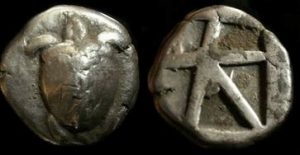
Question. Convex or concave? {embossed/debossed?}. What represents 'five' ?
Side note: The first coinage ever - came from a small island in the Aegean Sea. The Silver Stater. In the form of a turtle {made of 'electrum' - ''green gold''}. Years later the form changed from turtle into a tortoise . From a 'sea' animal into a 'land' one. Wet and Dry. No one really knows why. That external shell that hides something internal. Like the shell of an egg or seed. To get closer to the truth and/or mind set add this subject to those possibilities. ['Pawn Stars' / History channel].
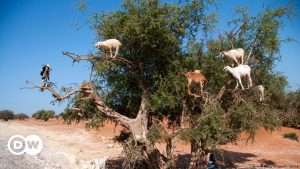
Tree of knowledge?
''In ancient times the Greeks called large waves 'aig(y)es' (as jumping goats). Thus we arrive at “Aegeon” = Aegean. In modern day Greek it is called 'Aig(y)aio'
Try ''carapace'' and/or 'green lion' .
''Although Moana is from the fictional island Motunui some 3,000 years ago, the story and culture of Moana is based on the very real heritage and history of Polynesian islands such as Hawaii, Samoa, Tonga, and Tahiti.'' i.e., a turtle begins the story. Begins the facination of water.
''Electrum is a naturally occurring alloy of gold and silver, with trace amounts of copper and other metals. The ancient Greeks called it "gold" or "white gold", as opposed to "refined gold". Its colour ranges from pale to bright yellow, depending on the proportions of gold and silver. It has been produced artificially, and is also known as "green gold". [Wiki].

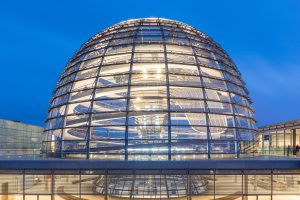
The Reichstag glass dome....With Spiral walkway inside the glass dome....to symbolize the reunification of Germany.
#Some say the Capstone of the Gt. Pyramid was made of same.
Nature moves not by the theory of men but by their practice, and surely wit and reason can perform no miracles unless the hands supply them. Be sure then to know this fire in the first place, and accordingly be sure to make use of it. But for thy better security I will describe it to thee once more. It is a dry, vaporous, humid fire; it goes round about the glass and is both equal and continual. It is restless, and some have called it the white philosophical coal. It is in itself natural, but the preparation of it is artificial. It is a heat of the dead, wherefore some call it their unnatural, necromantic fire. It is no part of the matter, neither is it taken out of it; but it is an external fire and serves only to stir up and strengthen the inward oppressed fire of the chaos. But let us hear Nature herself, for thus she speaks in the serious romance of Mehung....
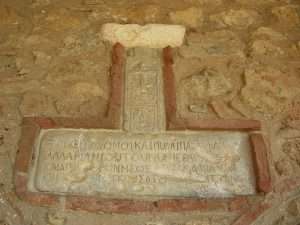
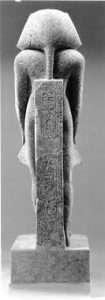 “Behind will stands desire.” So runs an alchemical aphorism. This can be assumed to imply that desire directs will, and gives to it an object to achieve. Or else it may imply that the basis or background of the Will is desire or emotion, and that the former has grown out of the latter, as an evolution or sublimation, even as consciousness depends upon the Unconscious. The motive power of the instinctual life is the libido, desire, the vital spirit, while the motive power of the intellectual life is the Will. In its developments and peregrinations, in its eclipse by the magnetic trance state, the will loses its former sense of direction. But having almost reached the verge of annihilation, so to speak, reaching the nadir of its life, it restores itself by an effort which is mighty beyond words. One step towards this divine restoration is the fierceness of its fire and heat, as though desperation towards life urged forth every ounce of inherent vitality. At this stage, when it associates itself with and is given life by desire, the emotional nature, it is often called the Vitriol of Venus or the Green Lion {'Tefnut'?}, both implying the volitional power of penetration, fiery and crude, of immature but evolving spiritual energy....
“Behind will stands desire.” So runs an alchemical aphorism. This can be assumed to imply that desire directs will, and gives to it an object to achieve. Or else it may imply that the basis or background of the Will is desire or emotion, and that the former has grown out of the latter, as an evolution or sublimation, even as consciousness depends upon the Unconscious. The motive power of the instinctual life is the libido, desire, the vital spirit, while the motive power of the intellectual life is the Will. In its developments and peregrinations, in its eclipse by the magnetic trance state, the will loses its former sense of direction. But having almost reached the verge of annihilation, so to speak, reaching the nadir of its life, it restores itself by an effort which is mighty beyond words. One step towards this divine restoration is the fierceness of its fire and heat, as though desperation towards life urged forth every ounce of inherent vitality. At this stage, when it associates itself with and is given life by desire, the emotional nature, it is often called the Vitriol of Venus or the Green Lion {'Tefnut'?}, both implying the volitional power of penetration, fiery and crude, of immature but evolving spiritual energy....
'First Conscious Shock'?
Side note: 'The Restoration Stela of Tutankhamun'.
Continued: Our text says of the fire that “it is in itself natural, but the preparation of it is artificial”. This we have already understood from our perusal of the former texts. And Vaughan goes on to remark that “it is not part of the matter, neither is it taken out of it, but it is an external fire and serves only to stir up and strengthen the inward oppressed fire of the Chaos”. Here we are back once more on familiar ground. In occultism there can be no initiation - that is “ the commencement of a new interior life - in a candidate or aspirant without an initiator. This process has been somewhat described in the magical section of Chapter Eight. ['The Philosophers Stone'].


In North Germany Alkor, as there written, has been der Hinde, the Hind, or Farm Hand; in Lower Germany, Dumke; and in Holstein, Hans Bumken, Hans the Thumbkin, — the legend being that Hans, a wagoner, having given the Saviour a lift when weary, was offered the kingdom of heaven for a reward ; but as he said that he would rather drive from east to west through all eternity, his wish was granted, and here he sits on the highest of the horses of his heavenly team. A variant version placed Hans here for neglect in the service of his master Christ ; and the Hungarians call the star Oontzol, with a somewhat similar tale. Another Teutonic ston was that their giant Orwandil, our Orion, having frozen one of his big toes, the god Thor broke it off and threw it at the middle horse of the Wagon. where it still remains.
Side note: While the Borean Race was becoming civilized, and while it was increasing in numbers from year to year and spreading over greater extent of territory, the centuries rolled on in silence. All inventions were being perfected, and one could observe already among the different tribes of which the entire race was composed some beginnings of pastoral and agricultural life. Canoes had been hollowed out to traverse the arms of the sea and to navigate rivers, and wagons had been made to penetrate more easily into the interior of the country. When the pastures were exhausted in one country they passed into another. ‘The earth, which never failed the inhabitants, sufficed for their needs. The deep forests abounded in game, the seas, the rivers offered inexhaustible and easy fishing. {Hermetic Interpretation of the Origin of the Social State of Man / F. d' Olivet}.
'Bear' to enlarge.
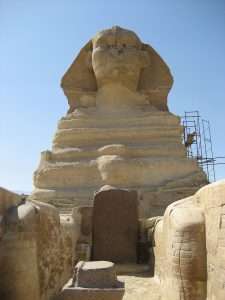
'Father' of terror with Dream Stela. Anything?
Continued: ''Should we therefore decide to meet the demands of this 'higher being of light' {guardian of the gate?}, we will be able to contribute to the liberating of the human race. We will then offer up our 'gifts' and talents on the sacrificial altar of humanity. But if we prefer our own premature ascent....'' [Page 204 'How to Know Higher Worlds' / R. Steiner].
Copper Scrolls?
Our text says of the fire that “it is in itself natural, but the preparation of it is artificial”. This we have already understood from our perusal of the former texts. And Vaughan goes on to remark that “it is not part of the matter, neither is it taken out of it, but it is an external fire and serves only to stir up and strengthen the inward oppressed fire of the Chaos”. Here we are back once more on familiar ground. In occultism there can be no initiation - that is “ the commencement of a new interior life - in a candidate or aspirant without an initiator. This process has been somewhat described in the magical section of Chapter Eight. In the mesmeric art it is the magnetism projected upon the patient by the magnetizer which enables the former to pass regressively, as Mrs. Atwood suggests, through the many phases of his historical and evolutionary development back to his long-forgotten life in Reality....
The medium (that is the astro-mental sheath) in its natural state is volatile, immanifest, fantastic, irrational and impotent, compared with what it subsequently is able and by artificial conception suffers itself to become. The Alchemists, we repeat therefore, did not remain satisfied with a few passes of the hand or any first phenomena whatever, but they proceeded at once scientifically to purify, depriving the ether of its wild affections and impressures by a dissolution of the circulating body in its own blood. For this is the brazen Wall celebrated by Antiquity. Take the occult Nature, which is our Brass, says Albertus, and wash it that it may be pure and clean. ['The Philosophers Stone' / I. Regardie].

Spirit or soul?
Continued: "Among the great initiate wisdom which has proceeded from China is the literature attached to the 'Book of Change', the I Ching...Among the basic sixtyfour archetypal figures {images?} or hexagrams, is one which deals with inner truth. The Chinese character {image?} which denotes 'truth' is an archaic picture of a bird resting its protective claws on the head of a newly hatched 'young'. The ancient sages pictured truth as a delicate thing, egg born, and in perpetual need of protection. "
Broken/UNbroken as a means....?
And/or: ''Esoteric or {mind set} - calls the important stage of development, wherein we become conscious in sleep, ''continuity {or unbrokenness} of consciousness''. For a person who has reached this stage of development, perception and experience are no longer interupted by those periods when the body rests and the soul no longer recieves impressions from the senses - consciousness is UNBROKEN.'' [Page 171 'How to Know Higher Worlds' / R. Steiner].

A beginning or ending?
REFRESHER: "It is interesting that we define 'swt' by the form of an egg and 'sah' by the seal that fastens an envelope. Our ancient texts often speak of the dead man who must ''break his egg''. It happens in such texts that 'swh' is given by the sign for a 'city' {nwt}: it isn't a question of a city but of the dead man's own nwt, his egg, his surviving envelope {'boundary'. Personal one?}. A man's nwt is like the celestial Nut whose physical organs are the constellations of the zodiac. Their functions differ, in man's body as in 'hers' {animus?}, but their influences interpenetrate, though they can only communicate with essentially identical states, and through an intermediary {phoenix? or 'Thoth' i.e., ''wisdom''}. The 'heart' is in sympathy with the intermediary and plays the same part in man's body as the sun does in the universe....Hathor who holds earth, heaven and the Duat in contemplation....Hathor, house of divine Horus, of ''your Neter that is in your egg''. Make her eyes yours that you may see the celestial luminaries....It was wise, when you framed your question, to associate the idea of various regions with that of different states of being in the Duat: you cant separate them. Just as a city {nwt} is an assemblage of ''atmospheres'' emanating from heaven and from men, which give the 'city' its character, so also a mans nwt is a complex of influences and impressions that sum up the states of successive personalities..." [Pages 212-214 'Her-Bak']. All as a means...?
Refresher: ''An 'envelope' is the name given to a membrane which forms the outer layer of certain viruses.'' ['The Chase'].
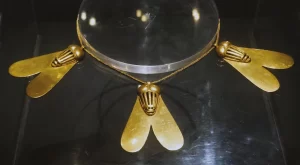
Golden flies.
And/or: Let us look for a moment at this Hydrogen 96, which appears here under the sign or at the note of Fa. Fa 96 is called “Animal Magnetism” for want of a better term. If we call it simply vitality or healthy we may not be using quite the right term for it. But it is connected with vitality or health and yet it is not quite the same. Physical vitality or health depends as much on proper amounts of Hydrogen 384 and 192. The term “Animal Magnetism” means something “animal” and so in a way something “physical”, some sort of vitality or health: the term “magnetism” denotes that it is at a higher level. A man may not enjoy very good physical health, in the ordinary sense, and yet possess the resiliency and strength that comes from having Fa 96. A person, indeed, may be ill physically and yet possess sufficient quantities of the substance called Fa 96 to make him transcend illness, and on the other hand he may be well physically and possess insufficient quantities of Fa 96 and have little power of making others feel better.
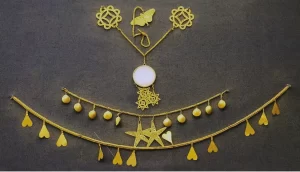

''The Birth of the New Man.'' 'Egg/Incarnation' to enlarge
Long ago someone asked G. what Fa 96 signified: the answer was that if you had sufficient quantities of this Hydrogen “fleas would not bite you.” Of course, naturally, some people who heard this answer were shocked and considered it irrelevant and crude. But the idea is exactly expressed in this answer. Fa 96 is something that protects us, as it were, like an “envelope” surrounding us. Now let us look at its position. As was Said, it is manufactured in the second storey. As you know, in the diagram of the centres in Man, the emotional centre comes in the second storey. It dominates it. Therefore the formation of Fa 96 is interfered with if the emotional state is wrong. {'Psychological Commentaries on the Teaching of Gurdjieff and Ouspensky' / M. Nicoll}.
Side note: Know, my son, that in the hen’s egg is the greatest proximity and relationship in nature; for in it there is a spirituality and conjunction of elements, and an earth which is golden in its tincture....For the work begins from the vegetable, next from the animal, as in the egg of the hen, in which is the great support; and our earth is gold, of all which we make seriacum, which is the ferment Ixir.....The egg of the philosophers refers to the aura, the ovoid emanation exuding from and surrounding the astro-mental form. It is this shape which is the subject of the work. When brought to fulfilment, it glows and scintillates most brilliantly like some more than precious gem. ['The Philosophers Stone'].
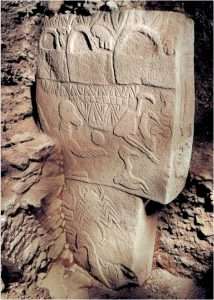
Egg? ''Truth'' found within it?

Inner/outer. A beginning or end?
Continued: "Interestingly, Libra was not included in the earliest zodiacs. It is believed to have been known to the Egyptians as Zugon - the 'Yoke'{enlarged elsewhere} - where only the beam of the scales was represented, typifying the Nilometer, the instrument by which the inundations of the Nile were measured. According to some Arkadian writings, the name of the 7th month was Tulku meaning Holy Altar...Libra is the only sign that is represented with something inanimate..." ['Birthstones.Me'].
Question. Libra {'claws'} link to ''scratch'' / ''7th'' / ''balance'' / altar / 180 degrees etc., All as a means...?
And/or: ''Libra is the sign of initiation'' AND ''Janus is the god of initiation.'' Enlarged elsewhere.
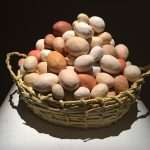
'64' ?
Side note: "The word 'conscience' {''con-science''} contains the idea of balance, for it implies "simultaneous knowing," i.e.,knowledge of the facts of the two scales suspended at the extremities of the beam of the balance. Conscience is neither a product nor a function of character. It is above it. And it is here - and only here - that there begins and there is found the domain of freedom." [Letter viii 'Justice' from the book 'Meditations on the Tarot'].
Understanding such 'information' {as one example} gets us closer in deciphering Homers 'secret' Illiad - therefore subject material {mind set?} - as a whole.

Linear A

''The Phaistos Disc (also spelled Phaistos Disk, Phaestos Disc) is a disk of fired clay from the Minoan palace of Phaistos on the island of Crete.''
And/or: "The circle is an image of pure 'spirit'...The crescent {semi-circle} that for the 'soul'...The vertical line that for the 'mind' and the horizontal line that for the 'body'. When the mind and body are combined, they form the 'cross of matter'. [Page 6 'Mapping the Psyche']. Try ''semi-circle'' for a connection.
Linear A/B ?

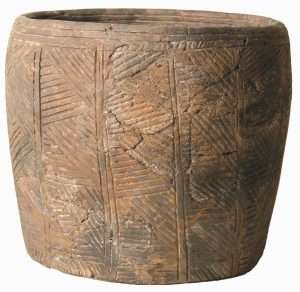
Whats the common form that is inscribed? 'Pyr'amid and Nasca Lines to enlarge. 'Rounded' = circle. Internal/External = water/fire. 'SEE' it?
Continued: Brochs {'towers'} found only along the coast as opposed to say temples - along a river. At least 'thirty feet' in height {''giant' of a building''}. Top/down in relation to bottom/up? Glastonbury Tor {'tower'} a link to 'Broch' by way of ''Burh''. Opened 'top' as opposed to closed. St. Michael associated with it - therefore 'sun' rather than 'moon'. Of 'pagan' origins therefore early A.D. Northeast in relation to Southwest. The tail end of something begins the process {and/or development?} of...?
Or more importantly - ALL AS A MEANS...?
''Grooved ware is the name given to a pottery style of the British Neolithic. Its manufacturers are sometimes known as the Grooved ware people. Unlike the later Beaker ware, Grooved culture was not an import from the continent but seems to have developed in Orkney, early in the 3rd millennium BC, and was soon adopted in Britain and Ireland.[1]
Refresher: ''There is some copper on Rousay which could have been easily accessed, through the tin required to make this alloy - from Cornwall - hinting at a very long commercial connection.'' [Page 24 'Current Archaeology' / March 2023].
Glastonbury?
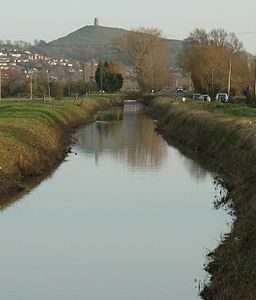
Isle of 'glass'.
 Side note: {Exercise?}: "What would have made such a sighting easier, in antiquity, would have been a tall tower annexed to the temple that once stood here - a temple dedicated to Su-En {usually contracted to Sin}, the Moon god of the Sabians. After telling us that there were 'powerful images in this temple', the Greek philosopher Libanius {AD314-394}, describes the tower, noting that: 'from its top one could overlook the entire plain of Harran'....'' And/or "I went off and sat down at the waters {fresh?} of Dan, to the south of the west of Hermon...I fell asleep and behold a dream came to me..." [Page 335/342 'The Magicians of the Gods'].
Side note: {Exercise?}: "What would have made such a sighting easier, in antiquity, would have been a tall tower annexed to the temple that once stood here - a temple dedicated to Su-En {usually contracted to Sin}, the Moon god of the Sabians. After telling us that there were 'powerful images in this temple', the Greek philosopher Libanius {AD314-394}, describes the tower, noting that: 'from its top one could overlook the entire plain of Harran'....'' And/or "I went off and sat down at the waters {fresh?} of Dan, to the south of the west of Hermon...I fell asleep and behold a dream came to me..." [Page 335/342 'The Magicians of the Gods'].
''Overlook''?
 A work in progress: ''The Jewish Talmud, a 4th century AD source, referred to Magdala as Migdal-Nunya, meaning ''tower of fish''....This is one explanation for the origin of the town's name, Migdal, meaning tower.....'The lake supplies fish for pickling, and on its banks grow fruit bearing trees resembling apple trees' {Strabo}.... The harbor, most likely in use up until 67AD....Archaeologists believe that shortly after the conquest, flooding covered the northern side of Magdala, burying thus preserving it for 2000 years.'' [Pages 16/25/30 'Mary Magdalene: Insights From Ancient Magdala' / J. Ristine].
A work in progress: ''The Jewish Talmud, a 4th century AD source, referred to Magdala as Migdal-Nunya, meaning ''tower of fish''....This is one explanation for the origin of the town's name, Migdal, meaning tower.....'The lake supplies fish for pickling, and on its banks grow fruit bearing trees resembling apple trees' {Strabo}.... The harbor, most likely in use up until 67AD....Archaeologists believe that shortly after the conquest, flooding covered the northern side of Magdala, burying thus preserving it for 2000 years.'' [Pages 16/25/30 'Mary Magdalene: Insights From Ancient Magdala' / J. Ristine].
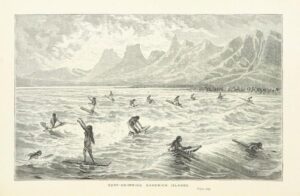 And/or: Hawaiians are credited for having invented surfing or he‘e nalu. The length of the surfboard, as well as the type of wood the surfboard was made of, differentiated the royalty from the commoners. Ali‘i (royalty) surfboards, called olo, were 14–16 feet long, and were made from wiliwili trees. The makaainanas' (commoners') boards, called alaia, were only 10–12 feet long, and were made from denser koa wood. Although olo were less dense, they still could weigh up to 175 pounds. If a commoner dropped in on a wave that an ali‘i wanted to ride, or rode a wave that an ali‘i was catching, those violations warranted the death penalty....
And/or: Hawaiians are credited for having invented surfing or he‘e nalu. The length of the surfboard, as well as the type of wood the surfboard was made of, differentiated the royalty from the commoners. Ali‘i (royalty) surfboards, called olo, were 14–16 feet long, and were made from wiliwili trees. The makaainanas' (commoners') boards, called alaia, were only 10–12 feet long, and were made from denser koa wood. Although olo were less dense, they still could weigh up to 175 pounds. If a commoner dropped in on a wave that an ali‘i wanted to ride, or rode a wave that an ali‘i was catching, those violations warranted the death penalty....
The creation of a surfboard was also sacred. Before chopping down a tree, a surfboard maker would place a kūmū, or ritualistic fish, in a hole near the roots of the tree and pray. After the tree was cut down and hauled away, it would be roughly shaped using bone or adze.
'Swell' to enlarge.
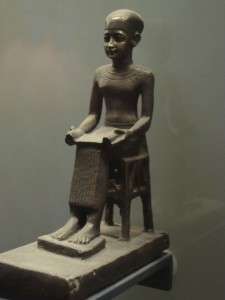
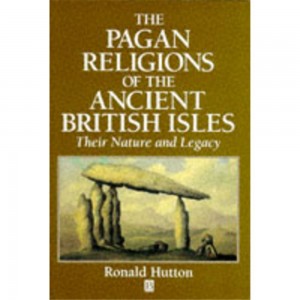 Continued: At least I had found confirmation of something I had long believed: The Holy Grail, the sangreal, in old French, could just as easily designate “royal blood” (sang royal) or royal lineage as it could a cup, chalice, or platter that-— if we subscribe to the version of the story popularized first by the Clunisians, then by the Cistercians — contained the blood of Christ. But supporting the theory of legitimate descendants of the “hairy kings,” meaning the Merovingians, and their debatable origin (Jesus and Mary Magdalene), was out of the question for me, even from a heuristic perspective, though the possibility was worth raising. This was during the time before Scorsese’s film The Last Temptation of Christ had unleashed such outrage and controversy, yet the book by Kazantzakis on which the film was based had been around for some time without unleashing such debate.
Continued: At least I had found confirmation of something I had long believed: The Holy Grail, the sangreal, in old French, could just as easily designate “royal blood” (sang royal) or royal lineage as it could a cup, chalice, or platter that-— if we subscribe to the version of the story popularized first by the Clunisians, then by the Cistercians — contained the blood of Christ. But supporting the theory of legitimate descendants of the “hairy kings,” meaning the Merovingians, and their debatable origin (Jesus and Mary Magdalene), was out of the question for me, even from a heuristic perspective, though the possibility was worth raising. This was during the time before Scorsese’s film The Last Temptation of Christ had unleashed such outrage and controversy, yet the book by Kazantzakis on which the film was based had been around for some time without unleashing such debate. 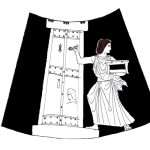 Let us not forget that the church of Rennes-le-Chateau is dedicated to Mary Magdalene and that she is oddly and abundantly depicted in the interior of this sanctuary. This reflects the will of Father Sauniere, also the builder of the Magdala Tower in which he wished to house his library. Strange, no? The reading of Holy Blood, Holy Grail forced me to ask myself many obviously unanswerable questions. It also compelled me to reread Le Tresor du triangle d’or by Jean-Luc Chaumeil, who in this instance turned out to be my “introducing brother” to a strange “closed white assembly,” where I was the sole noninitiate.....
Let us not forget that the church of Rennes-le-Chateau is dedicated to Mary Magdalene and that she is oddly and abundantly depicted in the interior of this sanctuary. This reflects the will of Father Sauniere, also the builder of the Magdala Tower in which he wished to house his library. Strange, no? The reading of Holy Blood, Holy Grail forced me to ask myself many obviously unanswerable questions. It also compelled me to reread Le Tresor du triangle d’or by Jean-Luc Chaumeil, who in this instance turned out to be my “introducing brother” to a strange “closed white assembly,” where I was the sole noninitiate.....
 An imposing mass of a castle and the more discreet steeple of a church from which, extending westward, a bizarre construction in the shape of a tower seemed to defy the abyss below. This was Rennes-le-Chateau, a village, like so many others, built from stone and Roman tile roofs and made up of empty streets that seemed to suggest that no one had ever dared to live there. ['The Church of Mary Magdalene' ].
An imposing mass of a castle and the more discreet steeple of a church from which, extending westward, a bizarre construction in the shape of a tower seemed to defy the abyss below. This was Rennes-le-Chateau, a village, like so many others, built from stone and Roman tile roofs and made up of empty streets that seemed to suggest that no one had ever dared to live there. ['The Church of Mary Magdalene' ].
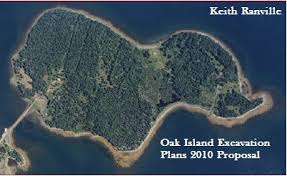
Isaac's point?
And/or: {something hinted at}: " After the stress and shock of the sudden awakening to the fundamental error of separateness - after the lightening flash of true knowledge has toppled the crown off the Tower of Common Sense - as shown in the 16th Major Trump, there comes a period of calm and gradual growth. In the second stage which we considered in the previous lesson, there is a sudden and painful overthrow of the 'false' wisdom of the world, a momentary, but never-to-be-forgotten glimpse of reality, of the absolute unity of life. In the 'third' stage this new conception of the Oneness of all, begins gradually to unfold. What happens to this unfoldment, and the specific activities involved therein, we may discover from the study of the 17th key of the Tarot....This picture develops the esoteric meaning of the Hebrew letter Tzaddi, named the ''fish hook''....That which pulls the 'fish' {Nun, i.e.,14th letter} OUT of Water {Mem, i.e., 13th letter}….''To hook'' is to draw, to entice, to procure....Has a particular application to the Christian aspects to the Ageless Wisdom, i.e., Jesus chose fishermen for disciples, and promised them that they should become 'fishers of men'...." [Pages 96/159 of the book by P. F. Case. Vol 1]. Try ''153''.
INTERNAL process of an understanding of something? REGARDLESS of subject?
''Unity'' in relation to ''lower/upper'' and/or ''higher'' and the word ''Yoga'' ? ALL as a means....?
Refresher: ''Crochet in French means 'little hook'....''

The Tor is in the middle of the Summerland Meadows, part of the Somerset levels. The plain is reclaimed fen above which the Tor is clearly visible...It has been described as an island but actually sits at the western end of a peninsula washed on three sides by the RIVER Brue." [Wiki/river Brue]. River in relation to 'Sea'.

The Reichstag dome is a glass dome constructed on top of the rebuilt Reichstag building in Berlin, Germany. It was designed by architect Norman Foster, from an idea of Gottfried Böhm, and built by Waagner-Biro to symbolize the reunification of Germany. The distinctive appearance of the dome has made it a prominent landmark in the city.
Continued: "Tor is an English word referring to to a high rock or a hill, deriving from the old English 'torr'. The Celtic name for Tor was Ynys Wydryn, or sometimes Yhys Gutrin, meaning ''Isle of Glass''. At this time the plain was flooded, the Isle became a peninsula at low tide." [Wiki/ Glastonbury Tor].
From a different perspective: ''I watch Bradley tensing his muscles, quickly descending the creaking stairs, half expecting to hear his steps echoed by those of the 'Vicar'. He glances behind him, once, twice, and - there! At the far end of the cellar, sitting in its own red glow, the rotund glass vessel pulses - like a living thing, he said. Like the Sacred Heart.'' [Final page of the book 'Mercurius' / P. Harpur].
"The conical hill of clay and Blue Lias rises from the Somerset levels. It was formed when surrounding softer deposits were eroded, leaving the hard cap of sandstone exposed. The slopes of the hill are terraced, the method of which they were formed remains unexplained..."
A {working?} example: "It has long been wondered why Homer describes Nestor's homeland in the Peloponnese as 'sandy Pylos' {S/W}, for the remains of the so called palace of Nestor lie a little inland on top of a rock hill..." ['Homer's Secret Iliad'].
''Oil of Sand''? Enlarged elsewhere.
Refresher {as one example}: "There is a mosque whose foundation was laid from the first day on piety; it is more worthy of thy standing forth therein. Which then is best? - he that layeth his foundation on piety to God and his good pleasure? - or he that layeth his foundation on an undermined sand cliff ready to crumble to pieces?" [Quran 9:108/109].
Side note: From a different perspective: "Primary chief bard am I to Elphin. And my original country is the region of the summer stars {i.e., the West}. Idno and Heinin called me Merddin. At length every king will call me Taliesin."
The above in relation to the question that King Maelgwyn's asks of a character {created?} of someone called ''Little Gwion'' as to ''who he was and whence he came''. Who the author R. Graves attempts to solve throughout the course of his book. [Page 81 'The White Goddess'].
Try ''Ishon'' to BEGIN with.
And/or: Little Brothers of the Apostles? {'The Serpent Circle' / P. Harpur}.

Illuminated?
 And/or {i.e., something hinted at using 'food' as a guide}: ''At 'eight' o'clock you get down and dirty, stomping in the 'red' earth of the Southwest. A little corn cake, about the size of a silver dollar {moon link}, and a 'green' smear of guacamole....This is goddess food, Corn Mother food....Dip it in salsa and, and your 'crown chakra' blows open. You are illuminated in more ways than one.....this dark food that brings you to light....This maize food brings imagery of being chased through the labyrinth by the fabled minotaur, perhaps, but when you turn around you find it is yourself.'' [Page 286 'A Mythic Life' / J. Houston].
And/or {i.e., something hinted at using 'food' as a guide}: ''At 'eight' o'clock you get down and dirty, stomping in the 'red' earth of the Southwest. A little corn cake, about the size of a silver dollar {moon link}, and a 'green' smear of guacamole....This is goddess food, Corn Mother food....Dip it in salsa and, and your 'crown chakra' blows open. You are illuminated in more ways than one.....this dark food that brings you to light....This maize food brings imagery of being chased through the labyrinth by the fabled minotaur, perhaps, but when you turn around you find it is yourself.'' [Page 286 'A Mythic Life' / J. Houston].
Read the chapter for the remaining 'hours' - in relation to: ''What does it take to CRACK us open and discover that our inner treasure is already fully formed.'' [Page 284, same book].
Question. Where within the boundaries of Egypt was the Famine Stela found?
N.B. Athene born from the head of Zeus. Cracked open?
 ''The labyrinth is a reflection of the labyrinthine canals of the inner ear that regulate balance on the ground, for to slay the minotaur, or engage with the vitality of life, is to do so in a balanced way, in a way that harmonises the VERTICAL of the quest, the journey for vision, and the HORIZONTAL of the ground {sensation}....Theseus and Ariadne {spirit and soul} together provide the alchemy of relationship necessary to release instictual vitality from its routine existence and ENTRAPMENT at the heart of the labyrinth.'' [Page 198/201/2 'Fruits of the Moon Tree' / A. Bleakley].
''The labyrinth is a reflection of the labyrinthine canals of the inner ear that regulate balance on the ground, for to slay the minotaur, or engage with the vitality of life, is to do so in a balanced way, in a way that harmonises the VERTICAL of the quest, the journey for vision, and the HORIZONTAL of the ground {sensation}....Theseus and Ariadne {spirit and soul} together provide the alchemy of relationship necessary to release instictual vitality from its routine existence and ENTRAPMENT at the heart of the labyrinth.'' [Page 198/201/2 'Fruits of the Moon Tree' / A. Bleakley].
Recall what was found under the Step Pyramid. Is that the beginning or end of a journey?
SIGHT,TOUCH, SMELL, SOUND - where are they all represented - within a landscape?
Continued: ''Terraced'' in relation to {as one example} - the external 'contours' of such ''outdoor monuments'' as the Sphinx and/or internal contours of the enclosure of same.
Try ''glass'' in relation to 'sandstone' and/or tidal/non-tidal in relation to Atlantic / Mediterranean?


A ''New City'' found near Karnak - serpentine boundaries. ONE large fish found within it.
''That the water element represents the unconscious there can be no doubt. Mabon is imprisoned in it...The salmon says: 'As much as i know i will tell. With every tide i go up along the river till i come to the BEND of the wall of Caer Loyw {Glastonbury}....let one of you come here on my two 'shoulders'. And Cei and Gwrhyr Interpreter of Tongues {and or hieroglyphs/neters/correspondences etc} - went upon the salmon's two shoulders, and they journeyed till they came to the far side of the wall from the 'prisoner' {'back of the head'?}...'' [page 115 'The Celtic Quest' / J. Layard].
Pillars of Heracles in relation to....?
A working example {i.e.,something hinted at}: "Dominique opened the little woodstove and called to Dutheil: We'll gather the ashes, and you will go and throw them into the Seine {i.e.,'river'}." ['Journey into the Light'].
Question. Woodhenge in relation to Stonehenge? Enlarged elsewhere.
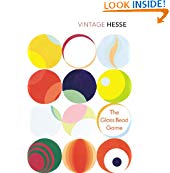
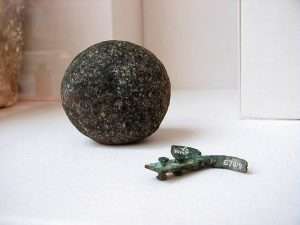
Dixon relics. Found in the shafts of the 'Queens chamber'. Any glass?
"Analogy{?}: "Basil Valentine says of this Stone: 'When ashes and sand have been timely heated in the fire, the Master {'higher' self?} makes therefrom a 'Glass', which henceforth is always able to resist the fiery heat {'crystalization' of something?}. In colour it resembles a transparent stone and is no longer recognisable as ashes. For the unknowing this a great and secret art; but not so for those who know, for its their craft, attained through knowledge and experience...After its dissolution the Strong Door of the royal Chamber can be opened {'vertical'? link}. So we see here too that the glass object, the transparent stone of the wise, is needed if spiritual knowledge is to be fruitful; and the attainment of it means first the 'purification' of the soul in the 'Fire' of self sacrifice and devotion...In the poem, 'The Spoils of Annwn' there is a passage that alludes to the 'island with the strong door where the twilight and pitchy blackness were mingled together' {''Fen'' link?}- the same strong door that Basil Valentine tells of. And further on there is the 'enclosure of glass' beyond which no one beheld the prowess of Arthur. The ''transparency'' of the soul when it is embraced in a higher {'Master'?} non-physical consciousness and so is ''out of the body'' {Ihy?}, becomes one with transparency of the world of life - the 'etheric' world - that no mortal eye can 'behold' it...All these are 'immortal' symbols...So the way of the soul is through the fire and the darkness and the strong door, into - or through the power of - the transparent enclosure, the deep mystery of purified wisdom {'Bosom'?}...AND/OR...'The Stone of the Bards will prove the harbour of life...Yet it is concealed from the unawakened..." ['The Flaming Door'].
Side note 1: {And/or}: "...once the Strong Door is opened, the 'spell' {'curse'?} of the otherworld is lifted and 'remembrance returns' in a painful flood." [Page 47 'Mabon and the Mysteries of Britain: An Exploration of the Mabinogion' / C. Mathews]. Try remember/forgetting etc.
Continued: Try ''Harbour'' to see something else {i.e.,within landscape symbolism}. 'Horse and rider' and/or ''deer'' ?
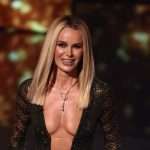
Boring?
Side note 2: ''Twilight and pitchy blackness'' in relation to Moon {twilight} and Saturn {blackness} - as A MEANS...?
And/or: ''Out of body'' in relation to 'line of sight'.

Twice as broad as long? Birket Habu?
''Perfection is not a boring, self righteous state in which you criticize everyone about you, but a widening of all your HORIZONS." [ Marian Green book. Page 42].
The ''wide'' garment of Dionysos?
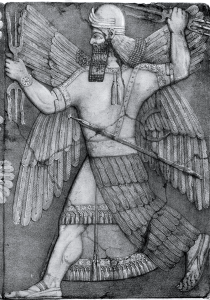
"Ninurta (Sumerian: 𒀭𒊩𒌆𒅁: DNIN.URTA, possible meaning "Lord [of] Barley"),[1] also known as Ninĝirsu (Sumerian: 𒀭𒎏𒄈𒋢: DNIN.ĜIR2.SU, meaning "Lord [of] Girsu"),[2] is an ancient Mesopotamian god associated with farming, healing, hunting, law, scribes, and war who was first worshipped in early Sumer. In the earliest records, he is a god of agriculture and healing, who cures humans of sicknesses and releases them from the power of demons." 'Three pronged'? Barley to enlarge.

Cuneiform?
A foundation tablet and a number of inscribed building cones have been found. In the 5th season, in autumn 2019, work concentrated on the Mound of the Palace where E-ninnu, a temple to Ningirsu, had been found in earlier seasons.[20] In March 2020, archaeologists announced the discovery of a 5,000-year-old cultic area filled with more than 300 broken ceremonial ceramic cups, bowls, jars, animal sacrifices, and ritual processions dedicated to Ningirsu.[21][22] One of the remains was a duck-shaped bronze figurine with eyes made from bark which is thought to be dedicated to Nanshe.....
Side note: Recall the Whale geoglyph {Nazca Lines} with "eye of stone".
Continued: Multiple literary texts focused on Nanshe are known. Nanshe and the Birds focuses on her relation with her symbolic animal, the u5 bird. Its species is a matter of dispute, with proposed identifications including goose, swan, cormorant, gull and pelican. In the myth Enki and Ninhursag, she appears as one of the deities created by Ninhursag to cure Enki's illness. Other compositions deal with her relation to the sea, fish or dream interpretation."
Any ducks in the tomb of Tut?
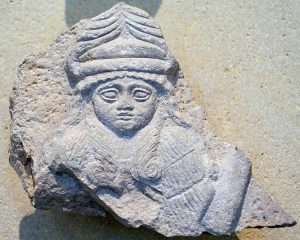
'Triangular' head gear?
"Bau, also read Baba (cuneiform: 𒀭𒁀𒌑 dBa-U2), was a Mesopotamian goddess. The reading of her name is a subject of debate among researchers, though Bau is considered the conventional spelling today.[1] While initially regarded simply as a life-giving deity, in some cases associated with the creation in mankind, over the course of the third and second millennia BCE she also acquired the role of a healing goddess. She could be described as a divine midwife. In art she could be depicted in the company of waterfowl or scorpions.
In sources from Lagash and Girsu, Bau's husband was the god Ningirsu."
"Two swimming ducks."
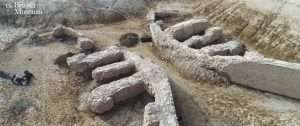
Girsu: "A very unusual construction, like a big 'X'. Like two convex walls. Made of 'fire bricks'...Kept maintained for centuries...Stands inside an ancient canal. The foundations for a bridge, made from thousands of mud brick with bitumen as mortar {'fourteen flag/pennant poles?}. Revolutionary when first built. An ancient water management system. By squeezing the current through the narrow channel it picks up speed without raising the level downstream. The oldest bridge ever found in the world....Many canals found throughout this first city...Sheep and goats in this 'Garden of Eden'..."Could religion explain the birth of the FIRST cities?" ['Lost Cities of the Bible: Mystery of the Great Flood' / S1 EP1 / Nat. Geo]. Any 'bridge' at Gebel el Silsila?
Sheep decans.
Side note: ''In vitro (Latin: in glass; often not italicized in English usage[1][2][3]) studies are conducted using components of an organism that have been isolated from their usual biological surroundings, such as microorganisms, cells, or biological molecules. For example, microorganisms or cells can be studied in artificial culture media, and proteins can be examined in solutions. Colloquially called "test-tube experiments", these studies in biology, medicine, and their subdisciplines are traditionally done in test tubes, flasks, Petri dishes, etc. They now involve the full range of techniques used in molecular biology, such as the omics.
In contrast, studies conducted in living beings (microorganisms, animals, humans, or whole plants) are called in vivo.''
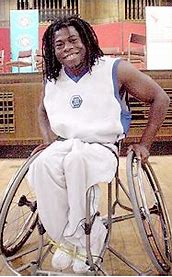
'Chariot' or funky wheels?
Continued: Understanding the above gives clues to such 'information' {keys?} as to the following - other than 'aliens from other planets': "Other hints of a mysteries lost technology connected to 'Yima' include a miraculous 'cup' in which he could 'see' everything that was happening anywhere in the world and a jeweled glass throne {sometimes described as a 'glass chariot' } that was capable of 'flight'..." [Page 138 'The Magicians of the Gods'. All emphasis, this readers - except content of parenthesis]. All in relation to the Zoroastrian religion. Enlarged elsewhere.
'The Glass Bead Game' / Hermann Hesse.
And/or: "What has been said of Oannes could also apply to Quelzalcoatl who travelled with his own brotherhood of sages: 'from across the sea in a boat that moved without paddles'...He was regarded as the founder of cities, the framer of laws and the teacher of the calendar...and brought about a type of religion that fostered peace." Same book.
Imhotep?
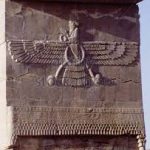
As a means...?
Think about ALL the above {'glass'} in relation to that ''bit'' within the meaning of a ''coexistence''. Try the ''Help section''. WHILE reminding oneself of the objective clause. Understanding ONLY the 'mindset' of subject material - BEFORE those two most important questions are asked.
'On Having No Head: Zen and the Rediscovery of the Obvious' / D. E. Harding.
Hence: "So, in summary, as well as a complex pattern of shared symbols and iconography, Both shared the same mission....in an epoch that is always described as being very far back in time - remote, antediluvian and hoary with age." Same book.
Can you 'see' what the author cannot?
And/or: ''Peace'' in relation to the Egyptian equivalent = ''Maat'' ?
"We believe they were home to elite tribal families / defensive forts / statements of power. But we don't know why most were abandoned by the 4th century A.D." ['Digging for Britain' / Episode 2].
'Ways of Seeing' by J. Berger.
Question. Could that ''elite family/s'' have understood something? Define those 'keys' to answer that ''mystery''. Among others try ''tower'' and/or N/E in relation to S/W? As a means...? {i.e., the above was 'decommissioned ' in the 2nd century AD - all others - by the 4th. Any Scottish links - either permanently or temporarily to the origins of 'Glastonbury'?}.
The main point being - understanding the authenticity of this 'subject material' from the oral tradition up to the present time - gives such questions {hypothesis?} validity. Understanding the parts {keys?} - gets us closer to defining what our ancestors were attempting to understand {within?} themselves.
"A new way of seeing is a new way of feeling.'' D. Hockney.
Question. Outward manifestation of something within? Archetypal? 'Decommissioned' ONCE understood?
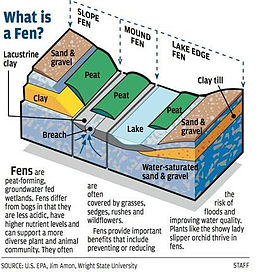
''The Fen is one of the main types of WETLAND. Recall Sea Henge {and/or Seahenge}.
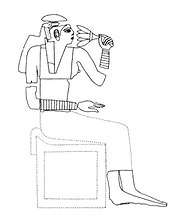
'Twentyseven'.
AS IS: "Much has been made of the fact that, at all periods of European prehistory, some bodies were interred upon their sides in a crouching posture. The resemblance to a foetus in a womb has encouraged speculation that these individuals were being returned to the earth to be reborn. This may be true, but as many primitive peoples sleep with knees drawn up, it may be a final rest which is indicated instead. Support for the notion of rebirth may be drawn from the fact that a sixth of the known Palaeolithic burials {scattered from Wales to Russia} were sprinkled with red ochre {author speculates about menstrual blood etc}...Red had a significance in the Old Stone Age which we cannot now comprehend: this would explain why certain artefacts and ornaments deposited in caves were coated in the same ochre...

Red thread?
We are left wondering why some people were interred crouching and most not, some with goods or ochre and most with neither, while the vast majority of the population does not seem to have been buried at all {i.e., exoteric/esoteric?}...
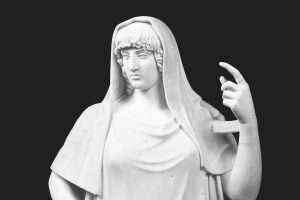
Hestia: Guardian of the hearth. N/W?
Side note: "Let us again re-capitulate the teaching about Being. First, a man must be in life and have dealt with life and reached some adequate position in life and knowledge of life and so be a Good Householder, capable of dealing with the ordinary difficulties and problems of human existence—that is, the Work is not for people who seek to escape from the normal burdens of life. It is for normal decent people and starts from that level of Being. It is very important that everyone should understand this. Second, a man’s Being must have some trace of Magnetic Centre in it. This means that in the Work-teaching of what Being means, a man who has no Magnetic Centre, whoever he is and whatever he is in life, is at a lower /eve/ of Being than a man who has Magnetic Centre. Here, you will all see, the Work-teaching about Being breaks away entirely from any ordinary conception of Being. A man who is on the general level of Being called Good Householder and has Magnetic Centre is at a higher level of Being than the man who is in a broad sense simply a Good Householder." {'Psychological Commentaries on the Teaching of Gurdjieff and Ouspensky' / M. Nicoll}.
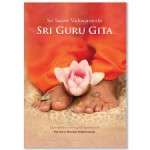
'Spirit' or 'Soul'?
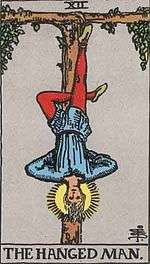
Thinking with feet or head?
And/or: Ochre (/ˈoʊkər/ OH-kər; from Ancient Greek ὤχρα (ṓkhra), from ὠχρός (ōkhrós) 'pale'), iron ochre, or ocher in American English, is a natural clay earth pigment, a mixture of ferric oxide and varying amounts of clay and sand.[1] It ranges in colour from yellow to deep orange or brown. It is also the name of the colours produced by this pigment, especially a light brownish-yellow.[2][3] A variant of ochre containing a large amount of hematite, or dehydrated iron oxide, has a reddish tint known as red ochre (or, in some dialects, ruddle).
The word ochre also describes clays coloured with IRON oxide derived during the extraction of tin and copper.[4]
HENCE: "Magnetic centre is therefore something in a man that gives him the first feeling of things above and things below or things more internal and more external and relates him to the idea of the vertical scale of things, however dimly. For the vertical is internal and everything higher in the vertical scale is more internal in man." {'The Mark' / M. Nicoll}.
Mind set?
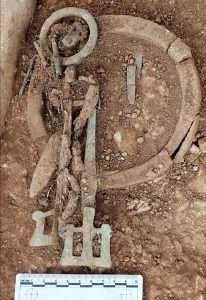
Ivory bag rings have been found in more than 70 cemeteries across southern, central, and eastern England dating to between the late-5th and 7th centuries AD. These rings are most frequently found in richly furnished female graves, and would have served as the framework for bags that hung at the waist. Debate over the source of this ivory has prevailed since the 19th century, with walrus and mammoth ivory considered as possible contenders to elephantid ivory. Recent excavations at an early Anglo-Saxon cemetery in Scremby, Lincolnshire revealed a number of elaborate female burials containing such bag rings....Through a multi-methodological approach, we have established that the ivory used for the Scremby bag rings came from elephants living in an area of young volcanic rocks in Africa at some point during the 5th and 6th centuries AD.
CONTINUED: The British evidence is a microcosm of the European, being drawn from just three sites {N.B. Book came out in 1990's - few more ,these days. Enlarged within} - One is the Goats Cave in the Gower Peninsula, {i.e., S/W Wales}, where a young man was put into a shallow grave with rods and bracelets of ivory and covered with red ochre; a mammoth's skull was placed nearby...it was made shortly before the last great period of glaciation. Making the oldest recorded in these islands...Once the ice retreated...few were found to be interred in the Mendip Hills. At Aveline's Hole in Burrington Combe four individuals were put into the floor, two apparently with fossils, perforated teeth for necklaces and flints." [R. Hutton].

And/or: ''In 1956 Gower was the first area in Great Britain to be designated an 'Area of Outstanding Natural Beauty'. It contain several castles, including Oystermouth Castle and Pennard Castle {overlooking Three Cliffs Bay - which is close to Oxwich Bay}. It is a peninsula on the south coast of Wales, within the county of Swansea.'' ['Chase the Case'].
Mount Scenery?
'23' to enlarge.
And/or: ''A dive performed with one's arms outspread until close to the water is known as a Swan dive.'' ['The Chase'].
'Cygnus'?
Migratory / NON-migratory?
Aswan?
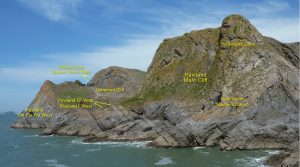
Short or long Way? Any overhangs?
Continued: S/W - sea - cave {womb?} and/or S/W - river - tor. Anything? Try ''teeth'' or ''cave'' or ''ochre'' {therefore ''red''} or ''flint'' or ''rod'' or ''ivory'' or ''elephant'' { therefore 'horn'} etc.
Side note: "The only other evidence relating to these figurines {enlarged elsewhere} is their dating, and here another striking similarity is revealed: all those from contexts which could be dated may be attributed to the centuries between about 25,000 - 23000 BC. All were therefore apparently produced in a relatively short period of the Palaeolithic, that in which the ice sheets were starting to advance southward for the last time." ['The Pagan Religions of the Ancient British Isles' / R. Hutton].
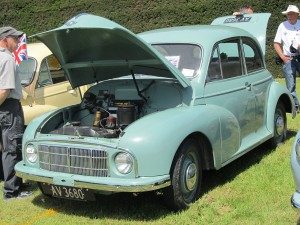
'Car' / 'chariot' or Herbie? Question. His or hers?
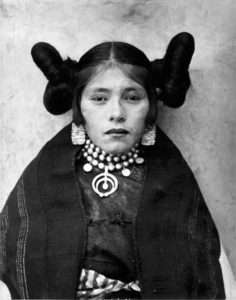
Any arms outstretched?
"Outward manifestation'' in relation to: "In seeking to understand the nature of these hidden reactions we must renounce our superior intellectual attitude which considers them only errors, mistakes, or dross and attempt to understand them in their own terms. For they are so impalpable that the intellect and rational analysis cannot grasp them...When intellectual acumen fails us in this way we have to turn to unconscious products for enlightenment and see whether a study of symbols and instinctive ways of acting may not throw some light on the obscurity. For unconscious factors of the psyche are first sensed, not in concepts, but are perceived in the outer world, projected into inanimate nature. So that when man sees human qualities and characteristics as belonging to inanimate objects {Libra?} - these are not just arbitrary imaginings but are reflections of his own unconscious qualities. When he regards natural phenomena naively, personifying them as in myths and folk tales {i.e.,as one example; as described in such books as 'The Flaming Door: The Mission of the Celtic Folk Soul'. Enlarged elsewhere} - or in the poetic language of art, he is interpreting Nature in accordance with his own nature. His unconscious is projected to the outer world. In the ancient half-forgotten folk myths of a people, we find relics of archaic, primitive ways of thinking which have been largely displaced in the Western world and in modern times by the more developed cultures superimposed upon them. But they are not for that reason extinct nor are they without meaning, as is shown by the fact that they reappear, today, from the unconscious in dreams and phantasies. Through a study of them something may be learned of those unrecognised laws which rule in the unconscious {Wolfgang Pauli?} - where our modern rational and scientific ways of thought are powerless to penetrate." ['Women's Mysteries'].

The Magura Cave (Bulgarian "пещера Магура") is located in north-western Bulgaria close to the village of Rabisha, 25 km (16 mi) from the town of Belogradchik in Vidin Province.
The prehistoric wall paintings of Magura have great resemblance with those of the Grotta dei Cervi in Italy, which are of exceptional expression and artistic depth and are considered the most significant works of art of the European Post-Paleolithic era.[1]

The Sycamore Gap Tree or “Robin Hood Tree” is a sycamore tree (Acer pseudoplatanus) standing next to Hadrian's Wall in Northumberland, England. The lake of Crag Lough and the village of Once Brewed are nearby, as is the Twice Brewed Pub, useful for trekkers at days end.
''Me {I} and Us'' = {objective/subjective} in relation to ''great'' {'giant'} and ''earth'' {primordial mound}. Among others try ''food''.
Or the Egyptian 'Anubis' in relation to Horus. Explained elsewhere, in relation to 'higher' / 'lower'.
The word 'giant' also used in relation to Gog and Magog.
REFRESHER: "What scripture says about Og, ''Behold, his bedstead was an iron bedstead, nine cubits in length," {Deut.3-11}….The bedstead is never the same dimensions as the person sleeping in it...it is always greater by a third....'The cubit of a man' means the measure of an ordinary man and not by the measure of Og…" [Page 248 'Guide for the Perplexed'].

British Penannular brocch. Pre Roman. Came back into use after they left. 'Gap'?
The 'third' if something in relation to 'sleep'. Try ''nine'' and/or ''iron'' IN RELATION to gold/silver.
 Side note: "The same myth also provides insight into the two paths or ways of 'salvation'. The Way of Osiris and the Way of Horus. The former is the way of 'reincarnation', of progressive dissolutions linked only by the generative principle; the latter is the direct path; that of the warrior of the spirit, out to subdue the enemy within himself by his own efforts." [Page 129 'Serpent in the Sky'].
Side note: "The same myth also provides insight into the two paths or ways of 'salvation'. The Way of Osiris and the Way of Horus. The former is the way of 'reincarnation', of progressive dissolutions linked only by the generative principle; the latter is the direct path; that of the warrior of the spirit, out to subdue the enemy within himself by his own efforts." [Page 129 'Serpent in the Sky'].
..................

A leap across a gap?
And/or: "This knowledge is not set down explicitly in books, but is embodied in the building itself...The proportions of the Temple are those of Adamic Man, man before the 'fall' - and of 'perfected' man, man who has regained his cosmic consciousness through his own efforts..." [Page 159 same book].
''If the ''opening of the heart'' bestowed by this new mentality is not understood, the effect involved will be questioned: 'Why take such pains to decipher a teaching so far removed from us?' We would reply: 'It helps arrest our dangerous fall, and to give us a means to ascend towards our superhuman aim.' We must understand that everything said in this way goes well beyond our usual understanding and concerns hidden vital laws." [Page 59 'The Egyptian Miracle' / R. A. Schwaller de Lubicz].

Little or big Queen?
The term "Bridge of the Sirat" hasn’t been used in the Quran and the word "Sirat" which has been only means “way”, the question is why is the term "Bridge of the path" used by people so much and how are the two terms of "Sirat" and the "Bridge of the Sirat" related to each other?
Stirling Bridge to see it from a different perspective.

The Arch of Constantine. In the middle of the Seven Hills of Rome.
Side note: The Battle of the Milvian Bridge took place between the Roman Emperors Constantine I and Maxentius on 28 October 312 AD. It takes its name from the Milvian Bridge, an important route over the Tiber. Constantine won the battle and started on the path that led him to end the Tetrarchy and become the sole ruler of the Roman Empire. Maxentius drowned in the Tiber during the battle; his body was later taken from the river and decapitated, and his head was paraded through the streets of Rome on the day following the battle before being taken to Africa.[2]
According to Christian chroniclers Eusebius of Caesarea and Lactantius, the battle marked the beginning of Constantine's conversion to Christianity. Eusebius of Caesarea recounts that Constantine and his soldiers had a vision sent by the Christian God. This was interpreted as a promise of victory if the sign of the Chi Rho, the first two letters of Christ's name in Greek, was painted on the soldiers' shields.

Inside, it’s all wavy lines, shimmering coppery surfaces and burnished details. There’s an oversized artwork made of driftwood, burnt orange club chairs, silvered columns and a knock-out shimmering gold wall. It’s a tactile, seductive space and that’s before you’ve even reached your bedroom.
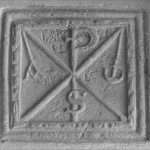
Hung / hang to enlarge.
AND/OR: The middle eight, also known as the bridge, is a section of a song with a different melody and lyrics that creates a contrast to the verse and chorus. It is usually placed after the second chorus in a song and helps the song develop itself in a natural way. An example of a middle eight is the part that starts with "And all the roads we have to walk are winding..." in Wonderwall by Oasis....The Beatles: Their song “A Day in the Life” has an iconic middle 8 starting at 2:17. It adds an interesting section and symbolizes chaos before waking up.
And: "Wander to the top of Long Acre, cross Drury Lane, and you’ll find yourself in a quieter, more sedate side of Covent Garden. Great Queen Street is not exactly off the beaten track, but it seems as though the hubbub, which makes this central London area so appealing to most, suddenly seems far away. The creamy façade and gold lettering of this enclave’s newest hotel gives an insight to what’s to come. Middle Eight – named after the middle part of the song that gives a touch of variety to a tune – has a fittingly intriguing name well-suited to its alluring design aesthetic. It may look elegant and discreet, but this is a hotel with soul...The philosophy of any luxury hotel should be to lure you in and Middle Eight does that slowly and confidently, or in musical terms, adagio, adagio. Just off the double-height lobby, the bar has the prettiest ceiling covered with copper, cut-out sycamore leaves – a little nod to the Sycamore Vino Cucina restaurant found beyond."
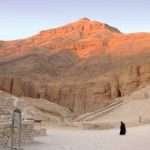
Coincidence?
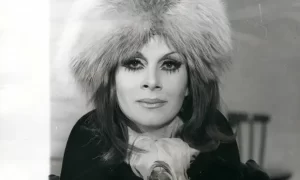 Side note: "You can follow two paths in the mountains, Her-Bak,'' said the sage. ''The first winds round it with many a twist, exploring; the slope is gentle, the ascent easy, varied, amusing. This path avoids points of danger. It never attacks the Peak {of silence?} and halts at shelters known to be safe. The other is steep {cliff?}, takes each phase of the climb without detour, skirts precipices {'overhangs'?} and reaches a summit that is only accessible to a man who can face naked sunlight and danger. Which path will you choose Her-Bak?'' [Page 89 'Her-Bak: Egyptian Initiate' / Isha Schwaller de Lubicz].
Side note: "You can follow two paths in the mountains, Her-Bak,'' said the sage. ''The first winds round it with many a twist, exploring; the slope is gentle, the ascent easy, varied, amusing. This path avoids points of danger. It never attacks the Peak {of silence?} and halts at shelters known to be safe. The other is steep {cliff?}, takes each phase of the climb without detour, skirts precipices {'overhangs'?} and reaches a summit that is only accessible to a man who can face naked sunlight and danger. Which path will you choose Her-Bak?'' [Page 89 'Her-Bak: Egyptian Initiate' / Isha Schwaller de Lubicz].

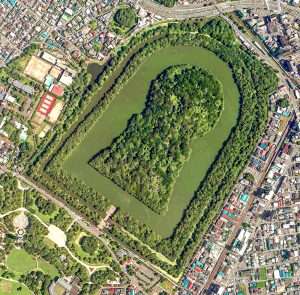 Side note: The middle 8 can even feature a completely different atmosphere in terms of the arrangement, forming an interesting contrast with the rest of the song. Quite often, it involves a key change. Whatever you choose to put in this section, there is only one important factor to keep in mind: a middle 8 exists to bring variety to a song. It is a sort of break before we go back to the main part of the tune, the chorus. It serves the need to make the song more dynamic, as it adds movement and tension, finalized to resolve on the hook....
Side note: The middle 8 can even feature a completely different atmosphere in terms of the arrangement, forming an interesting contrast with the rest of the song. Quite often, it involves a key change. Whatever you choose to put in this section, there is only one important factor to keep in mind: a middle 8 exists to bring variety to a song. It is a sort of break before we go back to the main part of the tune, the chorus. It serves the need to make the song more dynamic, as it adds movement and tension, finalized to resolve on the hook....
The bridge usually connects a verse to the chorus, while the middle 8 doesn’t serve as a connection but, rather, as a turning point. For example, Lenny Kravitz’s song I’ll Be Waiting features both a bridge between every verse and chorus and a middle 8 before the last chorus...One of the best middle 8s of all time is probably represented by the Beatles’ song A Day in the Life. The middle 8 starts at 2:17 after an orchestral break that intensively builds up towards another calmer section, somewhat symbolizing the chaos of a dream minutes before waking up.
Continued: ''Although the term the "Bridge of Sirat" hasn’t been used in the Quran, it has been mentioned in hadiths and traditions. For example Imam Sadiq (as) has mentioned this term while explaining the word "mirsad" in verse 14 of Surah Fajr, saying that it is a bridge that extends across Hell.
For further explanation we will note some points regarding the word "Sirat". "Sirat" literally means way and path and what is meant by the term "Al-Siratul Mustaqim" that is mentioned in some Quranic verses is the right and straight path of guidance in this world that if one follows, will also remain on in the hereafter, and that if he strays from in this world, will stray from in the hereafter likewise.

 Therefore if the Sirat, which is one of the stops on the day of resurrection, is referred to by terms like the "Bridge of Sirat", the "Bridge of Hell", etc., it is to simplify the meaning for people so that they can comprehend easily.
Therefore if the Sirat, which is one of the stops on the day of resurrection, is referred to by terms like the "Bridge of Sirat", the "Bridge of Hell", etc., it is to simplify the meaning for people so that they can comprehend easily.
First we need to know that the word Sirat means path, and when used with the word mustaqim as an adjective it means the straight way and right path.
This term (Al-Siratul Mustaqim) has been used in the Quran as follows:
1- "Guide us to the Straight Path".[1]
2- "Surely Allah is my Lord and your Lord, therefore serve Him, this is the right path".[2]
3- "Those who seek the protection of God will certainly be guided to the right path".[3]
4- "And [O, Messenger!] this is the Straight Path of your Creator and Nurturer; indeed We have made clear the Words of Revelation for those who accept Admonition".[4]

'Fakir' to enlarge.
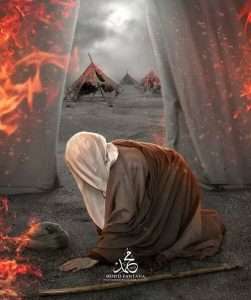
''Weaving'' link?
''Crossing the Sirat Bridge depends on everybody's light. Some will cross it in the twinkling of an eye; some, like lightning; some, like a falling star; some, like a running horse. He who has very little light will creep facedown {'prostrate'?}. His hands and feet will slip, and he will cling to it again. At long last, he will break free from it by creeping and creeping.'' [Tabarani / Wiki].
'Fool' of the Tarot ?
Side note: 'Freedom' in relation to the ''void''. {Pages 84/101 'Meditations on the Tarot'].
From a different perspective: ''In some cases, the Sajjada Nashin is the descendant of a Sufi or Pir or a descendant of one of their disciples. Sajjada means 'prayer mat' (from the Arabic sajdah or 'prostration') while nashin is the word used for the person seated thereon.[3] A Sajjada particularly tends to the shrine which is made over the Sufi's tomb or grave, known as a Dargah or Mazar. A trustee is a key person who holds and leads the traditional Sufi rituals in the Dargah's daily activities and particularly during death anniversaries called Urs. As a hereditary position the role of Sajjada nashin passes onto a child following the death of the holder.
-
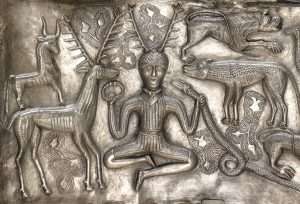
Seated on what? What can 'vegetation' be made into? Side note: N/E - S/W = 'mouth' - foot? S/E - N/W = 'tail' - horn?
Chaldean Numerology
The numerical value of Sajjada in Chaldean Numerology is: 3
-
Pythagorean Numerology
The numerical value of Sajjada in Pythagorean Numerology is: 1
Side note: The first brilliant cuts were introduced in the middle of the 17th century. Known as Mazarins, they had seventeen facets on the crown (upper half). They are also called double-cut brilliants as they are seen as a step up from old single cuts. Vincent Peruzzi, a Venetian polisher, later increased the number of crown facets from 17 to 33 (triple-cut or Peruzzi brilliants), thereby significantly increasing the fire and brilliance of the cut gem, properties that in the Mazarin were already incomparably better than in the rose. Yet Peruzzi-cut diamonds, when seen nowadays, seem exceedingly dull compared to modern-cut brilliants. Because the practice of bruting had not yet been developed, these early brilliants were all rounded squares or rectangles in cross-section (rather than circular). Given the general name of cushion—what are known today as old mine cuts—these were common by the early 18th century.
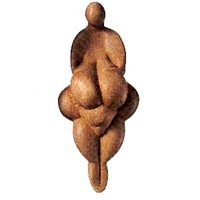
Diamonds are a girls best friend.
And/or: The Venus of Lespugue shares a number of characteristics with similar works of mobiliary art created during the Upper Paleolithic. Great attention, for instance, has been paid to its feminine features, notably its enormous, pendulous breasts, protruding belly, and exaggerated hips and buttocks. At the same time, like most other Venuses, it has no facial features (though see Venus of Brassempouy) and no arms. The overall figure is lozengic in form, and tapers from a wide midriff towards the head and feet...Approximately 6 inches in height, the ivory carving is noted for its abstraction, and for a series of unusual engravings below the buttocks, which may represent a type of textile skirt made of spun and twisted fibers, or possibly a type of ritualistic skin decorations.
Queen of punt. ''....I will seek thee: my soul thirts for thee.....in a dry and thirsty land, where no water is...to see thy glory as i saw thee in the sanctuary...i will lift up my hands in thy name....My soul shall be satisfied as with marrow and fatness....My soul followeth hard after thee; thy right hand upholdeth me...'' [Psalm 63 entitled ''Satisfying the thirsty SOUL''].
Forming their own special category of portable prehistoric sculpture, these small figurines - carved out of ivory, soft stone like limestone, serpentine or, more rarely, ceramic clay - have been found across Europe from the Pyrenees to Lake Baikal - though NOT, mysteriously in Spain, the centre of so much Paleolithic cave painting.
Continued: A working example: ''Rosslyn Chapel was the vision of an ambitious and far-sighted nobleman called William St Clair. William was the third and last St Clair Prince of Orkney, and in 1436, at the age of twentytwo, he accompanied James I’s 12-year-old daughter, Margaret, to Tours, where she was married to the Louis, the son of Charles VII of France.
 While he was there, William decided to make the most of it, and he spent four years exploring the Continent. He made a particular study of the French cathedrals and their beautiful Gothic architecture. Ten years later, in the low wooded hills of Midlothian, he founded the Collegiate Chapel of St Matthew, or Rosslyn Chapel as it is better known.
While he was there, William decided to make the most of it, and he spent four years exploring the Continent. He made a particular study of the French cathedrals and their beautiful Gothic architecture. Ten years later, in the low wooded hills of Midlothian, he founded the Collegiate Chapel of St Matthew, or Rosslyn Chapel as it is better known.
Prince William, his age creeping on him, came to consider how he had spent his times past, and how he was to spend his remaining days… it came into his mind to build a house for God’s service, of most curious work…”
Father Richard Augustine Hay, Canon of St Genevieve and Prior of St Piermont, writing in 1700, from ‘A Genealogie of the Sainteclaires of Rosslyn’, 1835
By my reckoning, William would only have been 'thirtytwo' when he founded the chapel, so I’m not sure how he would have felt about the idea that age was creeping up on him. However, he must have been one for looking ahead, and he was certainly a man who dreamed big.

Clockwise/Anticlockwise?
It should be said here that William’s chapel was not the first on this site, but traces of the former building are hard to find, and its very existence seems to have been largely obscured by the glorious presence of its successor. Some crumbling buttresses survive in the nearby graveyard; and about half a mile down the hill, an even earlier place of worship was incorporated into the St Clair stronghold of Rosslyn Castle...“The first chapel nestled inside Rosslyn Castle within a curious curved stone wall known as the ’rounds’, resembling a honeycomb....The honeycomb design is an interesting element, which I’ll explain later on.'' ['The Hazel Tree: Rosslyn Chapel: catching the light' / Internet].
A buttress is an architectural structure built against or projecting from a wall which serves to support or reinforce the wall.[1] Buttresses are fairly common on more ancient buildings, as a means of providing support to act against the lateral (sideways) forces arising out of inadequately braced roof structures.

A corner of the Temple Mount.
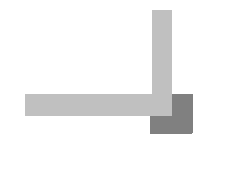 The term counterfort can be synonymous with buttress[2] and is often used when referring to dams, retaining walls and other structures holding back earth.
The term counterfort can be synonymous with buttress[2] and is often used when referring to dams, retaining walls and other structures holding back earth.
Early examples of buttresses are found on the Eanna Temple (ancient Uruk), dating to as early as the 4th millennium BC.[citation needed]
In addition to flying and ordinary buttresses, brick and masonry buttresses that support wall corners can be classified according to their ground plan. A clasping or clamped buttress has an L-shaped ground plan surrounding the corner, an angled buttress has two buttresses meeting at the corner, a setback buttress is similar to an angled buttress but the buttresses are set back from the corner, and a diagonal (or 'French') buttress is at 135° to the walls (45° off of where a regular buttress would be).
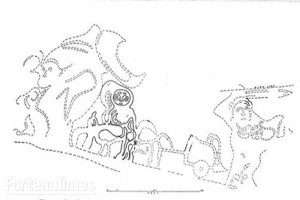
Where have you seen it before?
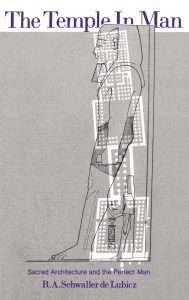
Buttress or support?
Continued: "The fifth century A.D. saw the first seeds sown in Britain of the Anglo Saxon race, when Britain was invaded by a 'mare and a horse'. The brothers Hengist and Horsa. This was the time when the Druid Mysteries were in decay....And we see Ceridwen - not as a very earthly horse! - but armoured with the sharp attacking bird's beak {'hooked' and/or Oxyrhynchus fish? Griffin?}, and having her body like an 'ark' or womb of the concealed spirit. The new age is already heralded, but unformed and chaotic, like the drawing. There are many references in Welsh mythology to Arianrod, Iris, the Goddess of the Silver Wheel. She is generally supposed to be the goddess of the rainbow, but not the rainbow we are accustomed to see {i.e., what the author defines as ''clothed in a rainbow coloured aura} - this was called Iris - the Great Aura,'' i.e., in relation to ''dawn of serenity for a neophyte'', i.e.,''an imaginative vision'' {eureka moment link?}. ['The Flaming Door']. Try ''girdle'' to see it in its broader context.
From a different pespective: ''In the bright, translucent colours you see the family of the neteru rising up and crossing the rainbow as though it were a giant bridge...''
And/or: ''Aura - comes from the Latin for 'breath'....'' ['The Chase'].
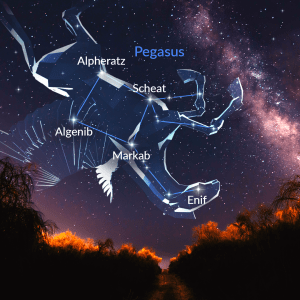 "According to early sources,[which?] Hengist and Horsa arrived in Britain at Ebbsfleet on the Isle of Thanet. For a time, they served as mercenaries for Vortigern, King of the Britons, but later they turned against him (British accounts have them betraying him in the Treachery of the Long Knives). Horsa was killed fighting the Britons, but Hengist successfully conquered Kent, becoming the forefather of its kings.
"According to early sources,[which?] Hengist and Horsa arrived in Britain at Ebbsfleet on the Isle of Thanet. For a time, they served as mercenaries for Vortigern, King of the Britons, but later they turned against him (British accounts have them betraying him in the Treachery of the Long Knives). Horsa was killed fighting the Britons, but Hengist successfully conquered Kent, becoming the forefather of its kings.
A figure named Hengest, possibly identifiable with the leader of British legend, appears in the Finnesburg Fragment and in Beowulf. J. R. R. Tolkien has theorized that this indicates Hengest/Hengist is the same person and originates as a historical person.[4]
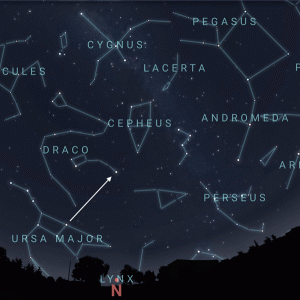 Hengist was historically[clarification needed] said to have been buried at Hengistbury Head in Dorset."
Hengist was historically[clarification needed] said to have been buried at Hengistbury Head in Dorset."
"Hengistbury Head (/ˈhɛŋɡɪstbəri/), formerly also called Christchurch Head, is a headland jutting into the English Channel between Bournemouth and Mudeford in the English county of Dorset. It is a site of international importance in terms of its archaeology and is scheduled as an Ancient Monument.[1] Declared a Local Nature Reserve in 1990, the head and its surroundings form part of the Christchurch Harbour Site of Special Scientific Interest.[2] It is also a Special Area of Conservation, Special Protection Area, an Environmentally Sensitive Area and a Site of Nature Conservation Interest.[3] The name "Hengistbury Head" refers to the whole of the headland area; the elevated portion is called Warren Hill."
What river flows into the habour?

Man in the moon?
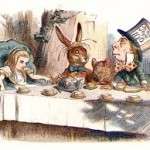
Mad march hare?
"Warren Hill is the elevated part of Hengistbury Head in Dorset, England, overlooking Christchurch to the North and dominating Poole Bay to the West. With finds stretching back over 10000 years.....A warren is a network of interconnected burrows, dug by rabbits. Domestic warrens are artificial, enclosed establishments of animal husbandry dedicated to the raising of rabbits for meat and fur. The term evolved from the medieval Anglo-Norman concept of free warren, which had been, essentially, the equivalent of a hunting license for a given woodland....The cunicularia of the monasteries may have more closely resembled hutches or pens, than the open enclosures with specialized structures which the domestic warren eventually became. Such an enclosure or close was called a cony-garth, or sometimes conegar, coneygree or "bury" (from "burrow")....To keep the rabbits from escaping, domestic warrens were usually provided with a fairly substantive moat, or ditch filled with water. Rabbits generally do not swim and avoid water. A pale, or fence, was provided to exclude predators."

Other ''neturu'' found on pages 174 -184 'The Union of Isis and Thoth' - in relation to 'rainbow' i.e., Lotus, cauldron, Thoth, ''water and light'' - all as a means to 'see' the parts within the whole.
'Rabbit' to enlarge.
Working example: "That night, for a few hours, {H}elen went mad. My questioning her recollection had profoundly affected her and she had plunged in the evening after the session, DOWN into a nightmare memory....." [Page 76 'Apollo Versus the Echo Maker' / A. Lunt].
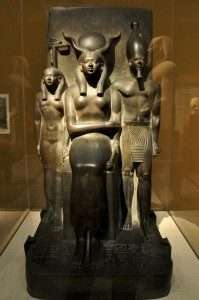
Hare in top left corner.
And/or: "This dream begins in a wild, swampy landscape, suggestive of the unknown, watery world of the unconscious. In this landscape the dreamer comes to a fairground, to which he has a ticket...The fairground with all its strange and fantastical associations describes an inner space where the figures of the imaginal can be encountered. It echoes the 'Magic Theatre' of Herman Hesse's Steppenwolf, a 'theatre' in which, behind different doors, is enacted various aspects of the unconscious of the protagonist, {H}arry Haller. And just as in the 'Magic Theatre' entrance is 'Not for Everyone', so our dreamer must have a ticket to go in. The world of the unconscious cannot be entered without paying the price, for the experience of this 'fairground' means leaving the rational world and the values of the persona. In Steppen-'wolf' the entrance is 'For Madmen Only', and the 'Price of Admittance Your Mind'. For those on the path they pay with their longing for Truth, a longing which will take them beyond the conscious mind and the surface world of appearances, into the very depths of themselves. In the fairground the dreamer enters a building , suggesting his own personal psyche, and what he wants is to find 'the deepest, darkest spot, from whence all trouble arose'....." [Page 31/2 'The Lover and the Serpent'].
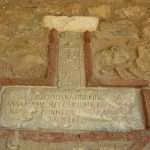
A WIDENING of ones horizon. Gold capped?

Celtic wolf, guarding 'gold'.
For this reader "fairground" relates more to the word 'revolving' - and "theatre" to either 'house' or 'Feast of Fools'. WHILE recalling that eternal 'spark/seed' that all living things have within REGARDLESS of esoteric/exoteric doctrine.
MINDSET in the 'eternal' sense of the word to enlarge.
"The fire that is not put out is a 'holy' fire....This fire is the fire of longing, the unquenchable flame in the heart that purifies the seeker, and relentlessly drives him along the Way. It is the longing that always burns and burns, taking the Wayfarer Home into the arms of the Beloved."
From a different perspective: "It is not that they did not admit the name of Sublime Father that Voluspa had given to this unknown Being for whom she had commanded respect; but this very name of Father, instead of raising them to Him, persuaded them rather to make Him descend to them, in presenting this Being to them only as the first Father of the Borean Race and the most ancient of their ancestors." {'Hermeneutic Interpretation of the Origins of the Social State of Man'}.
Smith/Jones?
Side note: Xmas presents are opened after afternoon tea on Christmas Eve instead of on Christmas Day. Prince Harry writes in his memoir Spare of Christmas Eve traditions: "We were at Sandringham in a big room with a long table covered with white cloth and white name cards.

Fire or water?

Spirit or soul. Anima or animus. Circlet?
Continued: "When does Gold Ore become pure 'Gold'? When it is put through a process of fire. So the human being during the training becomes as pure as Gold through suffering. It is the burning away of the dross....For the woman, the animus is an important figure whose spiritual aspect can help her on the quest, allowing her to live from the sacred center of her being....Within the psyche of the man the integration of the anima is of similar importance, though the anima has a different psychological dynamic to the animus. While the animus adds the strength and clarity of consciousness to the 'diffuse awareness' of the woman, the anima reconnects masculine consciousness to the inner world of the soul. For, unlike the woman who has never left the arms of the great mother, into his journey into manhood the boy becomes separated from the Source; and with the help of the anima he can return to the depths of his own being without being lost in the maze of the unconscious. The man's inner woman, the dark lady of the night, exerts her fascination in many guises, from the cover girl to the enigmatic Mona Lisa....The quality of the anima is poignantly imaged in the following simple dream: A woman in a slinky blue dress is singing 'Walking Back To Happiness' in a bluesy, soulful way." [Pages 29/62 'The Lover and the Serpent' ].
Veiled/UNveiled.
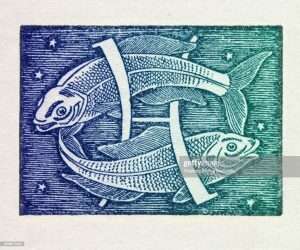 SIDE NOTE: "The Circlet of Pisces is an asterism that represents the head of the Western Fish in the constellation of Pisces123. It is formed by a rough oval of seven stars leading off towards Fumalsamakah, the westernmost major star of Pisces1. The Circlet of Pisces is located between the Great Square of Pegasus and Aquarius constellation2. It is also sometimes called the Circlet due to its distinctive shape....
SIDE NOTE: "The Circlet of Pisces is an asterism that represents the head of the Western Fish in the constellation of Pisces123. It is formed by a rough oval of seven stars leading off towards Fumalsamakah, the westernmost major star of Pisces1. The Circlet of Pisces is located between the Great Square of Pegasus and Aquarius constellation2. It is also sometimes called the Circlet due to its distinctive shape....

A beginning or end?
Pisces lies between Aries constellation to the east and Aquarius to the west. The two celestial fish represent Venus and Cupid in Roman mythology, who transformed themselves into fish in order to escape the monster Typhon. The Vernal equinox, the point at which the Sun moves to the northern hemisphere across the equator every year, is currently located in Pisces....The Circlet of Pisces. The Circlet asterism is located south of Pegasus constellation, in the western fish of Pisces. It is formed by the stars Gamma, Kappa, Lambda, TX, Iota and Theta Piscium. The Circlet of Pisces, the Great Square of Pegasus, and the Water Jar in Aquarius."
"Head jar" to enlarge.

Amenhotep III to enlarge.

Continued: ''People will cross the bridge that will be over Hell. On the bridge will be thorny iron, hooks, and clasps, which will catch people from the right and left {E/W?}. The angels on the bridge will pray, "O my Allah, give salvation." Some will cross the bridge like lightning; some, like the wind; some, like a running horse; some, by running; some, by walking; some, by crawling; some, by creeping. As for those who will go to Hell, they will neither die nor attain a new life. After sinners burn in Hell as much as their sins, intercession for them [sinners] will be permitted.'' [Bukhari].
Refresher: "....the path of love is like a bridge of hair across a chasm of fire." {I. Tweedie].
''The Sirat is thinner than a hair and sharper than a sword. Angels will try hard to save Believers. Jabrail 'alaihis-salam will grip my waist, and I will pray, "O my Lord! Give salvation to my nation and rescue them." On that day many people who will slip and fall.'' [Bayhaqi]
A working example: Amarna coloured braided hair-piece extensions.
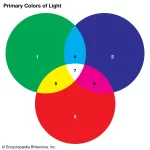
What's the primary colour for M/F? NOT the secondary i.e., outer 'garment'!
Continued: Something hinted at {in 'story' form?}: "The colours were nearly blinding. Instantly, the 'glass boat' broke the white shaft into a spectrum {'137'?} of brilliant colours, which then took the form of a rainbow -layers of 'arched' light extending up to the sky..." [Page 390 'The 21 Lessons of Merlin: A Study in Druid Magic and Lore' / D. Monroe].
Try ''aura''.
''Lightness'' ?
Side note: A rainbow mentioned after lighting up Westminster Hall on the EVE of the 'nineteenth' . {Funeral of Queen Elizabeth II}.
Continued: Apply the above to get a {'deeper'?} meaning to: "Edward Davies was justified in regarding those British priests as a sort of Orphics: dress, dogma, ritual and diet correspond closely. And since the Battle of the Trees proves to have been a battle of 'letters' rather than trees, his suggestion that the fabulous dance of trees to Orpheus's lyre was, rather, a dance of letters, makes good historical and poetic sense....

Straight lines and curves. 90/180?
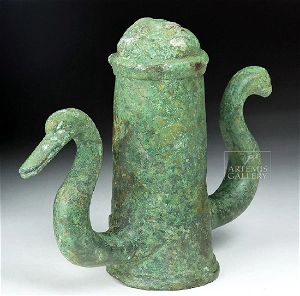
A Roman swan figurine used as a chariot rein guide for two horses - made in bronze. "Swans neck" to enlarge.
…..But there may have been a plainer meaning for the 'dance of the trees'. According to Apollonius Rhodius, the wild oak trees which Orpheus had led down from the Pierian mountain were still standing in ordered ranks in his day at Zone in Thrace. If they were arranged as if for dancing that would mean not in a stiff geometrical pattern, such as a square, triangle, or avenue, but in a curved one. Zone {'a woman's girdle'} suggests a round dance in honour of the 'goddess'..." [Page 141 'The White Goddess'].
Try the title of the book to see the parts within the whole.
Side note: "Rudiobus is a Celtic god[1] known only from a single inscription, on a bronze figurine of a prancing horse: "sacred to the god Rudiobus". This figurine, from the 1st century BC, is one a group found at Neuvy-En-Sullias (Loiret). It may be an aspect of the Gaulish version of Mars, instead of an indigenous god.[2] The hoard was discovered in 1861; the horse with the Rudiobus inscription is one meter high."
N.B. Bronze = copper, tin, lead.
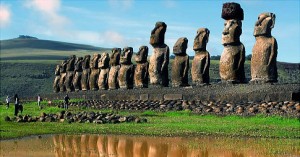
Made of volcanic rock. '15' in total. Anything?
Continued: Analogy..."Lake Atitlan is the jewel of the highlands. The lake is surrounded by astounding natural beauty. It floats in the sky, a mile above sea level, relying on 3 majestic volcanoes to hold gravity at bay.
The word Atitlan is a Mayan word that translates as "the place where the rainbow gets its colours". The main tourist center is Panajachel, an 800 year old pueblo of about 14000, mostly Cakchiquel Mayas and some foreigners from every corner of the globe, living inside that rainbow.
In the highlands of Guatemala, especially around Lake Atitlan, the Mayan culture still thrives. The spirit it invokes is the hidden gem of Guatemala, and makes this one of the most exotic destinations in the world.
The Maya are known for being friendly, funny, welcoming of strangers, and also shy. Living among them is an enchanting experience. There are about a dozen other villages scattered around the lake. Some are Cakchiquel, some Tz'utujil and both speak different languages. The indigenous lake people were accustomed to dealing with other cultures they couldn't communicate with, long before tourists ever showed up. [www.atitlan].
''Different languages'' in relation to 'Tower of Babel' story - ''where ALL spoke one language.''
''Lake'' in relation to 'Still waters run deep' - the crystallization of something.

Abstract 'lightening bolt'? And/or: ''Green sap of spring in the young wood a-stir - will celebrate the Mountain Mother....Ruled by the god Apollo's Golden Mean....I forgot cruelty and past betrayal, careless of where the next bright BOLT may fall. All in relation to 'The White Goddess' / R. Graves. Question. ''Golden Mean'' = midway between higher/lower? Dog = 'lower'. 'Tree' / higher? 'Disc's = ''duality''?
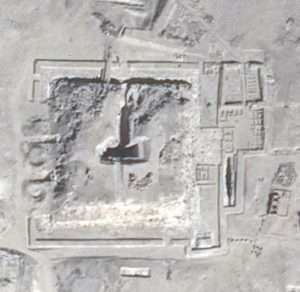
Longer or wider?
A {working?} example: in the sense of a representation {one example ONLY} - of the benefits of inspiration and aspiration: "The two side Paths here are also more aspirational than their equivalents that led out of Malkuth. They are represented by the 'Sun' and the 'Star'. The Sun that beams down from Hod is the bright light of self evident spiritual truth, a light by which all dark places are enlightened. The Star is the realization and feeling of 'divine' beauty that comes from Netzach. It is closely associated with Venus, where the pattern of the Earthly paradise {'seven / eight' link?} - is said to be held. These aspirations for Truth and Beauty therefore flank the path of Aspiration that leads to higher consciousness. But aspiration is not enough on its own. Aspiration alone can be but wish fulfilment fantasy unless we have the will and ability to bring it to realization and fulfilment. This is implied by the transverse path across our way; its symbol - the Lightening - struck Tower....
'Stacked'?

Aspiration alone might be regarded as our being enclosed in an ivory tower, and many are there {within this subject} who remain in this condition. High on great thoughts but low on practical achievement. If we are to progress to be responsible servers of the 'higher' powers in the Temple of Tiphareth - 'the sphere of the god made Manifest, in the sphere of the mind' - then we have to be prepared for the lightening flash of illumination, or the lightening flash of destruction of false values. This may come to us as a shock, but it also a form of enlightenment..." ['Magical Images and the Magical Imagination' / G. Knight].
From a different perspective: At Heliopolis the mystery of the Creation is described in its archetypal aspect. Here the name Atum is given to the One, the unique Power which will become the Creator or Demiurge. Atum means both All and Nothing, the potential totality of the Universe which is as yet unformed and intangible — for first Atum must ‘project himself or distinguish himself from the Nun, and thereby annihilate the Nun in its original inert state. ‘Atum becomes.’ This first act is expressed in three major ways: Hail Atum! Hail Khepri, he who becomes from himself! You culminate in this your name of ‘hill’ {new one?}, you become in this your name of Scarab Khepri. (Pyramid Texts, 1587.) Atum-Khepri, you culminate as hill, you raise yourself up as the Benu Bird from the ben-ben stone in the abode of the phoenix at Heliopolis. (Pyramid Texts, 1652}.
Atum surges out of the cosmic waters in the form of the primordial hill. He then ‘spits out’ (ishish) the first of the divine qualities or powers: Shu, the Principle of air and of space, symbolized by the feather he wears on his head. Atum then ‘expectorates’ (tint) the second Principle, the lion-headed Tefnut, who most probably represents the element of Fire....In a third version, Atum creates himself by the projection of his own heart, and brings forth eight elementary principles which, together with himself, make up the Nine, the Great Ennead of Heliopolis: Shu and Tefnut, then Geb, the Earth, Nut, the Sky, and finally Osiris and Isis, Seth and Nepthys, entities of cyclic life and renewal, of death and rebirth. It is written that ‘none of these entities is separate from him, Atum’ (Pyramid Texts, 1655).
Question. Abu Ruash - Egypt's most northern pyramid - A collapsed one. Built on a hill.
Analogy: {ie., as seen from a different perspective. A different time and place}: "My impressions of Dinas Emrys were surprising, as I had not expected much. I knew that local legend and traditional history associated it with king Vortigern's tower, and that there was a ruined structure on its summit." ['The Way of Merlin'].
Caves and pits found in both. Undermined foundations the cause of both? As a means...?
If Egypt's most northern 'pyramid' equates to something ''undermined'' WHERE would its opposite {firm feet?} be represented?
"The quest for the Grail begins with the question of what exactly one is looking for. Whatever it may be, it is something that has an immediate, widespread effect, whenever it is rediscovered. The persons mind is stunned into a new way of 'thinking,' and the change is reflected [eventually] into a new idealistic form of society. Yet besides creating a sensation, it has further, long lasting quality. It serves as a constant fount of inspiration and wisdom, sanctifying the lives of those who posses it. When it is lost, harmony and good order vanish with it." [Introduction to the book, 'The Twelve - Tribe Nations' by J. Michell and C. Rhone]. Try ''quality'' and/or ''grace'', i.e.,what does it imply? Then ''oracle''.
REfresher: "The Agnisuryans respond to the sound. The waters ebb and flow. Let the 'magician' guard himself from drowning, at the point where land and water meet. The midway spot, which is neither dry nor wet, must provide the standing place whereon his feet are set. When water, land and air meet this is the place for 'magic' to be wrought."
The authors 'defining' the number twelve within this subject as a whole; just as Geoffrey Ashe does with the number seven. Found within.
''...constant fount of inspiration'' = 'Fountain' link? Use it to define {link?} the following...
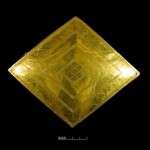
Bush Barrow 'lozenge' - enlarged elsewhere.
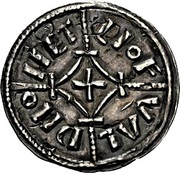 "During the period i was preparing this book, Robert Lomas, one of the authors mentioned above, wrote a further work with the title 'Turning the Hiram Key'. In their previous works, Robert Lomas and Christopher Knight had drawn attention to the chapel at Rosslyn, just outside of Edinburgh, Scotland - a chapel that contains considerable Masonic symbolism carved into the stone of the structure. Rosslyn was built in the 15th century by William St. Clair, the last Norse Earl of Orkney, whose family had, for some centuries, provided the Grand Masters of Freemasonry in Scotland. Robert Lomas has argued that the origins of modern Freemasonry can be traced to the building of the chapel. In a chapter about symbolism, Lomas visits the subject of the 'lozenge' shape {'form'?} as it may have been associated with the cult of the 'Goddess'. He also draws attention to the method of using the lozenge shape as a means of determining the latitude of one's position. He goes on to state: 'At the latitude where the Temple of Rosslyn was built, the solstice angles produce a perfect square, {'cube' ?} and that is where modern Freemasonry began'. This is an interesting observation because in a masonic ceremony of initiation, the candidate is admitted - on a square." [From the book by K. Gest. All emphasis, this readers].
"During the period i was preparing this book, Robert Lomas, one of the authors mentioned above, wrote a further work with the title 'Turning the Hiram Key'. In their previous works, Robert Lomas and Christopher Knight had drawn attention to the chapel at Rosslyn, just outside of Edinburgh, Scotland - a chapel that contains considerable Masonic symbolism carved into the stone of the structure. Rosslyn was built in the 15th century by William St. Clair, the last Norse Earl of Orkney, whose family had, for some centuries, provided the Grand Masters of Freemasonry in Scotland. Robert Lomas has argued that the origins of modern Freemasonry can be traced to the building of the chapel. In a chapter about symbolism, Lomas visits the subject of the 'lozenge' shape {'form'?} as it may have been associated with the cult of the 'Goddess'. He also draws attention to the method of using the lozenge shape as a means of determining the latitude of one's position. He goes on to state: 'At the latitude where the Temple of Rosslyn was built, the solstice angles produce a perfect square, {'cube' ?} and that is where modern Freemasonry began'. This is an interesting observation because in a masonic ceremony of initiation, the candidate is admitted - on a square." [From the book by K. Gest. All emphasis, this readers].
Norse in relation to 'top down'.
Question. Why should that title be given to anybody at all? Similar to the Le - Strange title? Enlarged elsewhere.
Side note: ''The buttons on a Doreen Lofthouse DRESS inspired the lozenge shape for the menthal tablet called Fisherman's Friend.''
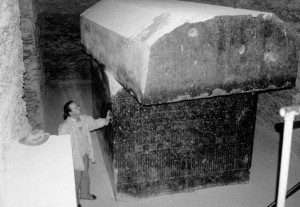 Working example: ''In Celtic cultures and throughout Ireland, Scotland and Wales, and Brittany, the pig was the animal associated with the Mysteries and with the sacred underground burial vaults of kings - the barrows - again, a name derived from the ancient name for the pig. The Celtic goddess Cerridwen was said to fly over the countryside {'air' link}, in the guise of a great white sow, occasionary giving birth and dropping piglets - and wherever they landed a Mystery school was said to form. Among the Druids the Arch Druid Merlin, was also known as the divine pig herder - as contrasted with the holy shepherd of Christianity.. The TRACK of the sacred pig can be traced around the world from Ireland to the Pacific...Our ancestors believed the pig represented the Mystery of the earth, in which it was always rooting, and with it, a knowledge of the mystery of death, and thus of rebirth in the great cosmic round {Precession?}...[Page 177/180 'The Hero and the Goddess'].
Working example: ''In Celtic cultures and throughout Ireland, Scotland and Wales, and Brittany, the pig was the animal associated with the Mysteries and with the sacred underground burial vaults of kings - the barrows - again, a name derived from the ancient name for the pig. The Celtic goddess Cerridwen was said to fly over the countryside {'air' link}, in the guise of a great white sow, occasionary giving birth and dropping piglets - and wherever they landed a Mystery school was said to form. Among the Druids the Arch Druid Merlin, was also known as the divine pig herder - as contrasted with the holy shepherd of Christianity.. The TRACK of the sacred pig can be traced around the world from Ireland to the Pacific...Our ancestors believed the pig represented the Mystery of the earth, in which it was always rooting, and with it, a knowledge of the mystery of death, and thus of rebirth in the great cosmic round {Precession?}...[Page 177/180 'The Hero and the Goddess'].
Working example: Knowe of Swandro to enlarge.

North celestial pole = center point. 'Handle' on the moment?
 And/or: ''The great stuck place of his life. The actual famed 'adventure' took only a few weeks - apart from the year spent with Circe, the rest of the time he was stuck in the middle of nowhere....The long resting place to the soul's development...a place to rest and vegetate.'' [Page 62/245 'The Hero and the Goddess: The Odyssey as Pathway to Personal Transformation' / J. Houston].
And/or: ''The great stuck place of his life. The actual famed 'adventure' took only a few weeks - apart from the year spent with Circe, the rest of the time he was stuck in the middle of nowhere....The long resting place to the soul's development...a place to rest and vegetate.'' [Page 62/245 'The Hero and the Goddess: The Odyssey as Pathway to Personal Transformation' / J. Houston].
'Stuck in a rut'?
Hog Boy?
A working example: "I think i was stuck in the 80's but i refused to stay stuck....
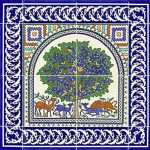

Those are the hard difficult times when ones stuck. And its about finding some kind of vision; some kind of clarity about where you want to go next and what you want to do and NOT do....
My whole life has changed since i started to meditate. The journey in meditation is to find that state of equipoise - which means no matter what hits you, no matter what comes at you, no matter what throws you over either in joy or misery - you stay centered/rooted." ['Lulu' / BBC4].
Libra.
Weighing of the Heart.
Dolphin/ Porpoise?
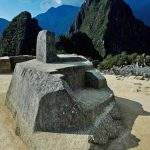
Where have you seen it before?
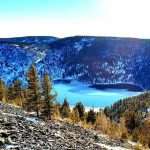 Side step: ''Arthur's Seat (Scottish Gaelic: Suidhe Artair, pronounced [ˈs̪ɯi.əˈaɾt̪ʰəɾʲ]) is an ancient volcano which is the main peak of the group of hills in Edinburgh, Scotland, which form most of Holyrood Park, described by Robert Louis Stevenson as "a hill for magnitude, a mountain in virtue of its bold design".[1] It is situated just to the east of the city centre, about 1 mile (1.6 km) to the east of Edinburgh Castle. The hill rises above the city to a height of 250.5 m (822 ft), provides excellent panoramic views of the city and beyond, is relatively easy to climb, and is popular for hillwalking. Though it can be climbed from almost any direction, the easiest and simplest ascent is from the east, where a grassy slope rises above Dunsapie Loch.''
Side step: ''Arthur's Seat (Scottish Gaelic: Suidhe Artair, pronounced [ˈs̪ɯi.əˈaɾt̪ʰəɾʲ]) is an ancient volcano which is the main peak of the group of hills in Edinburgh, Scotland, which form most of Holyrood Park, described by Robert Louis Stevenson as "a hill for magnitude, a mountain in virtue of its bold design".[1] It is situated just to the east of the city centre, about 1 mile (1.6 km) to the east of Edinburgh Castle. The hill rises above the city to a height of 250.5 m (822 ft), provides excellent panoramic views of the city and beyond, is relatively easy to climb, and is popular for hillwalking. Though it can be climbed from almost any direction, the easiest and simplest ascent is from the east, where a grassy slope rises above Dunsapie Loch.''
Above or below the clouds?
Continued: "It is by denunciation of Lancelot and Guinevere that the rot really sets in, and the bloody feud breaks out as Lancelot inadvertently kills the other Orkney brothers, Gareth and Gaheris, when rescuing Guinevere from the stake. This incites their brothers Gawain and Agravain to become sworn enemies of Lancelot and civil war breaks out which finally destroys all." {Decommissioned link?}. ['Experience of the Inner Worlds'].

'C'aroline?
Side note: "This symbol of the etheric plane is nowhere no more openly announced than in Notra-Dame, France...A figure is displayed within a huge lozenge, the bounds of which are decorated with small lozenges. Altogether there are 41 lozenges in this single architectural detail. What is the significance of the figure which occupies such a clearly defined etheric space? The image within the space is that of a Master Mason, and initiate. We know this because he carries the tools - even the emblems - of this trade, in the form of the 'square' and 'plumb'..." ['The Zelator']. Enlarged elsewhere.
'Square' in relation to the 4 corners {latitude/longitude?}. All as a means...?
And/or: Square ''shoulders'' {upright?} in relation to Homers Iliad?
A Head scratch..."So, what could the number '120' relate to ? Old testament text implies the word 'oracle' is associated with the holy of holies, which we know is a cube measuring twenty cubits..." Continued / enlarged elsewhere.
N.B. Early spring from 15th - 22nd = Passover.
15th Nome in relation to the position {latitude?} of Mount Sinai.

Sycamore GAP along Hadrians Wall. N/W boundary of Europe.

Philae Temple. Southern {Roman?} border/'boundary' line.
And/or: "It was a relative who gave me the Orange/Almond Cake recipe...Boil an orange for a few hours to be minced together with sugar, almonds and eggs. It was then baked. Called a Passover Cake - in which no ingredient's can be chosen that ferment. Almonds substituted for flour." Quote by Claudia Roden - 'Book of Jewish Food' ['The Food Chain'/BBC World service. April 2018]. Put those keys together to attempt to understand why - if only in defining a ''mind set''.
Leavened / unleavened bread? All as a means....?
'Searching For The Sugar Man: Rodriquez' {2011}.
[Food. Vol. 1. 'Gift of Osiris'. W.Darby].
Something to ponder on: 'Burnt' funerary cakes {scones?} = ?
 Side note: "The natural function of Het-Her as nurturer is expressed in her dual association with the cow, feeding the newborn 'royal child' on earth and the newly awakened 'soul' in heaven. She was said to greet the sojourner in both instances in her multiple forms of seven, her sacred number. The importance of Het-Her throughout ancient times was not confined to the borders of ancient Egypt. In addition to the great Ptolemaic temple complex at Dendera, there were seven known shrines in antiquity of the goddess, corresponding to the seven forms of the Neter mythically present at the death and birth of every human. They were located according to legend, in Thebes, Heliopolis, Aphroditopolis, Ammu, Herakleopolis, Keset, and at Sanai. These locations are said to be the seven 'navels' of the Neter, spanning the seven degrees of latitude that encompasses the land of Egypt." ['Sacred Tradition of Ancient Egypt'].
Side note: "The natural function of Het-Her as nurturer is expressed in her dual association with the cow, feeding the newborn 'royal child' on earth and the newly awakened 'soul' in heaven. She was said to greet the sojourner in both instances in her multiple forms of seven, her sacred number. The importance of Het-Her throughout ancient times was not confined to the borders of ancient Egypt. In addition to the great Ptolemaic temple complex at Dendera, there were seven known shrines in antiquity of the goddess, corresponding to the seven forms of the Neter mythically present at the death and birth of every human. They were located according to legend, in Thebes, Heliopolis, Aphroditopolis, Ammu, Herakleopolis, Keset, and at Sanai. These locations are said to be the seven 'navels' of the Neter, spanning the seven degrees of latitude that encompasses the land of Egypt." ['Sacred Tradition of Ancient Egypt'].
And/or: ''To plant a life giving seed one has to dig into the earth.''IN RELATION to the journey Mary and Joseph took on their way to Bethlehem. Along the Jordan Valley - the lowest elevation on earth. [ 2nd Week of Advent / Magdala / K. Nickhols / 2021].
 'Seven' in relation to 'eight'? Enlarged elsewhere.
'Seven' in relation to 'eight'? Enlarged elsewhere.
What about Longitude?
Question. Sanai in relation to the 'Golden Calf'? If so, what does it REPRESENT?
Side note: ''The 'flag' as a symbol of the presence of any ''divine'' being - god or goddess - harkens back to one of the oldest goddesses, Neith, the weaver. Her name in early hieroglyphs was written as N-t, and it meant ''the goddess.'' Subsequently, N-t-r became any god or goddess. N-t in hieroglyphs also is part of the word meaning ''to knit'' or ''to weave'' or ''to net'' {'153'?}....In Alexandria, the cosmopolis of ancient cultures where many languages merged, the ancient Egyptian word neter and the Coptic Christian word for ''the god'' came to be pronounced something like netjer; from this, the essence of the Latin word for NATURE, natura, emerged....the early Christian name for 'God'...." [Page 35 'The Union of Isis and Thoth' / N. Ellis and N. Scully].
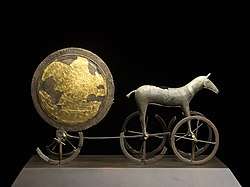
East-west.

South-north.
Continued: {i.e.,in ONE sense of the word}: "Whatever cosmic map we choose will help us to understand how the inner world is structured. In this sense a cosmic map is a comprehensive magical image in its own right. If we identify with it and build it as a pattern { to weave/knit?} within our own aura it helps us to maintain personal balance and gain general understanding of our own spiritual potential. However, it will also reveal more if we examine and experience it in its detailed parts. By moving from one part of the system to another{'corner' to corner?}, we will find ourselves embarking upon a quest, or initiatory journey {'kennel' link?}. The overall cosmic map becomes therefore a ground plan for a number of possible journeys through ordered states of consciousness. In practical terms, any journey must take place through some kind of landscape. So the next stage of our practical work with 'magical' images is to use them in a linear way that will take us through an initiatory journey or story. Such journeys are common in all myth and legend..." ['Magical Images and the Magical Imagination' / G. Knight]. Try ''whale'' / ''foundation'' etc.
Copan in relation {latitude?} to Izapa...as a means?
Continued: "In the star lists of the astrologers, this same Spica was adopted as one of the so-called 'fifteen stars' - the only fixed stars to be accorded special sigils..." ['The Secret Zodiac']. Try ''M''.
''Phosphorus is a chemical element with the symbol P and atomic number 15. Elemental phosphorus exists in two major forms, white phosphorus and red phosphorus, but because it is highly reactive, phosphorus is never found as a free element on Earth. It has a concentration in the Earth's crust of about one gram per kilogram (compare copper at about 0.06 grams). In minerals, phosphorus generally occurs as phosphate.''
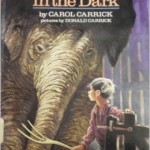
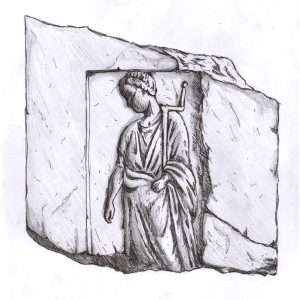
''We do know, however, that such keys were in use from very ancient times. In Homer we hear of them: “…she climbed the high stairway to her chamber, and took the bent key in her strong hand, a goodly key of bronze, and on it was a handle of ivory...”
Refresher: "Cassiopeia is one of the oldest and popularly best known of our constellations, and her throne; ''the shinie Casseiopeia's chair'' of Spencer Faerie Queen, is a familiar object to the most youthful observer. It is also known as the Celestial 'W' when below the pole, and the Celestial 'M' when above it...Hyginus describes the figure as the Queen ''bound to her seat'' and thus secured when going around the pole - head downward- as a lesson selected by her 'enemies' {i.e., negative aspects?}, the sea-nymphs - as a lesson in humility...Known by the Greeks as 'She of the Throne' but at one time in Greece it was the Laconian Key: 'A brazen key she held, the handle turned, with steel and polished elephant adorned' {Homer}.
Any link to: ''the Chair of Lethe {of forgetfulness}, : ''that welds itself to the flesh, from which one cannot rise."
Cepheus ?
Cersei Lannister? {Game of Thrones}.
''In Greek sanctuaries, the collective performances of rituals took place around an outdoor altar. As temples housed the images of deities, the temple door allowed the passage from one realm to another, from the profane space to the sacred. The door to the naos with the cult statue meant metaphorically the access to the presence of the god. A krater dating to the 4th century BCE from Taranto depicts the statue of Apollo in a temple, seen through the open doors.''
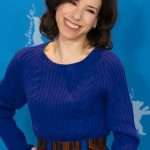
Bluestar?
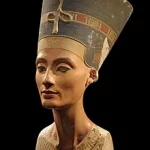
Noble women?
''Temples were, therefore, not always accessible for all worshippers. In some cases, only cultic officials were permitted entry. Some temples were open every day, and some only on certain days of the year.8 Locking and unlocking the temple door was the responsibility of either one or several cultic officials with the key signifying restricted access and custodianship. The key itself was entrusted to officials in their role as custodians of the temples. Valuable votives and money deposited in temples increased the responsibility of key-holders. For this reason, the temple key could only be entrusted to somebody of high social and cultic status. Most of the inscriptions about key-holders emphasize the noble background of key-holders. Therefore, we do not have evidence that the key-holders of most Greek sanctuaries were of noble background.''
''The key-holders of temples have a long tradition going back to the Mycenaean period. The Linear B tablets from Pylos dating to the second half of the 2nd millennium BCE mention cultic officials who had the title ka-ra-wi-po-ro (key-bearer). Another question is whether there is a continuity of perpetuating the conception of key-holders of Greek temples....So far, there are only very few studies on key-holders, which were mainly focused on the analysis of the iconographic material. Mantis made the first accurate analysis of the iconographic material on key-holders.9 One part of the iconographic material was also analysed by Dillon, Connelly, Kaltsas, and Shapiro.10 A significant number of vases and grave stelai dating to the Classical and Hellenistic periods depict temple keys or women holding a temple key. Most of the vases show mythical figures as key-holders, whereas the grave stelai honour women who served presumably as priestesses. I will only give an overview of the iconographic material on key-holders.''
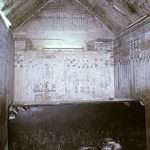

Wearing one?
Side note: ''With the passing of Menkaure there seems to have been some sort of rebellion and power passed to a new dynasty of pharaohs, three of whom were said to have been the 'triplet' sons of a priestess from Heliopolis. These pharaohs of the 'FIFTH' Dynasty seem to have been content to build much smaller pyramids than their forebears which became little more than rubble heaps. Unas, the last pharaoh of the Dynasty, however, had his pyramid raised where it all began - at Saqqara - close to the pharaoh Djoser, where his priests {male?} came up with a radical idea to have the INSIDE WALLS of his 'burial chamber inscribed with hieroglyphs.'' [Page 89 'Magi: The Quest for a Secret Tradition'].
'Rebel'.
INNER/OUTER. MALE/FEMALE.
Beaker People to enlarge {i.e., from a different perspective}.
'Peristyle'.
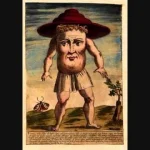
Blemmyes. Copy cats?
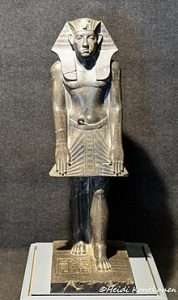
Fire or water?
Continued: ''Bremmer states that being a doorkeeper was not highly regarded, and it is surprising that the Horai, represented as young girls were doorkeepers, as it was considered to be inappropriate for young women to open the door for strangers. Bremmer considers various tasks, such as those of doorkeepers, as a “kind of initiatory status reversal” for divine girls before becoming a lady. The key-holders of Hecate at Lagina were young girls.''
Refresher: ''The siren heralds a friend, the bee a stranger.''
Question. Whats the common factor between the two i.e., 'worker bees' and 'siren'?
''Truth is stranger than fiction.''
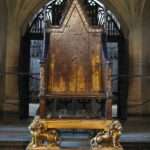
For a male or female?
Continued: ''As mistresses of the household, women held the keys of their houses. According to Hesychius, women are kleidouchoi, as they get the keys of the house (s.v. κλῃδοῦχος). This means that the bride received the key from her future husband after the wedding when she entered the house of her groom.27 In the event of a divorce, the woman had to give back the keys.28 Festus mentions that it was a custom to give women a key as a symbol for an easy delivery.29 Women were not only key-holders of their households, but also as priestesses of temples.''
Hestia?
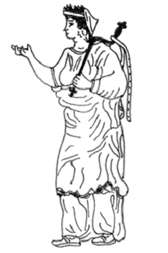
left shoulder?
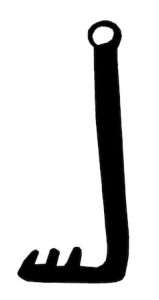
Where have you seen it before?
And/or: ''Temple locks, or Laconian locks, consisted of a wooden bolt on guides on the inside of the door. Through a hole in the door, a person on the outside could slide the bolt back to open position using a very angular tool (key) of bronze or iron. To lock it again, a thin rope or leather strap pulled the bolt into the staples in the door frame. Ancient Greek door locks were used from the seventh century BC in Greece and were named after finds in Laconia in the southern part of Peloponnesus in Greece.''
''Several Linear B tablets from Pylos and 110 inscriptions dating to the Hellenistic, Roman, and Imperial periods provide evidence for cultic officials as key-holders. Numerous grave stelai and vase paintings depict mortal and mythical figures holding the so-called temple key that served as an iconographic insignia of female priests. Studies in the past were primarily focused on the iconographic material. The present paper covers a whole range of epigraphic sources, which give insight into the procedure for appointment to cultic offices of key-holders, their tasks, and social background.''
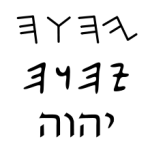 Side note: ''But on the fourth Way knowledge is still more exact and perfect.....It must be noted that in addition to the legitimate ways, there are also artificial ways which give temporary results only....It also happens that the door to the fourth room is opened artificially with a skeleton key. And in both these cases the room may prove to be empty.'' [Pages 1069/1076 {Kindle} 'In Search of the Miraculous' / P.D. Ouspensky].
Side note: ''But on the fourth Way knowledge is still more exact and perfect.....It must be noted that in addition to the legitimate ways, there are also artificial ways which give temporary results only....It also happens that the door to the fourth room is opened artificially with a skeleton key. And in both these cases the room may prove to be empty.'' [Pages 1069/1076 {Kindle} 'In Search of the Miraculous' / P.D. Ouspensky].
And/or: Breaking the fourth wall intentionally violates the barrier between actor and audience. To break the fourth wall, an actor acknowledges the audience and typically (though not always) addresses them.....
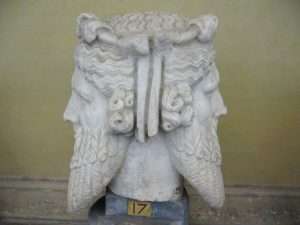
Past /Present. Inward / Outward. Foresight/Hindsight.
Top of Karnac to enlarge.

“Most certainly, I tell you, one who doesn’t enter by the door into the sheep fold, but climbs up some other way, is a thief and a robber."
In the world of performing arts, there exists an invisible barrier known as the “fourth wall.” It’s an imaginary boundary that separates the actors on stage or screen from the audience. This unspoken agreement has been a fundamental aspect of theater and film for centuries. However, some actors possess a unique ability to transcend this barrier and create a powerful connection with the audience. In this article, we will explore how actors break down the fourth wall and examine the profound impact they have on audience engagement.....The concept of the fourth wall dates back to the 18th century, primarily in the context of theater. Playwrights and actors agreed that there was an imaginary wall between them and the audience. This wall was never to be broken, and the actors were to remain immersed in their roles, pretending that the audience did not exist.

One of the two Griffins facing the Throne of Minos.
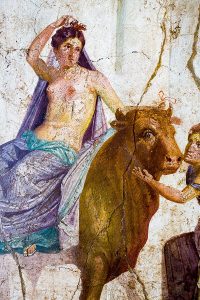 The term “fourth wall” itself is attributed to the French philosopher Denis Diderot, who wrote about it in his essay “Paradox of the Actor” in 1757. Diderot argued that actors should behave as if they were playing to an unseen audience, creating a sense of realism in their performances....
The term “fourth wall” itself is attributed to the French philosopher Denis Diderot, who wrote about it in his essay “Paradox of the Actor” in 1757. Diderot argued that actors should behave as if they were playing to an unseen audience, creating a sense of realism in their performances....
From a different perspective: "What especially prevent a man from seeing contradictions in himself are buffers. In place of having Real Conscience a man has Artificial Conscience and buffers.
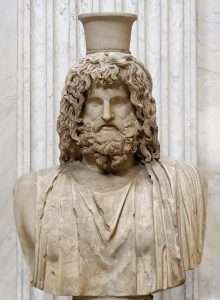
"Head Jar"? All 'four' sides?
Behind everyone there stand years and years of a wrong and stupid life, of indulgence in every kind of weakness, of sleep, of ignorance, of pretence, of lack of effort, of drifting, of shutting one’s eyes, of striving to avoid unpleasant facts, of constant lying to oneself, of abuse and blaming of others, of fault-finding, of self-justifying, of emptiness, of wrong talking, and so on. As a result the human machine is dirty and works wrongly. Not only this, but artificial appliances have been created in it due to its wrong way of working. And however a person may wish to wake up and become another person and lead another life these artificial appliances interfere very much with his good intentions. They are called Buffers. Like the contrivances on railway carriages, their action is to lessen the shock of collision. But in the case of buffers in man their action is to prevent two contradictory sides of himself from coming into consciousness together.....
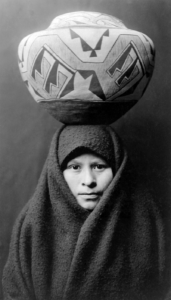
'Balance'?
And/or: "A life governed by the principles of Karma Yoga differs greatly from an ordinary life. In ordinary life, no matter what the conditions may be, the chief aim of Man consists in avoiding all unpleasantnesses, difficulties and discomforts, so far as this is possible. In a life governed by the principles of Karma Yoga, a man does not seek to avoid unpleasantnesses or discomforts. On the contrary, he welcomes them, for they afford him a chance of overcoming them.
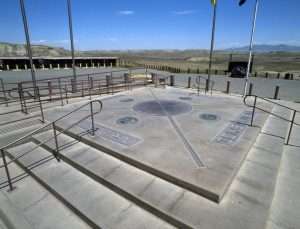
"Four Corners Monument, marking the only spot in the United States where four states (Arizona, Utah, Colorado, and New Mexico) come together."
From the point of view of Karma Yoga, if life offered no difficulties it would be necessary to create them artificially. And therefore the difficulties which are met with in life are regarded not as something unpleasant which one must try to avoid, but as very useful conditions for the aims of inner work and inner development....
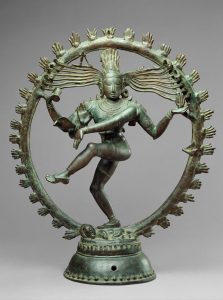
''The four armed dancing god Shiva; at the bottom, the bull Nandi.
Now as regards the question: “Which self must i remember when i try to remember myself?” First, remember the self or ‘I’ that knows what your aim is. This brings all the ‘l’s in you that wish to awaken into consciousness. Second, there is such a thing as real ‘I’ in us. But we are always being what we are not, substituting one ‘I’ after another in place of the place of real ‘I’ that we have access to. Trying to feel the pure feeling of ‘I’ doing this, ‘Il’ saying this, ‘I’ sitting here, ‘I’ being negative, and soon, can become sometimes a form of Self-Remembering. Full Self-Remembering is consciousness of real ‘I’ which stands above all the ‘I’s artificially created by life in us.

Alex Aronson considered Shakespeare's Puck a representation of the unconscious mind and a contrast to Theseus as a representation of the conscious mind.
Finally, no one can remember himself unless he feels that there is something higher than himself. Unless he feels this, his Self-Remembering will always lead him into False Personality. Many other things could be said about the First Conscious Shock, which has many sides to it {all 'four' sides?}, but enough has been given for discussion and questions. But you must all keep to the paper in your discussion and this will be an exercise in Self-Remembering for you." {'Psychological Commentaries on Gurdjieff and Ouspensky' / M. Nicoll}.
Refresher: The medium (that is the astro-mental sheath) in its natural state is volatile, immanifest, fantastic, irrational and impotent, compared with what it subsequently is able and by artificial conception suffers itself to become. The Alchemists, we repeat therefore, did not remain satisfied with a few passes of the hand or any first phenomena whatever, but they proceeded at once scientifically to purify, depriving the ether of its wild affections and impressures by a dissolution of the circulating body in its own blood. For this is the brazen Wall celebrated by Antiquity. Take the occult Nature, which is our Brass, says Albertus, and wash it that it may be pure and clean. ['The Philosophers Stone'].
Recall Alexander's Adventure {India?} - where he comes upon a brass wall between two mountains?
''Service to others is the rent you pay for your room in heaven.'' {Muhammad Ali: 1942-2016}.

"The Foundation Stone in the floor of the Dome of the Rock shrine in Jerusalem. The round hole at upper left penetrates to the Well of Souls below. The cage-like structure just beyond the hole covers the stairway entrance of sixteen steps to the cave below."
'Sixteen' to enlarge.
 AND/OR 'Even as a folding door, fitted within with key; is thrown back when the bolts are drawn' {Aratos}. [Page 142/3 'Star Names and Their Meaning']. Try ''Melusine'' {Part 3} - as a means...?
AND/OR 'Even as a folding door, fitted within with key; is thrown back when the bolts are drawn' {Aratos}. [Page 142/3 'Star Names and Their Meaning']. Try ''Melusine'' {Part 3} - as a means...?
''W'' in relation to yhWh? And/or Horus IN/OF the horizon. And/or copper latch {bolt?} in ascending passage?
Side note: ''A Babylonian cuneiform text calls Sirius Kak-si-di, which means 'shining like copper', and Homer's epic The Iliad compares Achilles copper shield to the star...Copper handles found in the Queens Chamber - aligning with Sirius.'' [Page 276 'The Orion Zone' ].
REFRESHER: "In Latin a pearl was 'unio', because, as Pliny writes, it is 'the unique gem', or because pearls are only found singly...Oysters open and shut, like doors [folding doors in English were once called 'bivalves'], and the open shell of an oyster looks like the number 8." [Quote from the Lexicon chapter to the book ' The Book of Babel: Words and the Way We See Things' by N.Lewis].
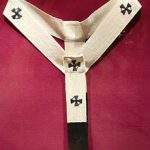
'Hung'?
 Side note: ''A supernova became visible on the North American continent { 'twentythree' countries} in the early morning of July 5th 1054AD {near Aldebaran in Taurus}. It hung diagonally above the crescent moon - just above the eastern horizon... The violent death of a star....It became known as the Crab Nebula {Cancer?}...It is also known as M-1, the first object in Charles Messier's catalogue...On the evening of July 4th it was visible in the eastern sky over China...In the Sung Dynasty it was referred to as 'guest star'....signifying either disaster or triumph...''T'ien-kuan'' was the name the Chinese called the area between the horns of Taurus - it was considered the 'Gate of Heaven'....Two accounts from China and Japan stated it remained visible {at high noon} for twentythree days.'' [Page 91 'The Orion Zone' / G. A. David].
Side note: ''A supernova became visible on the North American continent { 'twentythree' countries} in the early morning of July 5th 1054AD {near Aldebaran in Taurus}. It hung diagonally above the crescent moon - just above the eastern horizon... The violent death of a star....It became known as the Crab Nebula {Cancer?}...It is also known as M-1, the first object in Charles Messier's catalogue...On the evening of July 4th it was visible in the eastern sky over China...In the Sung Dynasty it was referred to as 'guest star'....signifying either disaster or triumph...''T'ien-kuan'' was the name the Chinese called the area between the horns of Taurus - it was considered the 'Gate of Heaven'....Two accounts from China and Japan stated it remained visible {at high noon} for twentythree days.'' [Page 91 'The Orion Zone' / G. A. David].
Side note: ''Pawn Stars employee Austin “Chumlee” Russell was recently featured on the hit TV show talking to an individual, who attempted to sell LeBron James high school mouthpiece. The seller was very confident that it was from one of his games at St. Vincent-St. Mary in Akron, Ohio....The mouthguard had ‘King James’ on it along with ‘Gloria’ and ’twentythree.’.......Since High School, his nickname has been ‘King James.’ Also, his jersey number since that time has been 23, as he idolized Michael Jordan, and his mother’s name is Gloria.'' ['The Capital Sports Report'].
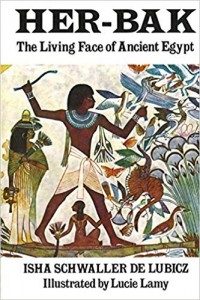
''Enemies''?

Straight lines and curves. 90/180?
Continued: "Cassiopeia is one of the oldest and popularly best known of our constellations, and her throne; ''the shinie Casseiopeia's chair'' of Spencer Faerie Queen, is a familiar object to the most youthful observer. It is also known as the Celestial 'W' when below the pole, and the Celestial 'M' when above it...Hyginus describes the figure as the Queen ''bound to her seat'' and thus secured when going around the pole - head downward- as a lesson selected by her 'enemies' {i.e., negative aspects}, the sea-nymphs - as a lesson in humility...Known by the Greeks as 'She of the Throne' but at one time in Greece it was the Laconian Key: 'A brazen key she held, the handle turned, with steel and polished elephant adorned' {Homer}. AND/OR 'Even as a folding door, fitted within with key; is thrown back when the bolts are drawn' {Aratos}. [Page 142/3 'Star Names and Their Meaning'].
A practical example: ''At his 1999 State of Union Address, Bill Clinton said of Rosa Parks jokingly {who was in the audience} - ''She may get up or not, as she chooses.'' ['The Chase'].
Recall ''Peter'' who was also put into a certain 'position' by his 'enemies'.
A working example: {i.e., something hinted at}: ''Nora stated the purpose of her visit: I was in need of a cook. She was ready to step into the breach....She would light a fire in the library if i liked....'It was Grandma's suggestion,' she said. Mrs {M}altravers - the wise woman...'' [Page 84 'Mercurius' /P. Harpur].
Spirit leading to soul. Interchanging 'both' with the two main characters of Smith and Eileen. 'Clouds' within a void - as a reference within that transition. All within his personal Alchemical vessel - which he calls his ''double pelican'' {shape of a 'woman'}.
Janet in relation to Mrs B and Nora = synchronistic aspects of 'soul'. As a means...?
{To tell a story}?
Try ''deluge'' and/or ''flood''.
And/or: ''The ba was called the heart soul and the khu was called the spirit soul. In the ideograms the bird image of the ba exhibits a radiant plume {green or blue?} emerging from the back of the head. These represented the difference between the double soul of the Divine Heart and the soul of the Divine Intelligence. The ba appears on the earth as the khu appears in heaven.....The double souls of Ra numbered fourteen, likened to the fourteen ka's of Osiris....The god Baba, whose name means 'double soul' was said to be the soul of Osiris manifested as his son Horus.'' [Pages 239/40 'Dreams of Isis' / N. Ellis].
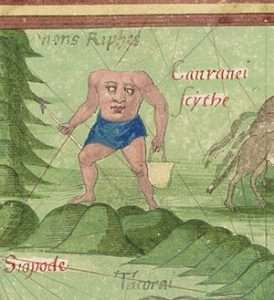
''Fifteen headless falcons found alongside eggs - at the ancient port of Berenike - in the Eastern Desert..'' AND/OR: Good egg is a friendly, old-fashioned way to talk about a good guy or a kind person.
 ''Ancient spiritual traditions link the khu with the crown chakra, or pineal gland located at the tip of the brain....it was said to preexist the creation of the world and to be, simultaneously, the final goal of transformed matter {'crocodile'?}.....The khu is depicted as the crested ibis standing before a star- a spark of genius or shining brilliance and/or the divine spark. Represented with its dark green iridescent plumage {drake duck head?}....that seemed to glitter with metallic sparks.'' [Page 246].
''Ancient spiritual traditions link the khu with the crown chakra, or pineal gland located at the tip of the brain....it was said to preexist the creation of the world and to be, simultaneously, the final goal of transformed matter {'crocodile'?}.....The khu is depicted as the crested ibis standing before a star- a spark of genius or shining brilliance and/or the divine spark. Represented with its dark green iridescent plumage {drake duck head?}....that seemed to glitter with metallic sparks.'' [Page 246].
'Crowned Crane'?
Side note: ''Berenice Troglodytica, also called Berenike (Greek: Βερενίκη) or Baranis, is an ancient seaport of Egypt on the western shore of the Red Sea. It is situated about 825 km south of Suez, 260 km east of Aswan in Upper Egypt and 140 km south of Marsa Alam.[2] It was founded in 275 BCE by Ptolemy II Philadelphus (285–246 BCE), who named it after his mother, Berenice I of Egypt.[3]
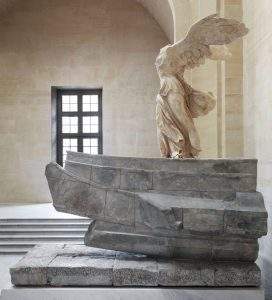
In flight?
A high mountain range runs along the African coast and separates the Nile Valley from the Red Sea; Berenice was sited upon a narrow rim of shore between the mountains and the Red Sea, at the head of the Sinus Immundus,[4] a south-facing bay sheltered on the north by a high peninsula then called Lepte Extrema, and to the south by a chain of small islands scattered across the mouth of the bay. One of them was called the Island of Ophiodes (Ὀφιώδης νήσος[4][5]) and was one of a few sources of gemstones local to Berenice. The harbour is marginal, but was improved by engineering.''
''The name Troglodytica refers to the native people of the region, the "Troglodytai" or "cave dwellers". Although the name is attested by several ancient writers, the more ancient Ptolemaic inscriptions read Trogodytai, which Huntingford (1980)[6] speculated could be derived from the same root as Tuareg. It is possible that later copyists confused this name with the more common term Troglodytai.''
Berenike: a female given name: from a Greek word meaning “bringer of victory”

Ethnic cleansing? Were they all Hamas supporters? History repeating itself? What would Yahweh say? Leading by example? Question. Whats the difference between a tribe of Jews and/or a tribe of Hebrews? Who were the Israelites?

Political or spiritual? Is he taking Israel up or down a path? Is everybody an "antisemite" if they disagree?
"The Tuareg people (/ˈtwɑːrɛɡ/; also spelled Twareg or Touareg; endonym: Imuhaɣ/Imušaɣ/Imašeɣăn/Imajeɣăn[9]) are a large Berber ethnic group that principally inhabit the Sahara in a vast area stretching from far southwestern Libya to southern Algeria, Niger, Mali, and Burkina Faso.[10] Traditionally nomadic pastoralists, small groups of Tuareg are also found in northern Nigeria The Tuareg speak languages of the same name, also known as Tamasheq, which belong to the Berber branch of the Afroasiatic family."
There is no consensus as to when Proto-Afroasiatic was spoken.[46] The absolute latest date for when Proto-Afroasiatic could have been extant is c. 4000 BCE, after which Egyptian and the Semitic languages are firmly attested. However, in all likelihood these languages began to diverge well before this hard boundary.[68] The estimations offered by scholars as to when Proto-Afroasiatic was spoken vary widely, ranging from 18,000 BCE to 8,000 BCE.[46] An estimate at the youngest end of this range still makes Afroasiatic the oldest proven language family.[8] Contrasting proposals of an early emergence, Tom Güldemann has argued that less time may have been required for the divergence than is usually assumed, as it is possible for a language to rapidly restructure due to areal contact, with the evolution of Chadic (and likely also Omotic) serving as pertinent examples
Side step: Practical analogy..."Got to see it, rather than just read it..." John Humphrys talking to D. Tennant and Greg Doran in relation to the plays by W. Shakespeare. [400th anniversary. Radio 4. 23/04/16].

Common factors?
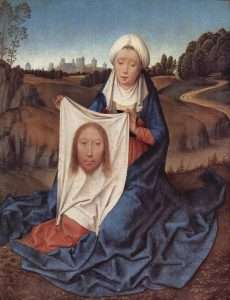 Saint Veronica, also known as Berenike,[3] was a widow from Jerusalem who lived in the 1st century AD, according to extra-biblical Christian sacred tradition.[4] A celebrated saint in many pious Christian countries, the 17th-century Acta Sanctorum published by the Bollandists listed her feast under July 12,[5] but the German Jesuit scholar Joseph Braun cited her commemoration in Festi Marianni on 13 January....According to Church tradition, Veronica was moved with sympathy seeing Jesus carrying the cross to Calvary and gave him her veil so that he could wipe his forehead. Jesus accepted the offer, and when he returned the veil the image of his face was miraculously captured on it. The resulting relic became known as the Veil of Veronica.[6][7][8]
Saint Veronica, also known as Berenike,[3] was a widow from Jerusalem who lived in the 1st century AD, according to extra-biblical Christian sacred tradition.[4] A celebrated saint in many pious Christian countries, the 17th-century Acta Sanctorum published by the Bollandists listed her feast under July 12,[5] but the German Jesuit scholar Joseph Braun cited her commemoration in Festi Marianni on 13 January....According to Church tradition, Veronica was moved with sympathy seeing Jesus carrying the cross to Calvary and gave him her veil so that he could wipe his forehead. Jesus accepted the offer, and when he returned the veil the image of his face was miraculously captured on it. The resulting relic became known as the Veil of Veronica.[6][7][8]
The story of Veronica is celebrated in the sixth Station of the Cross in Anglican, Catholic, and Western Orthodox churches.[4][9][10]
Eusebius in his Historia Ecclesiastica (vii 18) tells how at Caesarea Philippi lived the woman whom Christ healed of an issue of blood (Matthew 9:20–22). Legend was not long in providing the woman of the Gospel with a name. In the West she was identified with Martha of Bethany; in the East she was called Berenike, or Beronike, the name appearing in as early a work as the "Acta Pilati", the most ancient form of which goes back to the fourth century. The fanciful derivation of the name Veronica from the words Vera Icon (eikon) "true image" dates back to the "Otia Imperialia" (iii 25) of Gervase of Tilbury (fl. 1211), who says: "Est ergo Veronica pictura Domini vera" (translated: "The Veronica is, therefore, a true picture of the Lord.")
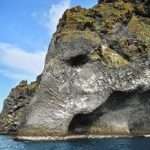
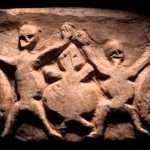 From a different perspective: "Heart mine in the house of hearts, heart mine be with me in the house of hearts. My heart {'soul'?} is peaceful for me. I do not eat the cakes of Asar {'fire' link? i.e., therefore 'spirit'} in the eastern lake, the boat sailing downstream or upstream. I do not go into the boat with you. It is I with my mouth and my words with my two legs for walking, and with my two arms for pulling down the enemies. Opened for me are the doors of heaven. Geb, the chief of the gods and goddesses, has unbolted his jaws for me. My eyes which were blinded, are opened and my legs stretch out freely. They are firmed up {therefore 'strong legs'?} by the god Anpu - extending as goddess Sekhmet'' {Spirit/soul coming together; as a means}? Hence: "I am in heaven doing my will in the house of the Ka of Ptah. I know my heart {i.e., I know who I am}. I am powerful - in my legs and arms and in actions {static/dynamic? and/or 'shoulders'?}, which are desired by my Ka. My soul and body are not restricted at the portals of Amentet, in my going in, in peace, and coming out in peace....The 'iab' or heart is the mind of the person, and an aspect of the ego personality...to know the heart is to know the innermost Self. Like the fortytwo injunctions of Maat..."
From a different perspective: "Heart mine in the house of hearts, heart mine be with me in the house of hearts. My heart {'soul'?} is peaceful for me. I do not eat the cakes of Asar {'fire' link? i.e., therefore 'spirit'} in the eastern lake, the boat sailing downstream or upstream. I do not go into the boat with you. It is I with my mouth and my words with my two legs for walking, and with my two arms for pulling down the enemies. Opened for me are the doors of heaven. Geb, the chief of the gods and goddesses, has unbolted his jaws for me. My eyes which were blinded, are opened and my legs stretch out freely. They are firmed up {therefore 'strong legs'?} by the god Anpu - extending as goddess Sekhmet'' {Spirit/soul coming together; as a means}? Hence: "I am in heaven doing my will in the house of the Ka of Ptah. I know my heart {i.e., I know who I am}. I am powerful - in my legs and arms and in actions {static/dynamic? and/or 'shoulders'?}, which are desired by my Ka. My soul and body are not restricted at the portals of Amentet, in my going in, in peace, and coming out in peace....The 'iab' or heart is the mind of the person, and an aspect of the ego personality...to know the heart is to know the innermost Self. Like the fortytwo injunctions of Maat..."
Spirit/soul {'fired'/UNfired} in relation to: "Gudea made offerings of honey and butter when the foundations were laid; when the building was finished an auspicious day was waited for, and when it came the image of the god was removed to the new temple, and Gudea sprinkled the ground with oil, and set out offerings of honey, butter, wine and dates, grain mixed with milk, food untouched by 'fire', for the gods." [ Chapter 3, 'The Sacred Bee'].
Side note: '' {42} Fortytwo inches is the maximum allowable length of a baseball bat.'' ['The Chase' / S15 EP149].


"Behind Will, stands desire." Remembering or forgetting?
Continued: ''Chapter 26 {the author M. Ashby defines it as chapter 13}, relates to affirming self control. Once again there is a negative reference to the east, the eating of 'cakes' - on the eastern side of the lake of flowers - symbolic of desires and thoughts of worldly life; and reincarnation because they have not been able to remember the Self....the heart is a metaphor for the mind, when the mind is overpowered by negative or unrighteousness i.e., lying, cheating, neg. behaviour, hypocrisy etc. - it is not able to envisage the 'higher' reality of the spirit....therefore enslaving the 'soul'....This reference relates to the understanding of life as related by the journey of Ra {'spirit'}. Every day 'Ra' in the form of the sun disc is metaphorically consumed by Nut {'soul'} and she gives birth to him every morning. THEREFORE the east represents rebirth, the new life or the process of reincarnation. Reincarnation implies having to once again being born into the world of time and space, to suffer the limitations of youth etc.....it is to be understood as a separation from 'divine' consciousness...." [Page 214 of the book by M. Ashby].
WEST?
Try ''Mr Jones'' {5:9} to enlarge in the practical sense of the word. At the very least you begin to 'see' what ''reincarnation'' means to that mind set - BEFORE those two bigger questions are asked.
For something further try ''flower'' {'finger'} and/or ''cake'' {scones?} to assimilate it. The parts within the whole.
And/or: Recall the 'portal' in the ascending passage {Gt. Pyramid} that was BOLTED. Recall all the negative aspects associated with Khufu {i.e., prostitutes for 'daughters' to 'name' but one - if only in the mythological SENSE of the word i.e., as a means...}.

Which {one?} 'drinks' from the stream?

From a different perspective {synchronistic}: The Lutheran church {having as its facade the same form as above} is now a boxing gym. "This has just done my head in because everything always comes full circle but never in such a poetic way as this. I feel so joyful, I couldn't have been more delighted by this whole thing." Sue Perkins' episode of Who Do You Think You Are / BBC2.
"What is music? What is Poetry? What is mythology? All questions on which no opinion is possible unless one already has a real feeling for these things. That is natural and obvious enough. Not so, however, our feeling in the case of the last named. Only the greatest creations of mythology proper could hope to make clear to modern man that here he is face to face with a 'phenomenon' which in ''profundity, permanence, and universality is comparable with nature herself''. If we want to promote a real knowledge of mythology, we must not appeal at the outset to theoretical considerations and judgements {not even to Schelling's, from whom the quotation in praise of mythology comes}. Neither should we talk over much of ''sources'' {instead} - the water must be fetched and drunk fresh from the spring if it is to flow through us and quicken {'distillation'?} our hidden mythological talents." ['Science of Mythology' / C.G Jung and C.Kerenyi].
''The fish with glittering tails'' {Page 15 'The Origin of the Zodiac' / R. Gleadow.
Singular / plural as a means....?
A beginning or end? A beginning or end of what? Archetypes? Something 'fished' from the stream?
A fisherman's 'friend' or stranger?
''Peculiar''?

A 'belly' full of something?
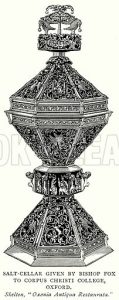
Salt-Cellar given by Bishop Fox to Corpus Christi College, Oxford. Illustration from A Short History of the English People by J R Green (Macmillan, 1892).
And/or: ''The slightest wavering, the slightest turning back in thought to that sense world on which the disciple has turned his back, will energize anew the desires which he is striving to abandon, and as the tension increases in his desire nature {what some psychologists term the unconsciousness} they will burst out in a great flash of anger utterly devastating to his spiritual progress, shattering his inner perception and causing a loss of those ''memories'' by which he hoped to mount...'' Try ''belly'' and/or 4:6 for more examples of ''striving''.
Lot's Wife? {he escaped with daughters}.
Question. If the pyramid was built FOR Khufu was he aware of that ''bolted'' passageway. Or was it put in without his knowledge {spite?} to inform the outside world {who could decipher such 'hints'} at a later date?
The Gang of Khufu? {or their 'overseer'?}.
And/or: "As i heard my Sioux name being called over and over, i then knew for the very first time who i was..." ['Dances with Wolves' / K. Costner].
Refresher: "We don't know the purpose of the white quartz pebbles. There found in mortuary context from pre-historic periods onward and also medieval cemeteries. There's a passage in the Bible - Revelations- about a person who has found Christ is given a white stone - and in that - a new name." Try ''nickname'' / ''quartz''.
Try ''Pineal gland'' to enlarge.

Zoroastrian Tower of Silence. Inner = children. Outer = males. 'Middle' = women.

Astro ceiling in Senenmut bare tomb chamber. 'Folded'?
REFRESHER: ''Hatshepsut had her tomb dug in the Valley of the Kings (KV 20) by her vizier and High Priest of Amun, Hapuseneb. She had previously had a tomb cut for herself as queen regent under Tuthmosis II, its entrance 220 ft (72 m) up a 350-ft (91-m) cliff face in a remote valley west of the Valley of the Kings. This was found by local people in 1916 and investigated by Howard Carter in rather dangerous circumstances. The tomb had never been used and still held the sandstone sarcophagus inscribed for the queen. Carter wrote: 'as a king, it was clearly necessary for her to have her tomb in The Valley like all other kings - as a matter of fact I found it there myself in 1903 - and the present tomb was abandoned. She would have been better advised to hold to her original plan. In this secret spot her mummy would have had a reasonable chance of avoiding disturbance: in The Valley it had none. A king she would be, and a king's fate she shared.'
White stone /Red stone?
''Hatshepsut's second tomb was located at the foot of the cliffs in the eastern corner of the Valley of the Kings. The original intention seems to have been for a passage to be driven through the rock to locate the burial chamber under the sanctuary of the queen's temple on the other side of the cliffs. In the event, bad rock was struck and the tomb's plan takes a great U-turn back on itself to a burial chamber that contained two yellow quartzite sarcophagi, one inscribed for Tuthmosis I and the other for Hatshepsut as king (p. 101). The queen's mummy has never been identified, although it has been suggested that a female mummy rediscovered in 1991 in KV 21 (the tomb of Hatshepsut's nurse) might have been her body.''
From a different perspective: ''Being in low spirits i decided to visit Robert. Half-way up the hill i turned back. His company is a temptation; its too congenial. I was using him as an excuse to shirk my duties....Tonight i walked out by the light of a huge yellow moon to Nightingale Wood, seeking some balm for the SOUL....'' [Page 107 'Mercurius'].
Question. What is Balm made from?
Camphor link?
And/or: ''Spring..a time to awake and get up....Nightingales are singing....to cut the knot into which life has tied itself.''; [Page 58/9 'Russia: Past, Present and Future' / R. Steiner].
Gordian to enlarge.

REFRESHER: ’'A symbol is an energy-evoking and direct agent’'. [ J. Campbell. ’Flight of the Wild Gander’. Chapter five. Part seven]. And/or: "Energy is the measurable expression of the revolt of spirit against its imprisonment in matter." ['Serpent in the Sky' / J. West].

Whats the common form that is inscribed? 'Pyr'amid and Nasca Lines to enlarge.
Continued: Something hinted at: "This is the next stunning place along the way...and it is a way, an energy thread marked by these sites which require something different from you - before they let you pass on to the next. Barnhouse village was discovered in 1984 by archaeologist, Dr Colin Richards. Centuries of agriculture meant little remained of the site but the excavations uncovered 15 round dwellings, probably with timber and turf roofs and turf cladding on the outer walls. It was free standing rather than encased in its own midden as Skara Brae is. Intriguingly, each building seems to have been deliberately demolished at the end of its life...It was built after all the other buildings had been abandoned {decommissioned?}...A massive hall like structure...built on a platform of yellow clay...They also found a complete Grooved Ware pot set into the clay floor by the eastern wall which contained a treasure hoard of 14 flint nodules - flint was very scarce in Orkney." ['Elen of the Ways' ].
Use that sum result {15?} to take that overall information further. Try ''14'' and/or 'Aquarius'.
Side note. The 'upper' chamber in the Gt. Pyramid was also 'free standing'.
And/or: A clay pot found in the lowest regions {'pit'} of none other than the Step Pyramid.
Question. What does a 'vase' represent?
Vase + 'flint' in relation to 'fire'? As a means...

''Closeup of the deified Hare nome (the 15th of Upper Egypt) from the triad statue of pharaoh Menkaure, hathor and the Hare nome goddess. Greywache, from Menkaure's Valley Temple at Giza, Reign of Menkaure, 4th Dynasty, Old Kingdom.'' 'Man in the Moon'?
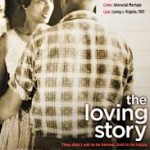 "There is a very interesting book by Dr M. Harding called 'Woman's Mysteries Ancient and Modern'. In it is an immense amount of information which should set the readers subconscious mind questing to and fro on a scent which grows warmer and warmer until Chapter 15 is reached. What Chapter 15 means to you will depend entirely upon what you are. It is true this work deals almost entirely with the Moon Mysteries, but, a mans immediate inner self - his anima - is feminine...whereas in this state of cosmic matrimony...for a woman that would be her animus; not anima; if Jung is correct." [Chapter 5, 'The Forgotten Mage'. Mentioned elsewhere]. Understanding what is implied by this author defines what 'fifteen' represents within this subject. The 'end' result of a 'process' = the beginnings of another. Clue. ''Sacred marriage'' link.
"There is a very interesting book by Dr M. Harding called 'Woman's Mysteries Ancient and Modern'. In it is an immense amount of information which should set the readers subconscious mind questing to and fro on a scent which grows warmer and warmer until Chapter 15 is reached. What Chapter 15 means to you will depend entirely upon what you are. It is true this work deals almost entirely with the Moon Mysteries, but, a mans immediate inner self - his anima - is feminine...whereas in this state of cosmic matrimony...for a woman that would be her animus; not anima; if Jung is correct." [Chapter 5, 'The Forgotten Mage'. Mentioned elsewhere]. Understanding what is implied by this author defines what 'fifteen' represents within this subject. The 'end' result of a 'process' = the beginnings of another. Clue. ''Sacred marriage'' link.
Side note. ''...matrimony'' in relation to 'Bed Burials' ? Enlarged elsewhere.
From a different perspective {i.e., something hinted at}: "The origins of Merlin may be traced to the prehistoric past where the primal prophet and a youthful god of poetry and inspiration {similar in many ways to the 'young' Apollo} were originally identical. Humans mediated the poetic prophetic power; such individuals were both the inspirers and the conscious bearers of a community, a clan, a race and its land. Curiously, to the modern mind, we find that women mediated the god-power of prophecy, in the ancient world - while men mediated the goddess-power." ['The Way of Merlin' / R. J. Stewart].
N.B. The 15th King of Copan {'Holy' Kings} whose name = 'Fire is the Strength of the Sky God'. Question. 'Fire' ?

Mad march hare?

Hare in the Moon?
Side note: ''The Hare nome, also called the Hermopolite nome (Egyptian: Wenet) was one of the 'fortytwo' nomoi (administrative divisions) in ancient Egypt; more precisely, it was the 15th nome of Upper Egypt....The Hare nome's main city was Khemenu (later Hermopolis Magna, and the modern el-Ashmunein) in Middle Egypt. The local main deity was Thoth, though the inscriptions on the White Chapel of Senusret I links this nome with the cult of Bes and Unut....The Hare nome was already recognized during the 4th Dynasty of the Old Kingdom as shown by the triad statue of pharaohMenkaure, Hathor, and an anthropomorphized-deified depiction of the nome.[1] It is known that during the 6th Dynasty its nomarchs were buried in the necropolis of El-Sheikh Sa'id....The nome kept its importance during the First Intermediate Period and the subsequent Middle Kingdom; its governors were also responsible of the alabaster quarrying at Hatnub in the Eastern Desert, they owned exclusive offices such as "director of the double throne" and great one of the five", and also were high priests of Thoth.''
Continued: "So the elders of Guatemala handed the lowland Maya ''fifteen books''. The lowland Maya were told to study and learn this knowledge and that they would be given more books in the future. In this way, the return of the Mayan calendar, knowledge, and prophesy was initiated. The outer world at this time knew nothing of this exchange, nor did they care. Materialism was the way of the world." ['Serpent of Light' / D. Melchizedek]. Recall this authors ''method'' of {teaching?}. Those keys however are universal - regardless of method. The real questions therefore REMAIN THE SAME.
Alice Bailey defines the same within the knowledge acquired between Rule One - Fifteen. Or the Fifteenth Path of the Hebrew Tree? as defined within the book 'The Talking Tree' by W. Gray.
Analogy of same: "The one hundred and fifty Ave Maria's and the fifteen Pater Nosters of the rosary prayer introduce one to the universal river of spiritual life..." [Extract from the book by Tomberg. 'Letter 18' ].

The short way?
Something hinted at: "Our adept means hear to speak of the first sulphur, which is the gold of the sages, the green, unripe fruit of the tree of knowledge. While the Latin phrase betrays some disappointment relative to a normal result, which many would like very much to obtain, it is because by means of this 'sulphur' the transmutation can no longer be hoped for. Indeed the philosophical gold, is not the 'stone', and Philalethes carefully warns the student that it is only its first matter. And since this sulphur principle, according to the same author, requires an uninterrupted work of approximately one hundred and fifty days, it is logical to think that such a result could not satisfy the artist who anticipated reaching the 'elixir' in one bound, as it can happen in the short way." [Page 340 'The Dwellings of the Philosopher' / Fulcanelli].
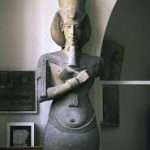 Analogy?..."To recite the Iliad, from the anger of Achilles in the opening lines, to the close when Hector's body is taken back to Troy, takes some 24 hours - rather longer with dramatic embellishments. Committing the epic's more than 150,000 words to memory would be a formidable task even with the aid of the features described by Perry. It is hardly surprising that the mother of the Muses in Greek myth was said to be Mnemosyne - memory - from whose name the word 'mnemonics' is derived for the aid of memory training...It is
Analogy?..."To recite the Iliad, from the anger of Achilles in the opening lines, to the close when Hector's body is taken back to Troy, takes some 24 hours - rather longer with dramatic embellishments. Committing the epic's more than 150,000 words to memory would be a formidable task even with the aid of the features described by Perry. It is hardly surprising that the mother of the Muses in Greek myth was said to be Mnemosyne - memory - from whose name the word 'mnemonics' is derived for the aid of memory training...It is
unlikely ever to be known exactly what techniques were used by the Homeric bards not only to remember the Iliad but also more than 115,000 words of the Odyssey...The poet Simonides of...
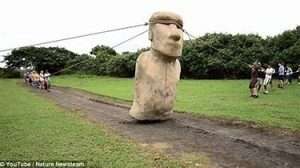
'Bellies' full of something?
….Ceos is said to have believed that memory could be assisted by assigning striking images to the data to be remembered and then placing them in the rooms of an imaginary house. By letting the mind wander through these 'rooms' when required, the images and the knowledge associated with them could be recalled." ['Homer's Secret Iliad' / F. and K. Wood]. Among others try ''house'' and/or ''15'' - until then...
'Twentythree' X 'five' = 115.
''Service to others is the rent you pay for your room in heaven.'' {Muhammad Ali: 1942-2016}.
Refresher: "The Kingdom of Heaven is within you. The time has come for external forms and expressions to be left behind. There is no Temple in the heavenly Jerusalem, for religion has no place in heaven. Man is his own temple,[key] and his heart is the altar." Enlarged elsewhere.
'A river of thoughts'.
Christian equivalent = Assumption day = 15th of the 8th. [Two 'symbolic' numbers]. Or the 15 or 16 steps leading down to the tomb of the 'Golden Child'. Enlarged elsewhere. Therefore the same could be said in reverse,i.e., in order to reach the 'light of day'. A 'dawning' of something.
Side note: Paraquay's capital city is named after the Christian Feast of Assumption.'' ['The Chase'].
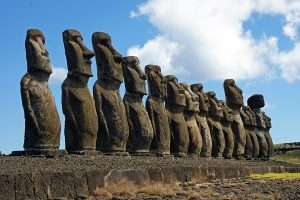
'15' in number.
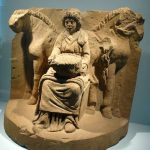
90/180?
"Fifteen represents the zenith of 'lunar' power, and its relation to the moon can be deduced from the name of an old German measure called Mandel, - 'a little moon, part of a moon', which consisted of 15 items such as eggs and other small things..." [Taken from the book 'Mystery of Numbers'. Mentioned elsewhere].
Segment?
'Little boot'?
Side note: {synchronicity?}: "The highest mountain in the world was called ''Peak 15'' before it was named Everest."
El Qurn?
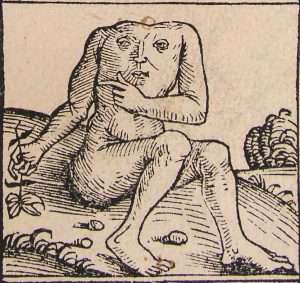
Thinking from the Heart? Rising or setting sun? Giving directions?
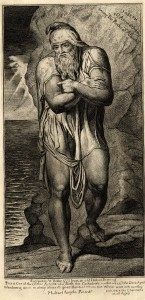 From a different perspective: A Spanish team excavating at the Graeco-Roman port of Berenike in the Eastern Desert, find ''an unusual shrine containing 15 headless falcons. The falcons were buried alongside eggs - a practise not known anywhere else in Egypt. The temple shrine also contained inscriptions describing previously unknown rituals, and a stela warning: 'It is improper to boil a head in here,' forbidding people to carry out impure activities {'spotless'} within the shrine area. The discovery dates to the Late Roman Period - when the city was occupied by a nomadic people known as the Blemmyes, who adopted the small traditional Egyptian temple to fit their own religious beliefs.'' [Page 9 'Ancient Egypt Magazine' / January/February 2023].
From a different perspective: A Spanish team excavating at the Graeco-Roman port of Berenike in the Eastern Desert, find ''an unusual shrine containing 15 headless falcons. The falcons were buried alongside eggs - a practise not known anywhere else in Egypt. The temple shrine also contained inscriptions describing previously unknown rituals, and a stela warning: 'It is improper to boil a head in here,' forbidding people to carry out impure activities {'spotless'} within the shrine area. The discovery dates to the Late Roman Period - when the city was occupied by a nomadic people known as the Blemmyes, who adopted the small traditional Egyptian temple to fit their own religious beliefs.'' [Page 9 'Ancient Egypt Magazine' / January/February 2023].
Various etymologies had been proposed for the origins of the name "Blemmyes", and the question is considered unsettled.
And/or:
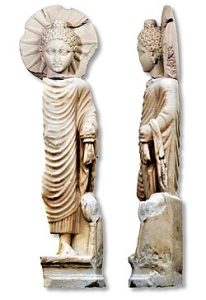
Found in Berenike.
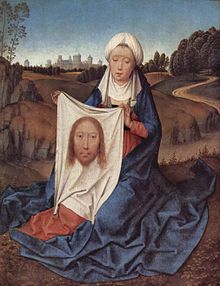 Saint Veronica, also known as Berenike,[3] was a widow from Jerusalem who lived in the 1st century AD, according to extra-biblical Christian sacred tradition.[4] A celebrated saint in many pious Christian countries, the 17th-century Acta Sanctorum published by the Bollandists listed her feast under July 12,[5] but the German Jesuit scholar Joseph Braun cited her commemoration in Festi Marianni on 13 January.
Saint Veronica, also known as Berenike,[3] was a widow from Jerusalem who lived in the 1st century AD, according to extra-biblical Christian sacred tradition.[4] A celebrated saint in many pious Christian countries, the 17th-century Acta Sanctorum published by the Bollandists listed her feast under July 12,[5] but the German Jesuit scholar Joseph Braun cited her commemoration in Festi Marianni on 13 January.
According to Church tradition, Veronica was moved with sympathy seeing Jesus carrying the cross to Calvary and gave him her veil so that he could wipe his forehead. Jesus accepted the offer, and when he returned the veil the image of his face was miraculously captured on it. The resulting relic became known as the Veil of Veronica.[6][7][8]The story of Veronica is celebrated in the sixth Station of the Cross in Anglican, Catholic, and Western Orthodox churches.[4][9][10]
 Veronica’s name is likely a Latinisation of Berenice, a name of Greek origin, meaning “bearer of victory”. Some have speculated that her name could be a fusion of Latin and Greek words for “true icon” (Latin: vera & Greek: icon).
Veronica’s name is likely a Latinisation of Berenice, a name of Greek origin, meaning “bearer of victory”. Some have speculated that her name could be a fusion of Latin and Greek words for “true icon” (Latin: vera & Greek: icon).
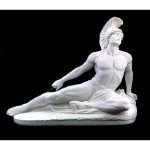
The death of Achilles.
This linguistic amalgamation would symbolically underscore the authenticity of Veronica’s veil, distinguishing it from other similar religious relics, like those preserved in Milan.
Today, Veronica’s veil is still safeguarded in St. Peter’s, serving as a timeless reminder of her act of kindness. This event is solemnly remembered in the Stations of the Cross ritual.
Side note: The Temple of Athena Nike was constructed between 427 and 424 BCE, during a period of Athenian prosperity known as the Golden Age. This era was marked by the influence of Pericles, who championed the arts and democracy, as well as the expansion of the Athenian empire through military conquests.
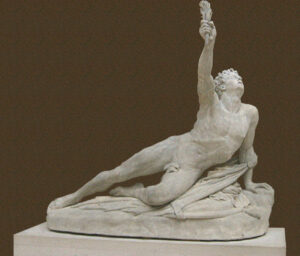

Chryselephantine statues were built around a wooden frame with thin carved slabs of ivory attached, representing the flesh, and sheets of gold leaf representing the garments, armour, hair, and other details. In some cases, glass paste, glass, and precious and semi-precious stones were used for detail such as eyes, jewellery, and weaponry.
During the 5th century BCE, Athens was engaged in the Peloponnesian War against Sparta, a conflict that would ultimately shape its political landscape. The construction of the temple was not merely an architectural endeavor; it was a reflection of the city’s aspirations and its desire to commemorate victories. Athena Nike, the goddess of victory, played a crucial role in Athenian society, symbolizing not only military success but also the triumph of democracy against tyranny. The Temple of Athena Nike is a prime example of the Ionic architectural style, characterized by its slender columns and elegant proportions. The temple measures approximately eight by eighteen feet and features a four-columned portico on its façade, showcasing the grace and sophistication of Ionic design.

Goddess Nike. Common factors? Higher/lower?
Athena Nike was worshipped as a powerful deity who granted victory in both warfare and athletic competitions. Her significance in Athenian religion is underscored by various worship practices and rituals dedicated to her.
AND/OR: Know, my son, that in the hen’s egg is the greatest proximity and relationship in nature; for in it there is a spirituality and conjunction of elements, and an earth which is golden in its tincture.....For the work begins from the vegetable, next from the animal, as in the egg of the hen, in which is the great support; and our earth is gold, of all which we make seriacum, which is the ferment Ixir.....The egg of the philosophers refers to the aura, the ovoid emanation exuding from and surrounding the astro-mental form. It is this shape which is the subject of the work. When brought to fulfilment, it glows and scintillates most brilliantly like some more than precious gem. ['The Philosophers Stone'].

Side note: ''Pliny is hardly a trustworthy source when it comes to descriptions of remote tribes. Let's remember, he told us that the Blemmyis, who lived in the Sahara, had eyes and mouths in their chests. And there were dog headed people living in North Africa.'' [Page 190 'The Celts' / A. Roberts].
Question. Was Pliny a member of any 'Mystery' club?
Followers of Anubis?
"Anubis (/əˈnjuːbɪs/;[2] Ancient Greek: Ἄνουβις), also known as Inpu, Inpw, Jnpw, or Anpu in Ancient Egyptian (Coptic: ⲁⲛⲟⲩⲡ, romanized: Anoup), is the god of funerary rites, protector of graves, and guide to the underworld, in ancient Egyptian religion, usually depicted as a canine or a man with a canine head."

Unusual ''religious beliefs'' or a universal mind set? 'Peak' experience? Going West?
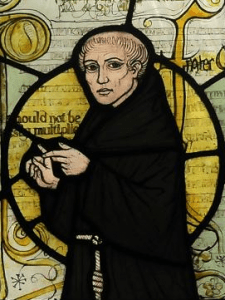
Whats the common factor between all three?
Continued: In antiquity, the actual tribe known as the Blemmyes were said to be named eponymously after King Blemys (Βλέμυς), according to Nonnus's 5th century epic Dionysiaca, but no lore about headlessness is attached to the people in this work.[2][3] Samuel Bochart of the 17th century derived the word Blemmyes from the Hebrew bly (בלי) "without" and moach (מוח) "brain", implying that the Blemmyes were people without brains (although not necessarily without heads).[4][5] A Greek derivation from blemma (Greek: βλέμμα) "look, glance" and muō (Greek: μύω) "close the eyes" has also been suggested.[6] Wolfgang Helck claimed a Coptic word "blind" for its etymology....The first indirect reference to the Blemmyes occurs in Herodotus, Histories, where he calls them the akephaloi (Greek: ἀκέφαλοι "without a head").[12] The headless akephaloi, the dog-headed cynocephali, "and the wild men and women, besides many other creatures not fabulous" dwelled in the eastern edge of ancient Libya, according to Herodotus's Libyan sources. Leo Reinisch in 1895 proposed that it derived from bálami "desert people" in the Bedauye tongue (Beja language). Although this theory had long been neglected,[8] this etymology has come into acceptance, alongside the identification of the Beja people as true descendants of the Blemmyes of yore.''
''Headless'' to enlarge.
'On Having No Head: Zen and the Rediscovery of the Obvious' / D. E. Harding.
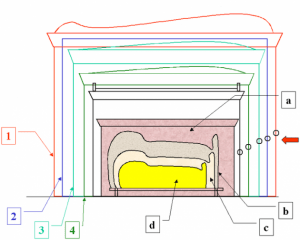
A gathering.
A working example: ''Each day begins at six oclock, and each hour rises for a particular god or goddess, the KEYNOTE being struck in the very first hour called 'She who raises the Beauty of her lord'. This is the hour rising for the wisdom goddess, Maat, whom the king brings into the sun boat to guide the journey, proclaiming right at the outset his desire to establish HER way. All is veiled, however, in the secret region of the eastern lightland, where Re is still a gestating child, not yet born and still embraced by his 'mother,' a nourishing serpent mother no less, whose seven uraeus snakes {'kundalini'?} gather together his Ka power...In the Book of Day's first hour - beneath Nut's vulva - depicts the sun god within his mothers womb, which is shaped like a huge sun disk {'meridian' of the sun?}. Almost to small to see, located high on the tomb ceiling.....called the ''little Re''....'' [Page 19/20 'Hathors Alchemy: Egyptian Roots of the Hermetic Art' / A. Roberts].
''Little boot''?

'Spirit' or 'Soul'? Male or female feet.

Cenacle = N/W corner.
And/or: "Cenacle: This is the place of the last supper. Where the Holy Spirit came down upon the Apostles at Pentecost, and where the first priests were ordained back in the Last Supper, where the Lord washed their feet. So much happened here - it is the place where he appeared to them when he was risen from the dead....came through the very walls. The longest prayer {John seventeen} is the Hour of Jesus - rightly called the Priestly Prayer - It sums up the whole economy of salvation and creation. It fulfils the great petitions of the 'Our Father'. So what is his hour? 'My hour has not yet come', he said to his mother in Cana of Galilee. But he spoke about his hour right here in the hour of his passion. The hour of salvations history. So he prayed to the father in this hour." [Day thirtyfive: Sacrificial Prayer / Cenacle-Jerusalem / Pilgrimage - lent 2024 ].
- Cana is best known for being the place where Jesus performed “the first of his signs,” turning water into wine at a wedding feast (John 2:1–11).
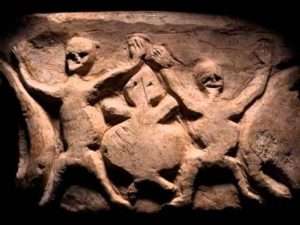
Tortoise or turtle? ''Raised hands'' = 'Wet' or 'Dry'? As a means....?
And/or: The Priestly Blessing or priestly benediction (Hebrew: ברכת כהנים; translit. birkat kohanim), also known in rabbinic literature as raising of the hands (Hebrew nesiat kapayim),[1] rising to the platform (Hebrew aliyah ledukhan),[2] dukhenen (Yiddish from the Hebrew word dukhan – platform – because the blessing is given from a raised rostrum), or duchening,[3] is a Hebrew prayer recited by Kohanim (the Hebrew Priests, descendants of Aaron). The text of the blessing is found in Numbers 6:23–27.
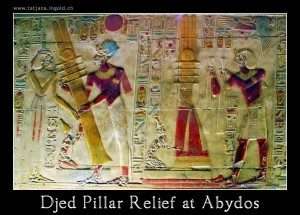
''Raising''? 'Ka'?
According to the Torah,[4] Aaron blessed the people,[5] and YHWH[6] promises that "They (the Priests) will place my name on the Children of Israel (the Priests will bless the people), and I will bless them". The Chazal stressed that although the priests are the ones carrying out the blessing, it is not them or the ceremonial practice of raising their hands that results in the blessing, but rather it is God's desire that the blessing should be symbolised by the Kohanim's hands.
Even after the destruction of the Second Temple, the practice has been continued in Jewish synagogues, and today in most Jewish communities, Kohanim bless the worshippers in the synagogue during shacharit prayer services.[citation needed]
'Barber' to enlarge.
Comb?

In the early centuries, baptism involved total immersion, which is why the nude woman is standing in such a huge vat.’® The waves of water on the floor are not pouring from the vat, as you might expect — they are there merely to indicate that St John the Baptist is symbolically standing in the River Jordan. This scene shows the lady with her arms raised, in precisely the same Etheric _ gesture we noted a little earlier. St John is shown reading from a book — possibly he is reading the baptismal rites — while he touches the woman’s bowed head with his right hand. This, as I might hardly point out, is an initiation scene.
A working example: ''Leo Minor is a small and faint constellation in the northern celestial hemisphere. Its name is Latin for "the smaller lion", in contrast to Leo, the larger lion. It lies between the larger and more recognizable Ursa Major to the north and Leo to the south. Leo Minor was not regarded as a separate constellation by classical astronomers; it was designated by Johannes Hevelius in 1687...The lion's mane and shoulders also form an asterism known as "The Sickle," which to modern observers may resemble a backwards "question mark."

64 objective aspects?
''Onwards the sun boat travels, towards the beckoning ARMS of Nut, the encompassing maternal embrace to which safely return at the close of day. Now, in the eleventh hour called ''Beautiful to behold,'' and rising for the ''Adjuster of the Tow Rope,'' the shapeshifting Re becomes the ageing god Atum, praised as 'Lord of the Fesivals of the Sixth Day and the Fifteen{th} Day....When Thoth completes his healing of the Lunar Eye.'' [Page 32 'Hathors Alchemy'].
Cable wire?
Side note: Why she is lifting her arms, grasping at her hair. This is the gesture of the Etheric soul.*® The same gesture is found in the Christian images painted and scratched on the walls of the catacombs, in Rome (see bottom figure on page 332), and has been called the “orans”, or praying gesture. In fact, such images are derived from the Egyptian hieroglyphic for the ka:
 “These hints leave us in no doubt that the sinning woman is alive, and that we are being privileged to look into the state of her Etheric body. This, Maria, is an example of the use of an occult blind. Now, turn your attention to the second engraving of the Moissac sculpture (see page 77). The person gifted with clairvoyant vision will see the beggar approaching the miser on the Astral plane. He will see the demons directing this transaction: the demons are, so to speak, bypassing the Ego of the men. This is no human transaction, but a demonic one. The demons sit above the heads of the men to show that they are gripping on to their Egos. Do not forget that our word possession is derived from a Latin word meaning literally “sitting on”.
“These hints leave us in no doubt that the sinning woman is alive, and that we are being privileged to look into the state of her Etheric body. This, Maria, is an example of the use of an occult blind. Now, turn your attention to the second engraving of the Moissac sculpture (see page 77). The person gifted with clairvoyant vision will see the beggar approaching the miser on the Astral plane. He will see the demons directing this transaction: the demons are, so to speak, bypassing the Ego of the men. This is no human transaction, but a demonic one. The demons sit above the heads of the men to show that they are gripping on to their Egos. Do not forget that our word possession is derived from a Latin word meaning literally “sitting on”.
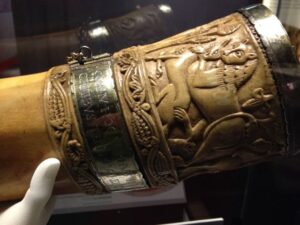
'Gripping' in a different form.
PAN?

“Most certainly, I tell you, one who doesn’t enter by the door into the sheep fold, but climbs up some other way, is a thief and a robber."
When, in the Lord’s Prayer, we ask not to be led into temptation, we are requesting that we find sufficient strength within our Ego to resist the darkness constantly been laid upon our Astral bodies by demons, and other temptations. ‘Now, in contrast to the nakedness of the libertine woman, the miser and the beggar are clothed. This may be explained in terms of the need to indicate their ranks — the beggar is in torn clothing, with only one trouser leg. We may judge from the clothing of the seated man that he is a person of some substance. However, there is another reason why the pair are clothed: this covering indicates that they are being depicted on the next level up from the Etheric — that is, on the Astral plane — on what in the days when this sculpture was made would have been called the animalis, or the ens-astrale.‘
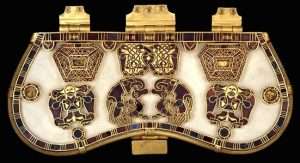
Heavy or light. Neck or waist?

Socrates?
We may have little doubt that the clothing is meant as a kind of Astral mask, for neither man wears shoes. This is an arcane technique for showing that neither is standing on the physical Earth. The most “Earthy” element in this portrayal is the heavy money-bag: this appears to be tied around his neck, as a punishment, weighing down his soul. This moneybag performs the same symbolizing function as the bag over the shoulder of the Fool in the Tarot card. {'The Zelator'}.
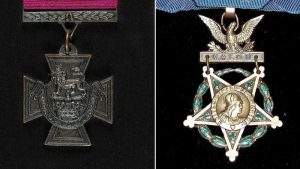
'Five' pointed.

Common factors?
And/or: ''Khonsu is a lunar god, closely connected to Thoth....Whereas Thoth is explicit in his fullness ...through light....Khonsu represents the occluded side of the moon in all its phases...In one hymn to Khonsu he is said to be conceived on the day of the new moon, born head down into the moon's crescent, and becomes an old man on the 15th day....His name means ''wanderer or traveller'' and/or ''guardian of foreigners''......'' [Page 70 'The Union of Isis and Thoth'].
'Afar'?
Recall the UPSIDE DOWN staues of Khafre- found purposely in pits - in the Sphinx Temple.
Northern/Southern Hemisphere?

'Birthing' bricks.
''Twentytwo'' to enlarge.
And/or: ''In the Christian tradition it is the twentyfifth of March that is the date that Mary was told she would give birth to Jesus.''
Head first?
Working example: ''We have briefly met Kiya, the other known wife of Akhenaten, noting that she held a title, Greatly Beloved Wife of the King, that appears never to have been borne by any other individual in Egyptian history. Her origins are wholly unknown, although, like Nefertiti, there have been speculations that she might have been a foreigner....'' [Page 50 'Nefertiti' / A. Dodson].
Question. Which sounds the 'greater' title: The ''beautiful lady has come'' OR ''greatly beloved''?
Question 2. Who was Greatly Beloved in the Hebrew culture?
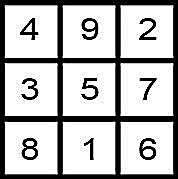
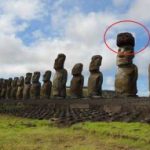
'15'?
Refresher: ''Fifteen represents the zenith of lunar power, and its relation to the moon can be deduced from the name of an old German measure called Mandel, 'little moon, part of a moon', which consisted of 15 items such as eggs or other small things....Sacred to Ishtar {'5'} + sum of first five integers as well as product of two sacred numbers {3x5} + quarter of 60 - highest number {of god} in Babylon culture...'' ['Mystery of Numbers'].
Venus? 8 beams?
Side note: ''The sun on Venus, rises in the West.'' ['The Chase' / 2018].
REFRESHER: ''One road leads inwards, to the maze at the heart of our inner castle, the other road, scattered with jewels and the remains of burnt out failures, leads to the world of every day toil and achievement. You are standing at that crossroads, and guilded by whatever steps you may have already taken on both of those ways, now you may go forward on your chosen path.'' [Final paragraph 'The Path Through the Labyrinth' / M. Green].
Upstream or Downstream?
Something extra: ''In the Pyramid Text, Utterance 402 {therefore 'six' in total}, the so called {according to traditional interpretation} Cannibal Hymn presents Khonsu as a blood thirsty god who eats the other gods and consumes their magic. In fact, we are what we eat. When we 'devour books' or give special attention to various gods we are consuming their 'knowledge'....Khonsu represents a communion with nature and the neters. We plant his 'flag' beneath the apple tree near the composted soil that is used for the garden.''
''We are what we eat'' Try ''taste'' {throughout} as a means?

'Six'?

'Inner soul'?
A work in progress?...AND/OR Coincidence or a meaningful one?..."The dream of a 45 year old psychotherapist may help to make clear how the anima can be an inner guide. As he was going to bed on the evening before he had this dream, he thought to himself that it was hard to stand alone in life, lacking the support of a church. He found himself envying people who are protected by the maternal embrace of an organization. {He had been born a Protestant but no longer had any religious affiliation}. This was his dream :- I am in the aisle of an old church filled with people. Together with my mother and my wife. I sit at the end of the aisle in what seem to be extra seats. I am to celebrate the Mass as a priest, and i have a big Mass book in my hands, or, rather, a prayer book or an anthology of poems. This book is not familiar to me, and i cannot find the right text. I am very excited because i have to begin soon, and to add to my troubles, my mother and wife disturb me by chattering about unimportant trifles. Now the organ stops, and everybody is waiting for me, so i get up in a determined way and ask one of the nuns who is kneeling behind me to hand me her Mass book and point out the right place - which she does in an obliging manner. Now, like a sort of sexton, this same nun precedes me to the altar, which is somewhere behind me and to the left,{in profile?} as if we are approaching it from a side aisle.
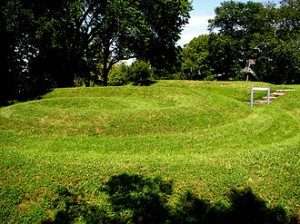
'Snake/Dragon head' on land. 'tail' in the sea.
The Mass book is like a sheet of pictures, a sort of board, three feet long and a foot wide, and on it is the text with ancient pictures in columns,{cuneiform link?} one beside the other. First the nun has to read a part of the liturgy before i begin, and i still have not found the right place in the text. She has told me that it is number 15, but the numbers are not clear, and i cannot find it. With determination however, i turn toward the congregation,{'face on' instead of 'in profile'?} and now i have found number 15 {the next to the last on the board.....
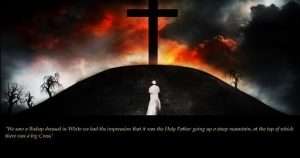
Therefore 16 in total}, although i do not yet know if i will be able to decipher it. I want to try all the same - i wake up. THIS dream expressed in a symbolic way an answer from the unconscious to the thoughts that the dreamer had had the evening before. It had said to him, in effect: ''You yourself, must become a priest in your own inner church - in the church of your soul." [ 'Man and his Symbols' / C. Jung. All emphasis, this readers - with the exception of text underlined].
Barber?
REFRESHER: "The Kingdom of Heaven is within you. The time has come for external forms and expressions to be left behind. There is no Temple in the heavenly Jerusalem, for religion has no place in heaven. Man is his own temple,[key] and his heart is the altar.[key]"

'Snake head OVER the back of the head?

A ''meeting'' in the middle - Of the forehead? Master of conflict and/or 'struggle'?
Side note. ''Sixteen'' in relation to..."In this dream the anima appears in her proper positive role - that is, as a mediator between the ego and the self. The 4x4 configuration of the pictures points to the fact that the celebration of this inner Mass is performed in the service of totality. As Jung has demonstrated, the nucleus of the psyche {the Self} normally expresses itself in some kind of fourfold structure. The number four is also connected to the anima because, as Jung noted, there are four stages in its development. The first stage is best symbolised..." Same book.
''FOUR is called OUT when someone is in the 'line of sight' of a golf ball.''
'So close yet so far AWAY.'
AFAR?
And/or: ''In golf, the Masters Tournament is played over four days.''
Coincidence or a meaningful one?
'Hathor' to enlarge one way or the other.
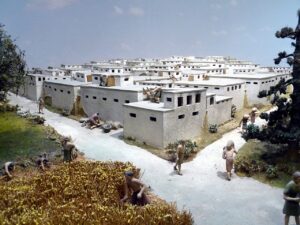
Looking in or out? Lozenge shape artwork found on the walls at Catal Hoyuk.The site was first excavated by James Mellaart in 1958. Believed it to be a Mother Goddess religion. Not verified by others. Enlarged throughout!

Red thread?
From a different perspective: "Like pile carpets, kilim have been produced since ancient times. The explorer Mark Aurel Stein found kilims dating to at least the fourth or fifth century CE in Hotan, China:
- "As kilims are much less durable than rugs that have a pile to protect the warp and weft, it is not surprising that few of great age remain.... The weave is almost identical with that of modern kilims, and has about fourteen threads of warp and sixteen threads of weft to the inch. The pattern consists of narrow stripes of blue, green, brownish yellow, and red, containing very small geometric designs. With this one exception, so peculiarly preserved, there are probably very few over a century old."[3]
- Spinning wheel V Fire wheel.

Any paisley?
 And/or {i.e.,expressed in a different form}: "In order to understand what man is at the present time, that is, at the present level of development, it is necessary to imagine to a certain extent what he can be, that is, what he can attain. Only by understanding the correct sequence of development possible will people cease to ascribe to themselves what, at present, they do not possess, and what, perhaps, they can only acquire after great effort and labour. According to ancient teaching, traces of which may be found in many systems, old and new, a man who has attained the full development possible for man, consists of four bodies. These four bodies are composed of substances which gradually become finer and finer, mutually interpenetrate one another, and form 'four' independent organisms, standing in a definite relationship to one another but capable of independent action. The reason why it is possible for four bodies to exist is that the human organism, that is, the physical body, has such a complex organism that, under certain conditions, a new independent organism can grow in it, affording a much more convenient and responsive instrument for the activity of consciousness than the physical body. The consciousness manifested in this new body is capable of governing it, and it has full power and full control over the physical body..." [ 'In Search of the Miraculous'].
And/or {i.e.,expressed in a different form}: "In order to understand what man is at the present time, that is, at the present level of development, it is necessary to imagine to a certain extent what he can be, that is, what he can attain. Only by understanding the correct sequence of development possible will people cease to ascribe to themselves what, at present, they do not possess, and what, perhaps, they can only acquire after great effort and labour. According to ancient teaching, traces of which may be found in many systems, old and new, a man who has attained the full development possible for man, consists of four bodies. These four bodies are composed of substances which gradually become finer and finer, mutually interpenetrate one another, and form 'four' independent organisms, standing in a definite relationship to one another but capable of independent action. The reason why it is possible for four bodies to exist is that the human organism, that is, the physical body, has such a complex organism that, under certain conditions, a new independent organism can grow in it, affording a much more convenient and responsive instrument for the activity of consciousness than the physical body. The consciousness manifested in this new body is capable of governing it, and it has full power and full control over the physical body..." [ 'In Search of the Miraculous'].
Before those first impressions {suggest?} something else; think about it {especially the highlighted parts} in relation to that universal ''divine bit'' - before those two BIGGER questions are asked.
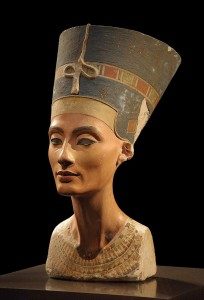
Left eye purposely opaque? Short sighted?
Continued...

Bush Barrow 'lozenge' . "Three and four."
As seen from a different 'perspective'..."The number 15 has already occurred several times and is related to the rotation of the Earth on its axis, where it takes twenty four divisions of 15 degrees to complete one revolution, what we currently define as one hour of time. It is also significant that the moon is always full on the 15th day of its cycle, the midpoint of the lunar calendar used to govern religious affairs. If Solomon's Temple was based on knowledge of the natural world and the perceived wisdom that existed at the time, then one would expect this reference to 120 cubits {i.e.,height of 'Temple' } to have some link to that understanding. Not surprisingly there is such evidence. It just so happens that all the integers in the range 1 to 15, when added together, make a total of 120. What is more, these numbers fit into an arithmetical pattern known as triangular numbers. These integers produce some interesting characteristics.

Isle of Wight flag. Lozenge?
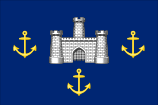
Council flag.
For example, if all the odd numbers are added together, they make sixtyfour {64}. If we now add them together to produce intervening subtotals, we get the squares of the consecutive integers...So what could the number 120 relate to? Old testament text implies the word 'oracle' is associated with the holy of holies, which as we know is a cube measuring... " [From the book by K. Gest. Emphasis, this readers]. Amongst others try '120' ; '64' ; 'triangular / triangle' / ''twice as high as broad'' etc.
The author attempting to understand his 'own relationship' by way of his 'chosen path' - that of Freemasonry. Which all candidates are expected to.
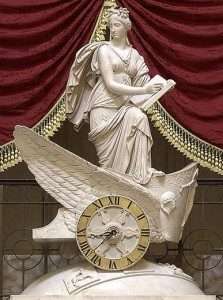
What about 'twentythree' minutes to nine?
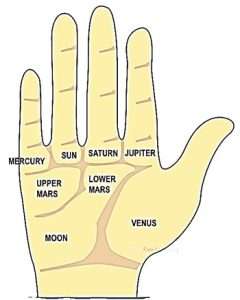
''The little finger is sometimes referred to as a pinky.'' What about the 'thumb'?
''An obtuse angle of 120 degrees is formed between the hour hand and the minute hand when the time is four o'clock.'' ['Impossible' / S6 EP45].
Side note: ''Wayne Rooney came out of international retirement to play a friendly against the USA at Wembley in November 2018 - to earn his 120{th} cap.'' ['Impossible'].
And/or: In the context of darts, a “Shanghai” is a specific scoring achievement that involves hitting three different sections of a single number: the single, the double, and the triple. For instance, if you’re targeting the number 20, a Shanghai would involve hitting the single 20, the double 20 (40), and the triple 20 (60) in one turn, achieving a total score of 120 points....
The term “Shanghai” is believed to have originated from the sailors and soldiers who played darts in pubs during their time off. The exact reason for calling it “Shanghai” is a subject of speculation.....
Hitting or missing the 'Mark'?
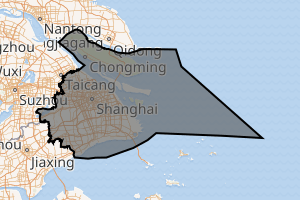
"East is a begining, west its ending." Peninsula?

Journeyman?
Some believe it refers to the element of surprise and skill involved, much like the 19th-century practice of “Shanghaiing” sailors into service. Others consider it a reference to the exotic and varied nature of the Chinese port city of Shanghai, similar to the need for a varied skill set to hit the three different parts of a single number in darts.....
I believe the reason why Shanghai may be used is because Shanghai is divided into 3 counties and 16 districts. The 3 counties are Fengxian, Nanhui and Chongming. The 16 districts are Hangpu, Luwan, Changning, Putuo, Hongkou, Minhang, Jiading, Jinshan, Songjiang, Qingpu, Nanshi, Xuhui, Jing'an, Zhabei, Yangpu, Baoshan, and Pudong New Area.
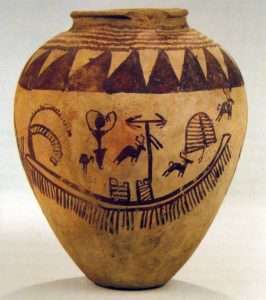
Above or below the horizon? And/or: The Rump is part of the Arabian megaconstellation of the Lion (al-asad). It lies well south of the rest of the Lion, so it may have been a later addition to the figure.
The two Chinese characters in the city's name are 上 (shàng/zaon, "upon") and 海 (hǎi/hé, "sea"), together meaning "On the Sea". The earliest occurrence of this name dates from the 11th-century Song dynasty, when there was already a river confluence and a town with this name in the area....
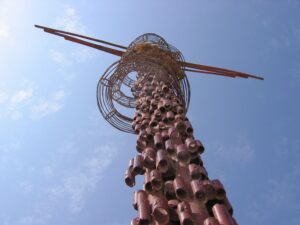
Mount Nebo. E-W?
Others contend that the city is referenced in historical records dating back 2150 years, and that its ancient name, "Hu", suggests it was previously a fishing village. In 1280 it was renamed "Shanghai", which translates to "Above the Sea".[16] How the name should be understood has been disputed, but Chinese historians have concluded that during the Tang dynasty, the area of modern-day Shanghai was under sea level, so the land appeared to be literally "on the sea".[17]
Shanghai is officially abbreviated 沪[b] (Hù/wu) in Chinese, a contraction of 沪渎[c] (Hù Dú/wu-doq, "Harpoon Ditch"), a 4th- or 5th-century Jin name for the mouth of Suzhou Creek when it was the main conduit into the ocean.[20] This character appears on all motor vehicle license plates issued in the municipality today.[21]
申 (Shēn/sén) or 申城 (Shēnchéng/sén-zen, "Shen City") was an early name originating from Lord Chunshen, a 3rd-century BC nobleman and prime minister of the state of Chu, whose fief included modern Shanghai.[20] Shanghai-based sports teams and newspapers often use Shen in their names, such as Shanghai Shenhua and Shen Bao.
And/or: ''At the beginning of Henry VIII's reign in 1509, there were three different coins used as currency. The coins and their value were roughly as follows: silver penny, the lowest; a silver groat (worth four pennies/pence); gold angel (worth 120 pence/10 shillings); and gold half-angel (worth 60 pence/10 shillings).
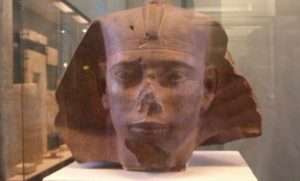
He is the king who introduced the royal title Sa-Rê (meaning “Son of Ra”) and the first to connect his cartouche name with the sun god Ra.
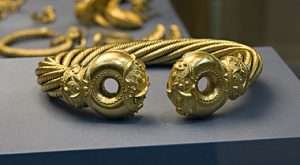
Eight strands each. Sixtyfour in total.
The Great Debasement (1544–1551) was a currency debasement policy introduced in 1544 England under the order of Henry VIII which saw the amount of precious metal in gold and silver coins reduced and in some cases replaced entirely with cheaper base metals such as copper. He became known as 'Old Coppernose'....'' [Wiki].
And/or: ''Twentyfour is the number of totality, since it is connected to the twentyfour hours of the day and night - although in antiquity the day was counted in 12 double hours of 120 minutes each - and in nautical reckoning, the glass, equalling 30 minutes measured by the hour glass, was maintained till recently. 24 also appears as a measurement: the ancient German Elle, or yard, consisted of 24 finger's' breadth.'' [Page 235 'Mystery of Numbers' / A. Schimmel].
Anglo Saxons?
And/or: ''Sing a song of sixpence, pocket full of rye. Four and twenty blackbirds baked in a pie.''
A {working?} example..."The popular notion that pirates were nothing more than illiterates who sported peg legs and eye patches is largely an illusion. Some like Francis Drake were high nobles. Others like Henry Morgan and Captain Kidd were highly intelligent sailors and shrewd business people. Just as sophisticated were many members of crew. Doctors, masons, carpenters and experts in most professions." ['Curse of Oak Island' / Dec.2016].
Musicians?

The earliest reference to the word "lyre" is the Mycenaean Greek ru-ra-ta-e, meaning "lyrists" and written in the Linear B script. In classical Greek, the word "lyre" could either refer specifically to an amateur instrument, which is a smaller version of the professional cithara and eastern-Aegean barbiton, or "lyre" can refer generally to all three instruments as a family.[2] The English word comes via Latin from the Greek
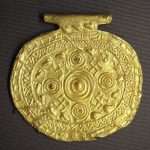
Plucked Duck?
''On a stringed instrument, staccato articulation involves short bow strikes that typically alternate between downbow and upbow strokes. The pizzicato technique of playing with fingers naturally lends itself to staccato....Pizzicato” translates roughly as “plucked”, or “pinched”. The result is a short, slightly muted sound, much like a jazz “walking bass”. Instruments using a bow (violin, cello, etc.) may use the end of their bow to pluck the strings for this effect.''
''Staccato ([stakˈkaːto]; Italian for "detached") is a form of musical articulation. In modern notation, it signifies a note of shortened duration,[1][2] separated from the note that may follow by silence.[3] It has been described by theorists and has appeared in music since at least 1676.''
''Staccato means played with a short GAP between each notes.'' ['Impossible' / S4 EP21].
The opposite musical articulation of staccato is legato, signifying long and continuous notes.
REFRESHER: "The Kingdom of Heaven is within you. The time has come for external forms and expressions to be left behind. There is no Temple in the heavenly Jerusalem, for religion has no place in heaven. Man is his own temple,[key] and his heart is the altar.[key]" [First chapter, first page, first paragraph of the book 'The Mind of Christ: Meditations on Christian Themes' by Anthony Duncan].
Question. Dream analysis ONLY ?
